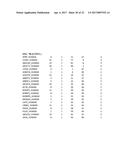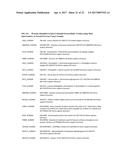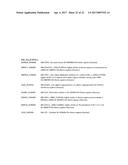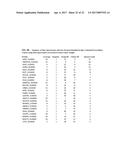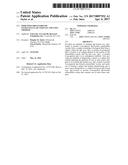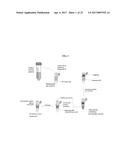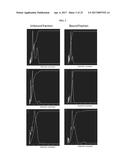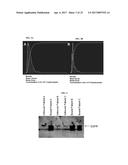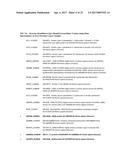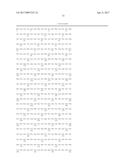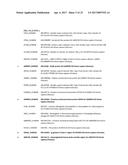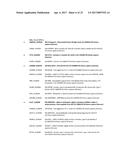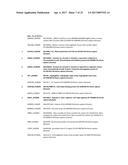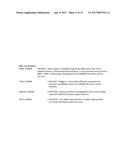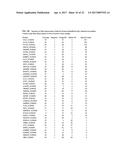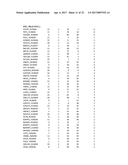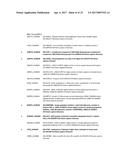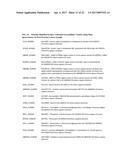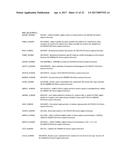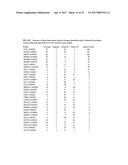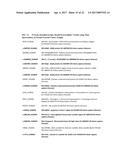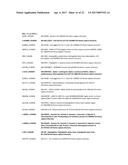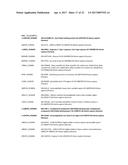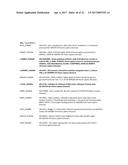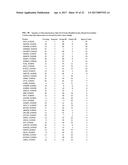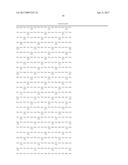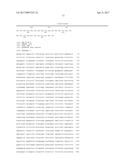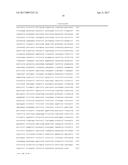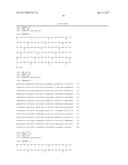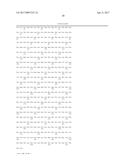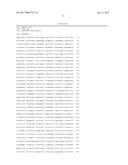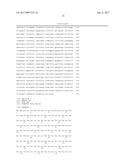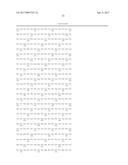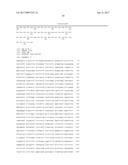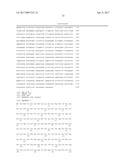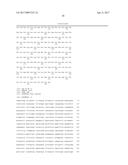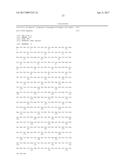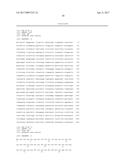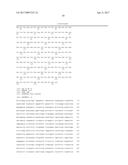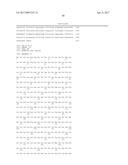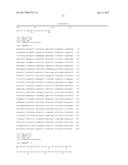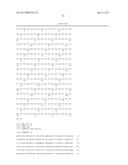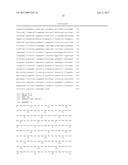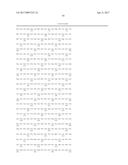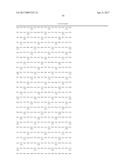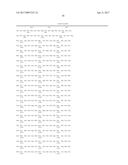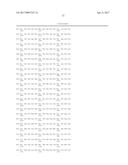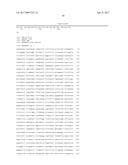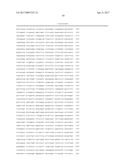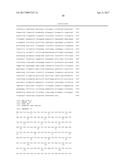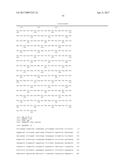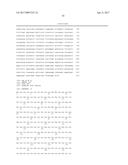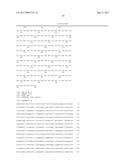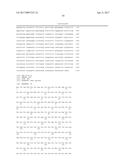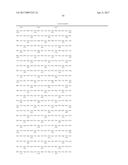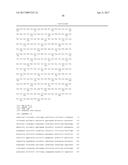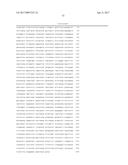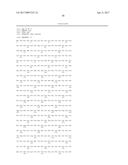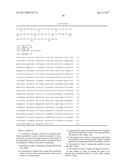Patent application title: IMMUNOGLOBULIN-BOUND EXTRACELLULAR VESICLES AND USES THEREOF
Inventors:
IPC8 Class: AG01N33574FI
USPC Class:
1 1
Class name:
Publication date: 2017-04-06
Patent application number: 20170097352
Abstract:
Provided are methods of isolating IgG-bound (e.g., IgG-bound or protein
G-recognized IgG-bound) extracellular vesicles from a sample containing a
biological fluid from a subject, where the IgG (e.g., IgG.sub.2 or
protein G-recognized IgG) is bound to an antigen present on the surface
of the extracellular vesicle and the IgG (e.g., IgG.sub.2 or protein
G-recognized IgG) is an endogenous antibody. Also provided are methods of
diagnosing a cancer in a subject that include detecting the presence of
one or more tumor antigens in an isolated IgG-bound (e.g.,
IgG.sub.2-bound or protein G-recognized IgG-bound) extracellular vesicle,
and methods of treating a subject that include administering one or more
cancer therapeutics to a subject having an IgG-bound (e.g.,
IgG.sub.2-bound or protein G-recognized IgG-bound) extracellular vesicle
that contains one or more tumor antigens.Claims:
1. A method of isolating a protein G-recognized IgG-bound extracellular
vesicle, wherein the protein G-recognized IgG is bound to an antigen
present on the surface of the extracellular vesicle and the protein
G-recognized IgG is an endogenous antibody, the method comprising: (a)
obtaining a sample comprising a biological fluid from the subject, (b)
contacting the sample with an agent that specifically binds to a heavy
chain constant domain of one or more protein G-recognized IgG, (c)
separating the agent bound with protein G-recognized IgG-bound
extracellular vesicles from unbound material present in the sample, and
(d) dissociating the protein G-recognized IgG-bound extracellular
vesicles from the agent, thereby isolating protein G-recognized IgG-bound
extracellular vesicles.
2. The method of claim 1, wherein the protein G-recognized IgG is IgG.sub.2.
3. The method of claim 1, wherein the agent is protein G.
4. The method of claim 1, wherein the agent is an antibody that specifically binds to a heavy chain constant domain of IgG.sub.2.
5. The method of claim 1, wherein the biological fluid is blood, serum, plasma, urine, cerebrospinal fluid, saliva, tears, nasal discharge, semen, amniotic fluid, vaginal discharge, lymph, tears, mucus, synovial fluid, breast milk, vitreous humor, aqueous humor, or sweat.
6. The method of claim 1, further comprising, before the contacting in (b), enriching the sample for extracellular vesicles by passing the sample through a molecular sieve column or a molecular weight filter.
7. The method of claim 1, further comprising (e) centrifuging the eluate to generate a pellet, and (f) resuspending the pellet in a physiologically acceptable buffer.
8. The method of claim 1, wherein the sample is obtained from a subject having or suspected of having a cancer.
9. The method of claim 8, wherein the cancer is bladder cancer, epithelial cancer, prostate cancer, anal cancer, appendix cancer, bone cancer, brain tumor, breast cancer, heart cancer, cervical cancer, colon cancer, gallbladder cancer, stomach cancer, head and neck cancer, liver cancer, kidney cancer, laryngeal cancer, lung cancer, ovarian cancer, pancreatic cancer, penile cancer, pituitary cancer, rectal cancer, salivary gland cancer, sarcoma, testicular cancer, throat cancer, thyroid cancer, urethral cancer, uterine cancer, vaginal cancer, or vulvar cancer.
10. The method of claim 1, wherein the subject is human.
11. The method of claim 1, wherein the protein G-recognized IgG-bound extracellular vesicle contains at least one tumor antigen.
12. The method of claim 11, wherein the at least one tumor antigen is selected from the group consisting of: epidermal growth factor receptor (EGFR), complement 7, cystatin-A, alpha-1-antitrypsin, monocyte/macrophage Ig-related receptor-10, annexin A1, annexin A2, arginase-1, complement component C4B-1, haptoglobin, serpin peptidase inhibitor, clade B (Ovalbumin), member 3, eukaryotic translation elongation factor 2, and cathepsin D.
13. A method of diagnosing a cancer in a subject, the method comprising: (a) obtaining a sample comprising a biological fluid from the subject; (b) isolating a protein G-recognized IgG-bound extracellular vesicle from the sample, wherein the protein G-recognized IgG-bound extracellular vesicle contains a protein G-recognized IgG bound to an antigen present on the surface of the extracellular vesicle and the protein G-recognized IgG bound to the extracellular vesicle is an endogenous antibody; and (c) detecting the presence of one or more tumor antigens in the isolated protein G-recognized IgG-bound extracellular vesicle; and (d) diagnosing a subject having an isolated protein G-regonized IgG-bound extracellular vesicle containing one or more tumor antigens as having a cancer.
14. The method of claim 13, wherein the protein G-recognized IgG is IgG.sub.2.
15. The method of claim 13, wherein the biological fluid is blood, serum, plasma, urine, cerebrospinal fluid, saliva, tears, nasal discharge, semen, amniotic fluid, vaginal discharge, lymph, tears, mucus, synovial fluid, breast milk, vitreous humor, aqueous humor, or sweat.
16. The method of claim 13, wherein in (d) a subject having a protein G-recognized-IgG-bound extracellular vesicle containing one of more tumor antigens selected from the group consisting of: epidermal growth factor receptor (EGFR), complement 7, cystatin-A, alpha-1-antitrypsin, monocyte/macrophage Ig-related receptor-10, annexin A1, annexin A2, arginase-1, complement component C4B-1, haptoglobin, serpin peptidase inhibitor, clade B (Ovalbumin), member 3, eukaryotic translation elongation factor 2, and cathepsin D is diagnosed with ovarian cancer.
17. The method of claim 13, wherein the isolating in (b) comprises contacting the sample with an agent that specifically binds to a heavy chain constant domain of IgG.sub.2.
18. The method of claim 17, wherein the agent is protein G.
19. The method of claim 17, wherein the agent is an antibody that specifically binds to the heavy chain constant domain of IgG.sub.2.
20. The method of claim 13, wherein the detecting in (c) is performed using mass spectrometry.
21. The method of claim 13, wherein the detecting in (c) is performed using two-dimensional gel electrophoresis.
22. The method of claim 13, wherein the detecting in (c) is performed using an exogenous antibody that specifically binds to a tumor antigen.
23. The method of claim 13, wherein the subject is a human.
24. The method of claim 13, further comprising administering to the subject diagnosed with cancer one or more cancer therapeutics.
25. A method of treating a subject, the method comprising selectively administering one or more cancer therapeutics to a subject that has been determined to have a protein G-recognized IgG-bound extracellular vesicle that contains one or more tumor antigens, wherein the protein G-recognized IgG-bound extracellular vesicle contains a protein G-recognized IgG bound to an antigen present on the surface of the extracellular vesicle and the protein G-recognized IgG bound to the extracellular vesicle is an endogenous antibody.
26. The method of claim 25, wherein the protein G-recognized IgG is IgG.sub.2.
27. The method of claim 25, wherein the subject has been determined to have a protein G-recognized IgG-bound extracellular vesicle that contains one or more tumor antigens selected from the group consisting of: epidermal growth factor receptor (EGFR), complement 7, cystatin-A, alpha-1-antitrypsin, monocyte/macrophage Ig-related receptor-10, annexin A1, annexin A2, arginase-1, complement component C4B-1, haptoglobin, serpin peptidase inhibitor, clade B (Ovalbumin), member 3, eukaryotic translation elongation factor 2, and cathepsin D.
28. The method of claim 25, wherein the one or more cancer therapeutic is an antimetabolite, an alkylating agent, interleukin-2, or a therapeutic antibody.
29. The method of claim 25, wherein the administering is performed by oral, intravenous, intraarterial, subcutaneous, intramuscular, intraperitoneal, or intrathecal administration.
30. A method of selecting a subject for participation in a clinical trial, the method comprising: (a) obtaining a sample comprising a biological fluid from a subject; (b) isolating a protein G-recognized IgG-bound extracellular vesicle from the sample, wherein the protein G-recognized IgG-bound extracellular vesicle contains a protein G-recognized IgG bound to an antigen present on the surface of the extracellular vesicle and the protein G-recognized IgG bound to the extracellular vesicle is an endogenous antibody; (c) detecting the presence of one or more tumor antigens in the isolated protein G-recognized IgG-bound extracellular vesicle; and (d) selecting a subject having isolated protein G-recognized IgG-bound extracellular vesicles containing one or more tumor antigens for participation in a clinical study.
31. The method of claim 30, wherein the protein G-recognized IgG is IgG.sub.2.
32. The method of claim 30, further comprising administering one or more cancer therapeutics to the subject during the clinical study.
33. The method of claim 30, wherein the biological fluid is blood, serum, plasma, urine, cerebrospinal fluid, saliva, tears, nasal discharge, semen, amniotic fluid, vaginal discharge, lymph, tears, mucus, synovial fluid, breast milk, vitreous humor, aqueous humor, or sweat.
34. The method of claim 30, wherein the isolating in (b) comprises contacting the sample with an agent that specifically binds to a heavy chain constant domain of IgG.sub.2.
35. The method of claim 34, wherein the agent is protein G.
36. The method of claim 34, wherein the agent is an antibody that specifically binds to the heavy chain constant domain of IgG.sub.2.
37. The method of claim 30, wherein the detecting in (c) is performed using mass spectrometry.
38. The method of claim 30, wherein the detecting in (c) is performed using two-dimensional gel electrophoresis.
39. The method of claim 30, wherein the detecting in (c) is performed using an exogenous antibody that specifically binds to a tumor antigen.
40. The method of claim 30, wherein the subject is a human.
Description:
CROSS-REFERENCE TO RELATED APPLICATIONS
[0001] This application is a continuation of U.S. patent application Ser. No. 13/795,708, filed Mar. 12, 2013, which claims priority to U.S. Provisional Patent Application Ser. No. 61/747,632, filed Dec. 31, 2012, the entire contents of each of which are incorporated by reference herein.
TECHNICAL FIELD
[0002] This invention relates to methods of diagnosing and treating cancer through the isolation of IgG-bound (e.g., IgG.sub.2-bound or protein G-recognized IgG-bound) extracellular vesicles and the identification of biomarkers of cancer in these isolated extracellular vesicles.
BACKGROUND
[0003] Cancer is associated with the induction of humoral immunity characterized by the generation of reactive IgG against a wide range of tumor antigens (Th2 response). The mechanisms underlying the induction of a humoral immune response to autologous protein antigens are multifaceted and include, for example, mutations, changes in post-translational modification(s), overexpression, ectopic expression, subcellular compartment translocations, splice variant products, or errors in proteolytic processing of certain proteins. Autoantibody responses to antigens broadly expressed in normal and cancer tissues appears to be attributable to tumor-specific mutations or post-translational modifications in proteins.
SUMMARY
[0004] The present invention is based, at least in part, on the discovery that IgG-bound (e.g., IgG.sub.2-bound or protein G-recognized IgG-bound) extracellular vesicles in cancer patients contain multiple tumor antigens. Thus, the present invention includes methods for isolating an IgG-bound (e.g., IgG.sub.2-bound or protein G-recognized IgG-bound) extracellular vesicle, and methods of diagnosing and/or differentiating a cancer in a subject and selecting a subject for participation in a clinical study that include isolating an IgG-bound (e.g., IgG.sub.2-bound or protein G-recognized IgG-bound) extracellular vesicle from a sample containing biological fluid from the subject. Also provided are methods of treating a subject that include selectively administering one or more cancer therapeutics to a subject that has been determined to have cancer based on the presence of IgG-bound (e.g., IgG.sub.2-bound or protein G-recognized IgG-bound) extracellular vesicles that contain one or more tumor antigens.
[0005] Provided herein are methods of isolating an IgG.sub.2-bound extracellular vesicle, wherein the IgG.sub.2 is bound to an antigen present on the surface of the extacellular vesicle and the IgG.sub.2 is an endogenous antibody, that include (a) obtaining a sample comprising a biological fluid from the subject, (b) contacting the sample with an agent that specifically binds to a heavy chain constant domain of IgG.sub.2, (c) separating the agent bound with IgG.sub.2-bound extracellular vesicles from unbound material present in the sample, and (d) dissociating the IgG.sub.2-bound extracellular vesicles from the agent, thereby isolating IgG.sub.2-bound extracellular vesicles.
[0006] Also provided herein are methods of isolating a protein G-recognized IgG-bound extracellular vesicle, where the protein G-recognized IgG is bound to an antigen present on the surface of the extracellular vesicle and the protein G-recognized IgG is an endogenous antibody, that include: (a) obtaining a sample comprising a biological fluid from the subject, (b) contacting the sample with an agent that specifically binds to a heavy chain constant domain of one or more protein G-recognized IgG, (c) separating the agent bound with protein G-recognized IgG-bound extracellular vesicles from unbound material present in the sample, and (d) dissociating the protein G-recognized IgG-bound extracellular vesicles from the agent, thereby isolating protein G-recognized IgG-bound extracellular vesicles. In some embodiments of any of the methods described herein, the protein G-recognized IgG is IgG.sub.2. In some embodiments of any of the methods described herein, the agent is protein G. In some embodiments of any of the methods described herein, the agent is an antibody that specifically binds to a heavy chain constant domain of IgG.sub.2.
[0007] In some embodiments of any of the methods described herein, the biological fluid is blood, serum, plasma, urine, cerebrospinal fluid, saliva, tears, nasal discharge, semen, amniotic fluid, vaginal discharge, lymph, tears, mucus, synovial fluid, breast milk, vitreous humor, aqueous humor, or sweat. Some embodiments of any of the methods described herein further include, before the contacting in (b), enriching the sample for extracellular vesicles by passing the sample through a molecular sieve column or a molecular weight filter. Some embodiments of any of the methods described herein further include (e) centrifuging the eluate to generate a pellet, and (f) resuspending the pellet in a physiologically acceptable buffer. In some embodiments of any of the methods described herein, the sample is obtained from a subject having or suspected of having a cancer (e.g., bladder cancer, epithelial cancer, prostate cancer, anal cancer, appendix cancer, bone cancer, brain tumor, breast cancer, heart cancer, cervical cancer, colon cancer, gallbladder cancer, stomach cancer, head and neck cancer, liver cancer, kidney cancer, laryngeal cancer, lung cancer, ovarian cancer, pancreatic cancer, penile cancer, pituitary cancer, rectal cancer, salivary gland cancer, sarcoma, testicular cancer, throat cancer, thyroid cancer, urethral cancer, uterine cancer, vaginal cancer, or vulvar cancer). In some embodiments of any of the methods described herein, the subject is human.
[0008] In some embodiments of any of the methods described herein, the protein G-recognized IgG-bound extracellular vesicle or IgG.sub.2-bound extracellular vesicle contains at least one tumor antigen. In some embodiments of any of the methods described herein, the at least one tumor antigen is selected from the group of: epidermal growth factor receptor (EGFR), complement 7, cystatin-A, alpha-1-antitrypsin, monocyte/macrophage Ig-related receptor-10, annexin A1, annexin A2, arginase-1, complement component C4B-1, haptoglobin, serpin peptidase inhibitor, clade B (Ovalbumin), member 3, eukaryotic translation elongation factor 2, and cathepsin D.
[0009] Also provided are methods of diagnosing a cancer in a subject that include: (a) obtaining a sample comprising a biological fluid from the subject; (b) isolating an IgG.sub.2-bound extracellular vesicle from the sample, where the IgG.sub.2-bound extracellular vesicle contains an IgG.sub.2 bound to an antigen present on the surface of the extracellular vesicle and the IgG.sub.2 bound to the extracellular vesicle is an endogenous antibody; and (c) detecting the presence of one or more tumor antigens in the isolated IgG.sub.2-bound extracellular vesicle; and (d) diagnosing a subject having an isolated IgG.sub.2-bound extracellular vesicle containing one or more tumor antigens as having a cancer.
[0010] Also provided herein are methods of diagnosing a cancer in a subject that include: (a) obtaining a sample comprising a biological fluid from the subject; (b) isolating a protein G-recognized IgG-bound extracellular vesicle from the sample, where the protein G-recognized IgG-bound extracellular vesicle contains a protein G-recognized IgG bound to an antigen present on the surface of the extracellular vesicle and the protein G-recognized IgG bound to the extracellular vesicle is an endogenous antibody; and (c) detecting the presence of one or more tumor antigens in the isolated protein G-recognized IgG-bound extracellular vesicle; and (d) diagnosing a subject having an isolated protein G-recognized IgG-bound extracellular vesicle containing one or more tumor antigens as having a cancer. In some embodiments of any of the methods described herein, the protein G-regonized IgG is IgG.sub.2. In some embodiments of any of the methods described herein, the biological fluid is blood, serum, plasma, urine, cerebrospinal fluid, saliva, tears, nasal discharge, semen, amniotic fluid, vaginal discharge, lymph, tears, mucus, synovial fluid, breast milk, vitreous humor, aqueous humor, or sweat.
[0011] In some mebodiments of any of the methods described herein, in (d), a subject having a protein G-recognized-IgG-bound extracellular vesicle or IgG.sub.2-bound extracellular vesicle containing one of more tumor antigens selected from the group of: epidermal growth factor receptor (EGFR), complement 7, cystatin-A, alpha-1-antitrypsin, monocyte/macrophage Ig-related receptor-10, annexin A1, annexin A2, arginase-1, complement component C4B-1, haptoglobin, serpin peptidase inhibitor, clade B (Ovalbumin), member 3, eukaryotic translation elongation factor 2, and cathepsin D is diagnosed with ovarian cancer. In some embodiments of any of the methods described herein, the isolating in (b) includes contacting the sample with an agent that specifically binds to a heavy chain constant domain of IgG.sub.2 (e.g., protein G or an antibody that specifically binds to the heavy chain constant domain of IgG.sub.2). In some embodiments of any of the methods described herein, the detecting in (c) is performed using mass spectrometry and/or using two-dimensional gel electrophoresis. In some embodiments of any of the methods described herein, the detecting in (c) is performed using an exogenous antibody that specifically binds to a tumor antigen.
[0012] In some embodiments of any of the methods described herein the subject is a human. Some embodiments of any of the methods described herein further include administering to the subject diagnosed with cancer one or more cancer therapeutics.
[0013] Also provided herein are methods of treating a subject that include selectively administering one or more cancer therapeutics to a subject that has been determined to have an IgG.sub.2-bound extracellular vesicle that contains one or more tumor antigens, wherein the IgG.sub.2-bound extracellular vesicle contains an IgG.sub.2 bound to an antigen present on the surface of the extracellular vesicle and the IgG.sub.2 bound to the extracellular vesicle is an endogenous antibody.
[0014] Also provided are methods of treating a subject that include selectively administering one or more cancer therapeutics to a subject that has been determined to have a protein G-recognized IgG-bound extracellular vesicle that contains one or more tumor antigens, wherein the protein G-recognized IgG-bound extracellular vesicle contains a protein G-recognized IgG bound to an antigen present on the surface of the extracellular vesicle and the protein G-recognized IgG bound to the extracellular vesicle is an endogenous antibody. In some embodiments of any of the methods described herein, the protein G-recognized IgG is IgG.sub.2. In some embodiments of any of the methods described herein, the subject has been determined to have a protein G-recognized IgG-bound extracellular vesicle or an IgG.sub.2-bound extracellular vesicle that contains one or more tumor antigens selected from the group of: epidermal growth factor receptor (EGFR), complement 7, cystatin-A, alpha-1-antitrypsin, monocyte/macrophage Ig-related receptor-10, annexin A1, annexin A2, arginase-1, complement component C4B-1, haptoglobin, serpin peptidase inhibitor, clade B (Ovalbumin), member 3, eukaryotic translation elongation factor 2, and cathepsin D.
[0015] In some embodiments of any of the methods described herein, the one or more cancer therapeutic is selected from the group of: an antimetabolite, an alkylating agent, interleukin-2, and a therapeutic antibody. In some embodiments of any of the methods described herein, the administering is performed by oral, intravenous, intraarterial, subcutaneous, intramuscular, intraperitoneal, or intrathecal administration.
[0016] Also provided herein are methods of selecting a subject for participation in a clinical trial that include: (a) obtaining a sample comprising a biological fluid from a subject; (b) isolating an IgG.sub.2-bound extracellular vesicle from the sample, wherein the IgG.sub.2-bound extracellular vesicle contains an IgG.sub.2 bound to an antigen present on the surface of the extracellular vesicle and the IgG.sub.2 bound to the extracellular vesicle is an endogenous antibody; (c) detecting the presence of one or more tumor antigens in the isolated IgG.sub.2-bound extracellular vesicle; and (d) selecting a subject having isolated IgG.sub.2-bound extracellular vesicles containing one or more tumor antigens for participation in a clinical study.
[0017] Also provided herein are methods of selecting a subject for participation in a clinical trial that include: (a) obtaining a sample comprising a biological fluid from a subject; (b) isolating a protein G-recognized IgG-bound extracellular vesicle from the sample, wherein the protein G-recognized IgG-bound extracellular vesicle contains a protein G-recognized IgG bound to an antigen present on the surface of the extracellular vesicle and the protein G-recognized IgG bound to the extracellular vesicle is an endogenous antibody; (c) detecting the presence of one or more tumor antigens in the isolated protein G-recognized IgG-bound extracellular vesicle; and (d) selecting a subject having isolated protein G-recognized IgG-bound extracellular vesicles containing one or more tumor antigens for participation in a clinical study. In some embodiments of any of the methods described herein, the protein G-recognized IgG is IgG.sub.2.
[0018] Some embodiments of any of the methods described herein further include administering one or more cancer therapeutics to the subject during the clinical study. In some embodiments of any of the methods described herein, the biological fluid is blood, serum, plasma, urine, cerebrospinal fluid, saliva, tears, nasal discharge, semen, amniotic fluid, vaginal discharge, lymph, tears, mucus, synovial fluid, breast milk, vitreous humor, aqueous humor, or sweat. In some embodiments of any of the methods described herein, the isolating in (b) comprises contacting the sample with an agent that specifically binds to a heavy chain constant domain of IgG.sub.2 (e.g., protein G or an antibody that specifically binds to the heavy chain constant domain of IgG.sub.2).
[0019] In some embodiments of any of the methods described herein, the detecting in (c) is performed using mass spectrometry or two-dimensional gel electrophoresis. In some embodiments of any of the methods described herein, the detecting in (c) is performed using an exogenous antibody that specifically binds to a tumor antigen. In some embodiments of any of the methods described herein, the subject is a human.
[0020] As used herein, by the term "presence" is meant a level that is greater than a threshold level (e.g., a threshold detection level of an assay for determining the presence or absence of a protein or mRNA, or a level of expression (protein or mRNA) in a control subject (e.g., a subject not having or suspected of having a cancer, preferably an age-, sex-, and/or race-matched subject)). Additional threshold levels can be determined using methods described herein and known in the art.
[0021] As used herein, by the term "absence" is meant a level that is less than a threshold level (e.g., a threshold detection level of an assay for determining the presence or absence of a protein or mRNA).
[0022] By the term "isolating" is meant the enrichment of a material (e.g., IgG-bound extracellular vesicles, such as IgG.sub.2-bound extracellular vesicles or protein G-recognized IgG-bound extracellular vesicles) from a starting material (e.g., a sample containing a biological fluid). For example, isolating an IgG-bound (e.g., IgG.sub.2-bound or protein G-recognized IgG-bound) extracellular vesicle can include an at least 1-fold, 2-fold, 3-fold, 4-fold, or 5-fold enrichment of IgG-bound (e.g., IgG.sub.2-bound or protein G-recognized IgG-bound) extracellular vesicles in a solution as compared to the starting material. In some embodiments, the isolating results in a solution of IgG-bound (e.g., IgG.sub.2-bound or protein G-recognized IgG-bound) extracellular vesicles that is at least 50%, 55%, 60%, 65%, 70%, 85%, 80%, 85%, 90%, 91%, 92%, 93%, 94%, 95%, 96%, 97%, 98%, or 99% pure, by weight.
[0023] As used herein, a "subject" is a vertebrate, including any member of the class mammalia, including humans, domestic and farm animals, and zoo, sports or pet animals, such as mouse, rabbit, pig, sheep, goat, cattle, horse (e.g., race horse), and higher primates. In preferred embodiments, the subject is a human.
[0024] By the term "detecting" is meant measuring or identifying the presence of a molecule (e.g., protein or a protein fragment; or an mRNA) in a sample (e.g., a sample containing an IgG-bound (e.g., IgG.sub.2-bound or protein G-recognized IgG-bound) extracellular vesicle). Detecting, as described herein, can include identifying or measuring the presence or absence of one or more (e.g., one, two, three, four, five, six, seven, eight, nine, ten, eleven, twelve, or thirteen) protein(s) having at least 10 (e.g., at least 11, 12, 13, 14, 15, 16, 17, 18, 19, 20, or 25) contiguous amino acids of complement 7 (C7), cystatin-A, alpha-1-antitrypsin, monocyte/macrophage Ig-related receptor-10 (MIR-10), annexin A1 (ANXA1), annexin A2 (ANXA2), arginase-1 (ARG-1), complement component C4B-1, haptoglobin, serpin peptidase inhibitor, clade B (Ovalbumin), member 3 (SERPINB3), eukaryotic translation elongation factor 2 (EEF2), cathepsin D (CTSD), and epidermal growth factor receptor (EGFR) in a sample. Exemplary proteins that can be detected contain at least 10 (e.g., at least 11, 12, 13, 14, 15, 16, 17, 18, 19, 20, or 25) contiguous amino acids of a sequence within any one of SEQ ID NOS: 1, 3, 5, 7, 9, 11, 13, 15, 17, 19, 21, 23, 25, and 27. The contiguous amino acid sequence can be present within any portion of the sequence of SEQ ID NOS: 1, 3, 5, 7, 9, 11, 13, 15, 17, 19, 21, 23, 25, and 27, for example, a sequence starting at the N-terminus, a sequence ending at the C-terminus, or a sequence starting at any single amino acid within the sequence (with the exception of the last four amino acids at the C-terminus of the protein). Exemplary proteins that can be detected are SEQ ID NO: 1, 3, 5, 7, 9, 11, 13, 15, 17, 19, 21, 23, 25, and 27.
[0025] Detecting, as used herein, can include identifying or measuring the presence or absence of one or more (e.g., one, two, three, four, five, six, seven, eight, nine, ten, eleven, twelve, or thirteen) mRNAs that contain at least 15 nucleotides (e.g., at least 20, 25, 30, 35, 40, 45, 50, 60, 70, 80, 90, or 100 nucleotides) of an mRNA encoding C7, cystatin-A, alpha-1-antitrypsin, MIR-10, ANXA1, ANXA2, ARG-1, complement component C4B-1, haptoglobin, SERPINB3, EEF2, CTSD, or EGFR in a sample. Exemplary mRNAs that can be detected contain at least 15 (e.g., at least 20, 25, 30, 35, 40, 45, 50, 60, 70, 80, 90, or 100 nucleotides) contiguous nucleotides of a sequence within any one of SEQ ID NOs: 2, 4, 6, 8, 10, 12, 14, 16, 18, 20, 22, 24, 26, and 28. The contiguous nucleotide sequence can be present within any portion of the sequence of SEQ ID NOs: 2, 4, 6, 8, 10, 12, 14, 16, 18, 20, 22, 24, 26, or 28, for example, a sequence starting at the 5' end, a sequence ending at the 3' end, or a sequence starting at any single nucleotide within the sequence (with the exception of the last ten nucleotides at the 5' end of the sequence). Exemplary mRNAs that can be detected are SEQ ID NOs: 2, 4, 6, 8, 10, 12, 14, 16, 18, 20, 22, 24, 26, or 28.
[0026] By the phrase "cancer therapeutic" is meant an agent that is administered to a subject for the purpose of treating or reducing the progression of cancer in a mammal. Non-limiting examples of cancer therapeutics can include those that induce cancer cell death (e.g., cancer cell apoptosis) in a mammal. In some embodiments, a cancer therapeutic can reduce the rate of cancer cell division (e.g., reduce the rate of tumor mass growth) or tumor metastasis in a mammal (e.g., as compared to a similar subject having the same type of cancer and receiving no treatment or a different treatment). Non-limiting examples of cancer therapeutics include antimetabolites, alkylating agents, interleukin-2, and therapeutic antibodies (e.g., trastuzumab). Exemplary cancer therapeutics are described herein. Additional examples of cancer therapeutics are known in the art.
[0027] By the term "immunoglobulin G2" or "IgG.sub.2" is an antibody molecule that contains a .gamma.2 heavy chain. IgG.sub.2 also has a shorter hinge region than IgG.sub.1. The hinge region of IgG.sub.2 generally contains 12 amino acids and four disulfide linkages. The hinge region of IgG.sub.2 lacks a glycine residue and forms a relatively short and rigid poly-proline double helix that is stabilized by inter-heavy chain disulfide bridges.
[0028] By the term "immunoglobulin" or "IgG" is meant a mammalian IgG antibody. For example, an IgG can be IgG.sub.1, IgG.sub.2, IgG.sub.3, or IgG.sub.4.
[0029] By the term "protein G-recognized immunoglobulin" or "protein G-recognized IgG" is meant one or more mammalian IgG antibodies that contain a heavy chain constant domain that is specifically bound by protein G.
[0030] By the term "extracellular vesicle" is meant a lipid-based vesicle ranging from 20-200 nm in diameter that expresses tetraspanin (CD63) that is present in a sample (e.g., a biological fluid) obtained from a subject. The term extracellular vesicle is also referred to in the art as an exosome, microvesicle, or nanovesicle. In some embodiments, an extracellular vesicle is between about 50 nm to about 200 nm in diameter. Extracellular vesicles are secreted or shed from a variety of different mammalian cell types (e.g., cancer cells). Non-limiting examples of extracellular vesicles and methods for the enrichment of extracellular vesicles from a sample (e.g., a biological fluid) obtained from a mammalian subject are described herein. Additional examples of extracellular vesicles and methods for the enrichment of extracellular vesicles from a sample obtained from a mammalian subject are known in the art. Specific methods for isolating an IgG-bound (e.g., IgG.sub.2-bound or protein G-recognized IgG-bound) extracellular vesicle are described herein.
[0031] By the term "IgG.sub.2-bound extracellular vesicle" is meant an extracellular vesicle that has an endogenous IgG.sub.2 antibody bound to an antigen that is at least partially exposed on the extracellular vesicle surface.
[0032] By the term "IgG-bound extracellular vesicle" is meant an extracellular vesicle that has an endogenous IgG (e.g., IgG.sub.1, IgG.sub.2, IgG.sub.3, or IgG.sub.4) antibody bound to an antigen that is at least partially exposed on the extracellular vesicle surface.
[0033] By the term "protein G-recognized IgG-bound extracellular vesicle" is meant an extracellular vesicle that has one or more endogenous IgG antibodies bound to an antigen that is at least partially exposed on the extracellular vesicle surface, where the one or more endogenous IgG antibodies contain a heavy chain constant domain that is specifically bound by protein G.
[0034] By the term "biological fluid" is a meant a physiological fluid obtained from a mammalian subject (e.g., a composition containing blood, serum, plasma, urine, cerebrospinal fluid, saliva, tears, nasal discharge, semen, amniotic fluid, vaginal discharge, lymph, tears, mucus, synovial fluid, breast milk, vitreous humor, aqueous humor, or sweat).
[0035] By the term "tumor antigen" is meant a molecule (e.g., a protein, lipid, a mRNA, a sugar, or a combination or sub-combination thereof) that is uniquely expressed or differently expressed (e.g., increased expression, different post-translational modification(s), different subcellular location, or different splice form) in a cancer cell as compared to a control cell (e.g., a non-cancerous cell of the same tissue type). Non-limiting examples of tumor antigens are described herein. Additional examples of tumor antigens are known in the art.
[0036] Unless otherwise defined, all technical and scientific terms used herein have the same meaning as commonly understood by one of ordinary skill in the art to which this invention belongs. Methods and materials are described herein for use in the present invention; other, suitable methods and materials known in the art can also be used. The materials, methods, and examples are illustrative only and not intended to be limiting. All publications, patent applications, patents, sequences, database entries, and other references mentioned herein are incorporated by reference in their entirety. In case of conflict, the present specification, including definitions, will control.
[0037] Other features and advantages of the invention will be apparent from the following detailed description and figures, and from the claims.
DESCRIPTION OF DRAWINGS
[0038] FIG. 1 is schematic showing an exemplary method for isolating extracellular vesicle-reactive IgG (e.g., IgG.sub.2 or protein G-recognized IgG).
[0039] FIG. 2 is a set of six graphs showing the size of IgG-bound (e.g., IgG.sub.2-bound or protein G-recognized IgG-bound) extracellular vesicle fractions ("Bound") (right three graphs) and IgG-unbound (e.g., IgG.sub.2-unbound or protein G-recognized IgG-unbound) extracellular vesicle fractions ("Unbound") (left three graphs) in a sample from an ovarian cancer subject.
[0040] FIG. 3A is a graph showing the size of total circulating extracellular vesicles from an ovarian cancer subject.
[0041] FIG. 3B is a graph showing the size of IgG-bound (e.g., IgG.sub.2-bound or protein G-recognized IgG-bound) extracellular vesicles isolated from an ovarian cancer subject.
[0042] FIG. 4 is an immunoblot showing the presence of epidermal growth factor receptor (EGFR) in IgG-bound (e.g., IgG.sub.2-bound or protein G-recognized IgG-bound) extracellular vesicles ("Bound") and IgG-unbound (e.g., IgG.sub.2-unbound or protein G-recognized IgG-unbound) ("Unbound") extracellular vesicles from three different ovarian cancer patients (Patient A, B, or C).
[0043] FIG. 5A is a list of proteins identified in IgG-bound (e.g., IgG.sub.2-bound or protein G-recognized IgG-bound) extracellular vesicles isolated from a first subject having ovarian cancer identified by two-dimensional gel electrophoresis and mass spectrometry. The proteins shown in bold were not detected in IgG-unbound (e.g., IgG.sub.2-unbound or protein G-recognized IgG-unbound) extracellular vesicles from the same subject and are implicated for a role in cancer.
[0044] FIG. 5B is a summary of the mass spectrometry data from the IgG-bound (e.g., IgG.sub.2-bound or protein G-recognized IgG-bound) extracellular vesicles isolated from the first subject having ovarian cancer.
[0045] FIG. 6A is a list of proteins identified in IgG-unbound (e.g., IgG.sub.2-unbound or protein G-recognized IgG-unbound) extracellular vesicles isolated from a first subject having ovarian cancer (i.e., the same subject as in FIG. 5) identified by two-dimensional gel electrophoresis and mass spectrometry.
[0046] FIG. 6B is a summary of the mass spectrometry data from the IgG-unbound (e.g., IgG.sub.2-unbound or protein G-recognized IgG-unbound) extracellular vesicles isolated from the first subject having ovarian cancer.
[0047] FIG. 7A is a list of proteins identified in IgG-bound (e.g., IgG.sub.2-bound or protein G-recognized IgG-bound) extracellular vesicles isolated from a second subject having ovarian cancer identified by two-dimensional gel electrophoresis and mass spectrometry.
[0048] FIG. 7B is a summary of the mass spectrometry data from the IgG-bound (e.g., IgG.sub.2-bound or protein G-recognized IgG-bound) extracellular vesicles isolated from the second subject having ovarian cancer.
[0049] FIG. 8A is a list of proteins identified in IgG-unbound (e.g., IgG.sub.2-unbound or protein G-recognized IgG-unbound) extracellular vesicles isolated from a second subject having ovarian cancer (i.e., the same subject as in FIG. 7) identified by two-dimensional gel electrophoresis and mass spectrometry.
[0050] FIG. 8B is a summary of the mass spectrometry data from the IgG-unbound (e.g., IgG.sub.2-unbound or protein G-recognized IgG-unbound) extracellular vesicles isolated from the second subject having ovarian cancer.
DETAILED DESCRIPTION
[0051] Provided herein are methods for isolating IgG-bound (e.g., IgG.sub.2-bound or protein G-recognized IgG-bound) extracellular vesicles. These methods include obtaining a sample containing a biological fluid from a subject, contacting the sample with an agent that specifically binds to a heavy chain constant domain of an IgG (e.g., IgG.sub.2 or protein G-recognized IgG), separating the agent bound with IgG-bound (e.g., IgG.sub.2-bound or protein G-recognized IgG-bound) extracellular vesicles from unbound material present in the sample, and dissociating the IgG-bound (e.g., IgG.sub.2-bound or protein G-recognized IgG-bound) extracellular vesicles from unbound material present in the sample. Also provided are methods of diagnosing a cancer, treating a subject, and selecting a subject for participation in a clinical trial that include isolating an IgG-bound (e.g., IgG.sub.2-bound or protein G-recognized IgG-bound) extracellular vesicle from a sample containing a biological fluid from a subject.
[0052] Various aspects of these methods are described herein. Any one or more of these various aspects can be combined in any manner without limitation.
Methods of Isolating IgG-Bound Extracellular Vesicles
[0053] Provided herein are methods of isolating an IgG-bound (e.g., IgG.sub.2-bound or protein G-recognized IgG-bound) extracellular vesicle, where the IgG (e.g., IgG.sub.2 or protein G-recognized IgG) is bound to an antigen present on the surface of the extracellular vesicle and the IgG (e.g., IgG.sub.2 or protein G-recognized IgG) is an endogenous antibody. These methods include obtaining a sample containing a biological fluid from the subject, contacting the sample with an agent that specifically binds to a heavy chain constant domain of IgG (e.g., IgG.sub.2 or protein G-recognized IgG), separating the agent bound with IgG-bound (e.g., IgG.sub.2-bound or protein G-recognized IgG-bound) extracellular vesicles from unbound material present in the sample, and dissociating the IgG-bound (e.g., IgG.sub.2-bound or protein G-recognized IgG-bound) extracellular vesicles from the agent, thereby isolating the IgG-bound (e.g., IgG.sub.2-bound or protein G-recognized IgG-bound) extracellular vesicles.
[0054] In some embodiments, the sample containing a biological fluid can contain serum, plasma, urine, cerebrospinal fluid, saliva, tears, nasal discharge, semen, amniotic fluid, vaginal discharge, lymph, tears, mucus, synovial fluid, breast milk, vitreous humor, aqueous humor, or sweat. In some embodiments, the sample containing a biological fluid from the subject can be stored (e.g., at a temperature below 15.degree. C., below 10.degree. C., below 0.degree. C., below -20.degree. C., below -50.degree. C., or below -70.degree. C.) for a period of time (e.g., at least 1 hour, 12 hours, 24 hours, 36 hours, or 48 hours) prior contacting the sample with an agent that specifically binds to a heavy chain constant domain of IgG (e.g., IgG.sub.2 or protein G-recognized IgG). In some embodiments, the sample is treated prior to the step of contacting with an agent that specifically binds to a heavy chain constant domain of IgG (e.g., IgG.sub.2 or protein G-recognized IgG) (e.g., the sample may be centrifuged to separate cellular debris, diluted with a physiological buffer, and/or treated with anticoagulants, e.g., EDTA, sodium citrate, or heparin).
[0055] In some embodiments, the subject may be suspected of having a cancer. In some embodiments, the subject may present clinically with one or more symptoms of cancer. Non-limiting examples of cancer include fatigue, lump or thickening under the skin, weight changes, yellowing, darkening, or redness of the skin, sores that won't heal, changes in bowel or bladder habits, persistent cough, difficulty swallowing, hoarseness, persistent indigestion or discomfort after eating, persistent, unexplained muscle or joint pain, persistent fevers or night sweats, and pain. In some embodiments, the subject is identified as being at risk of developing a cancer (e.g., identified as having an increased risk of cancer based on a familial history of cancer, genetic risk, and/or environmental exposure to a toxic and/or mutagenic substance). In some embodiments, the subject is not suspected of having cancer and does not present with one or more symptoms of a cancer. In some embodiments, the subject is not considered as being at significant risk of developing a cancer. In some embodiments, the sample is obtained from a male. In some embodiments, the sample is obtained from a female. In some embodiments, the sample is obtained from a child (e.g., a child between the ages of 1 and 5, between the ages of 5 and 10, or between the ages of 10 and 18). In some embodiments, the sample is obtained from an adult (e.g., a person who is at least 18, 25, 30, 35, 40, 45, 50, 55, 60, 65, 70, 75, 80, 85, 90, 95, or 100 years old).
[0056] In some embodiments, the methods of isolation described herein are performed at periodic intervals using samples obtained from the same subject (e.g., samples obtained from the same subject at least once every month, once every two months, once every four months, once every six months, once every year, or once every two years).
[0057] Non-limiting exemplary agents that specifically bind to a heavy chain constant domain of IgG include protein A or protein L. Non-limiting exemplary agents that specifically bind to a heavy chain constant domain of IgG.sub.2 include protein G or an antibody that specifically binds to the heavy chain constant domain of IgG.sub.2 (e.g., a polyclonal or monoclonal antibody, e.g., mouse anti-human IgG.sub.2 antibodies available from Invitrogen Inc. (Clone HP-6014) and BD Pharmingen (Clone G18-21)). Additional exemplary antibodies that specifically bind to the heavy chain constant domain of IgG (e.g., IgG.sub.2 or protein G-recognized IgG) are known in the art. In some embodiments, the agent that specifically binds to a heavy chain constant domain of IgG (e.g., IgG.sub.2 or protein G-recognized IgG) is present on the surface of a bead (e.g., a microbead or nanoparticle) such that the agent can specifically bind to the heavy chain constant domain of IgG (e.g., IgG.sub.2 or protein G-recognized IgG). In some embodiments, the agent that specifically binds to a heavy chain constant domain of IgG (e.g., IgG.sub.2 or protein G-recognized IgG) is present on the surface of a bead (e.g., a microbead or nanoparticle) present in a column. In some embodiments, the agent that specifically binds to a heavy chain constant domain of IgG (e.g., IgG.sub.2 or protein G-recognized IgG) is present on a solid surface (e.g., a surface of a chip, a well, a tube, or a microfluidic or nanofluidic chamber) such that the agent can specifically bind to the heavy chain constant domain of IgG (e.g., IgG.sub.2 or protein G-recognized IgG). In some embodiments, the agent that specifically binds to a heavy chain constant domain of IgG (e.g., IgG.sub.2 or protein G-recognized IgG) contains a label that allows for detection or separation of the IgG-bound (e.g., IgG.sub.2-bound or protein G-recognized IgG-bound) extracellular vesicles (e.g., a fluorophore or poly-His tag).
[0058] In some embodiments, the contacting of the sample with the agent that specifically binds to the heavy chain constant domain of IgG (e.g., IgG.sub.2 or protein G-recognized IgG) occurs through mixing or adding the agent directly to the sample. In some embodiments, the contacting of the sample with the agent that specifically binds to the heavy chain constant domain of IgG (e.g., IgG.sub.2 or protein G-recognized IgG) occurs through mixing or adding to the sample a bead (e.g., a microbead or nanobead) (e.g., a magnetic bead) that has attached to its surface the agent that specifically binds to the heavy chain constant domain of IgG (e.g., IgG.sub.2 or protein G-recognized IgG), such that the agent is capable of specifically binding to the heavy chain constant domain of IgG (e.g., IgG.sub.2 or protein G-recognized IgG). For example, the contacting with such a bead can take place as a step in a chromatographic- or bead-assisted (affinity) isolation method (e.g., fluorescence-assisted sorting, nickel column purification, or magnetic field sorting). In some embodiments, the contacting of the sample with the agent occurs through adding the sample to a surface (e.g., a surface of a chip, a well, a tube, or a microfluidic or nanofluidic chamber) that has an agent that specifically binds to the heavy chain constant domain of IgG (e.g., IgG.sub.2 or protein G-recognized IgG) present on its surface, such that that agent can specifically bind to the heavy chain constant domain of IgG (e.g., IgG.sub.2 or protein G-recognized IgG) present on its surface.
[0059] The contacting can be performed within any period of time suitable to allow the agent that specifically binds to a heavy chain constant domain of IgG (e.g., IgG.sub.2 or protein G-recognized IgG) to bind to the heavy chain constant domain of IgG (e.g., IgG.sub.2 or protein G-recognized IgG) (e.g., performed within 30 seconds to 24 hours, e.g., within 1 minute to 12 hours, within 1 minute to 6 hours, or within 1 minute to 4 hours). The contacting can be performed at any temperature that does not significantly negatively impact the integrity of the extracellular vesicles present in the sample (e.g., a temperature of between about 10.degree. C. to about 25.degree. C.). In some embodiments, the contacting can include agitation of the sample, such that the agent that specifically binds to a heavy chain constant domain of IgG (e.g., IgG.sub.2 or protein G-recognized IgG) is admixed with the sample.
[0060] The agent bound with IgG-bound (e.g., IgG.sub.2-bound or protein G-recognized IgG-bound) extracellular vesicles can be separated from the unbound material using a variety of different methods known in the art. In some embodiments, where the agent that specifically binds to the heavy chain constant domain of IgG (e.g., IgG.sub.2 or protein G-recognized IgG) is present on the surface of a bead (e.g., a microbead or nanobead), such that the agent is capable of binding to the heavy chain constant domain of IgG (e.g., IgG.sub.2 or protein G-recognized IgG), the agent bound with IgG-bound (e.g., IgG.sub.2-bound or protein G-recognized IgG-bound) extracellular vesicles can be separated from the unbound material by, e.g., gravity flow with a low salt or physiological buffer when the beads are present in a column, by centrifugation and aspiration of the supernatant (with the agent bound to IgG-bound (e.g., IgG.sub.2-bound or protein G-recognized IgG-bound) extracellular vesicles present in the pellet), using a magnet (when the beads are magnetic beads, the agent bound to the IgG-bound (e.g., IgG.sub.2-bound or protein G-recognized IgG) extracellular vesicles is on the surface of the magnetic beads, and the beads are attracted to the magnet), or using fluorescence-assisted sorting (e.g., when the agent that specifically binds to the heavy chain constant domain of IgG (e.g., IgG.sub.2 or protein G-recognized IgG) is labeled with a fluorophore).
[0061] In some embodiments, where the agent that specifically binds to the heavy chain constant domain of IgG (e.g., IgG.sub.2 or protein G-recognized IgG) is present on a surface (e.g., a surface of a chip, a well, a tube, a bead, a column, or a microfluidic or nanofluidic chamber), such that the agent is capable of binding to the heavy chain constant domain of IgG (e.g., IgG.sub.2 or protein G-recognized IgG), the agent bound with IgG-bound (e.g., IgG.sub.2-bound or protein G-recognized IgG-bound) extracellular vesicles can be separated from the unbound material by, e.g., by washing the surface with a low salt or physiological buffer and aspirating or removing the wash solution from the surface bound with IgG-bound (e.g., IgG.sub.2-bound or protein G-recognized IgG-bound) extracellular vesicles.
[0062] The IgG-bound (e.g., IgG.sub.2-bound or protein G-recognized IgG-bound) extracellular vesicles can be separated from the agent using a variety of different methods including, for example, the use of a buffer that significantly decreases the ability (e.g., affinity) of the agent to bind to the heavy chain constant domain of IgG (e.g., IgG.sub.2 or protein G-recognized IgG) (e.g., a high salt buffer). A variety of buffers that can be used to dissociate agents that specifically bind to a heavy chain constant domain of IgG (e.g., IgG.sub.2 or protein G-recognized IgG) are known in the art. In some embodiments, the IgG-bound (e.g., IgG.sub.2-bound or protein G-recognized IgG-bound) extracellular vesicles can be separated from the agent by using an antibody that competes with the agent for binding to a heavy chain constant domain of IgG (e.g., IgG.sub.2 or protein G-recognized IgG).
[0063] Any of the methods described herein can further include selectively isolating or enriching the presence of IgG.sub.2-bound extracellular vesicles. Such enrichment can be performed using the exemplary agents that selectively bind to the heavy chain constant domain of IgG.sub.2, and using any combination of the contacting and separating steps described above.
[0064] Any of the methods described herein can further include enriching the sample for extracellular vesicles prior to contacting the sample with an agent that specifically binds to a heavy chain constant domain of IgG (e.g., IgG.sub.2 or protein G-recognized IgG). A sample that is enriched in extracellular vesicles need not be 100% pure extracellular vesicles.
[0065] A sample can be enriched for extracellular vesicles using any methods known in the art (see, for example the techniques described in Taylor et al., Serum/Plasma Proteomics, Chapter 15, "Exosome Isolation for Proteomic Analyses and RNA Profiling," Springer Science, 2011, and references cited therein). In some embodiments, a sample containing plasma can be enriched for extracellular vesicles using centrifugation, sodium heparin (1,000 m/L) can be added prior to enrichment and the blood can be centrifuged at 12,000.times.g for 15 min at 4.degree. C. to remove any cellular debris. The cell-free blood specimens can further be centrifuged at 100,000.times.g for 1 h at 4.degree. C. The pellet containing extracellular vesicles can be resuspended in phosphate buffered saline (PBS), and recentrifuged at 100,000.times.g for 1 h at 4.degree. C. The resulting pelleted extracellular vesicles can be resuspended in PBS and used to isolate an IgG-bound (e.g., IgG.sub.2-bound or protein G-recognized IgG-bound) extracellular vesicles (e.g., using any of the methods described herein).
[0066] In some embodiments, a sample can be enriched for extracellular vesicles using a size exclusion chromatography (also known as a molecular sieve chromatography). The void volume fractions can be pooled and centrifuged at 100,000.times.g for 1 hour at 4.degree. C., and the resulting pellet (containing extracellular vesicles) can be resuspended and used to isolate an IgG-bound (e.g., IgG.sub.2-bound or protein G-recognized IgG-bound) extracellular vesicles (e.g., using any of the methods described herein).
[0067] In some embodiments, a sample can be enriched for extracellular vesicles using magnetic beads. In an exemplary method, serum can be absorbed to anti-EpCAM, or anti-EGFR antibodies coupled to magnetic microbeads. Anti-EpCAM or anti-EGFR antibodies coupled to microbeads (50 mL) can be added to the serum specimens (2 mL), mixed, and incubated on a shaker for 2 h at room temperature. Each tube is thereafter placed in the magnetic separator and fluid removed, leaving the magnetic beads and the bound extracellular vesicles attached to the side of the tube. The tube is then removed from the magnetic separator and the beads rinsed with 500 mL Tris-buffered saline (TBS), and the separation repeated. After the wash step, the tube is removed from the magnetic holder and the extracellular vesicles complexed to the beads can be eluted and used to isolate IgG-bound (e.g., IgG.sub.2-bound or protein G-recognized IgG-bound) extracellular vesicles (e.g., using any of the methods described herein).
[0068] In some embodiments, a sample can be enriched for extracellular vesicles using precipitation. In one exemplary method, the specimen (2 mL ascites or serum) is transferred to a sterile tube and 0.5 mL ExoQuick extracellular vesicle precipitation solution can be added and mixed. The mixture is then incubated overnight (at least 12 hours) at 4.degree. C. and the mixture subsequently centrifuged at 10,000.times.g in a microfuge for 5 minutes at 4.degree. C. The resulting precipitated extracellular vesicles can be resuspended and used to isolate IgG-bound (e.g., IgG.sub.2-bound or protein G-recognized IgG-bound) extracellular vesicles.
Methods of Identifying New Tumor Antigens
[0069] Also provided herein are methods for identifying new tumor antigens. These methods include identifying the proteins present within an isolated IgG-bound (e.g., IgG.sub.2-bound or protein G-recognized IgG-bound) extracellular vesicle isolated from a subject having a cancer (e.g., ovarian cancer or any of the cancers described herein), comparing the proteins identified within the isolated IgG-bound (e.g., IgG.sub.2-bound or protein G-recognized IgG-bound) extracellular vesicle with proteins identified in isolated IgG-unbound (e.g., IgG.sub.2-unbound or protein G-recognized IgG-unbound) extracellular vesicles (e.g., IgG-unbound or protein G-recognized IgG-unbound extracellular vesicles isolated from the same subject or a different subject having the same type of cancer), and identifying proteins that are present in the isolated IgG-bound (e.g., IgG.sub.2-bound or protein G-recognized IgG-bound) extracellular vesicle and not present in the isolated IgG-unbound (e.g., IgG.sub.2-unbound or protein G-recognized IgG-unbound) extracellular vesicle as a tumor antigen.
[0070] In any of these methods, the IgG-bound (e.g., IgG.sub.2-bound or protein G-recognized IgG-bound) extracellular vesicles are isolated using any of the methods described herein (e.g., one or more of the steps described herein). In some embodiments, the proteins present within the isolated IgG-bound (e.g., IgG.sub.2-bound or protein G-recognized IgG-bound) extracellular vesicles are identified using one or more of the following techniques: mass spectrometry, two-dimensional gel electrophoresis, chromatography (e.g., affinity chromatography), peptide sequencing, and immunodetection. Additional methods for identifying proteins present within the isolated IgG-bound (e.g., IgG.sub.2-bound or protein G-recognized IgG-bound) extracellular vesicles are known in the art.
[0071] In some embodiments, the isolated IgG-bound (e.g., IgG.sub.2-bound or protein G-recognized IgG-bound) extracellular vesicles and the isolated IgG-unbound (e.g., IgG.sub.2-unbound or protein G-recognized IgG-unbound) extracellular vesicles are isolated from a biological sample from the same subject having a cancer (e.g., a subject having ovarian cancer). In some embodiments, the isolated IgG-bound (e.g., IgG.sub.2-bound or protein G-recognized IgG-bound) extracellular vesicles are isolated from a biological sample from a subject having a cancer (e.g., a subject having ovarian cancer), and the isolated IgG-unbound (e.g., IgG.sub.2-unbound or protein G-recognized IgG-unbound) extracellular vesicles are isolated from a biological sample from a different subject having the same type of cancer (e.g., a subject having ovarian cancer).
[0072] Exemplary methods for isolating IgG-unbound (e.g., IgG.sub.2-unbound or protein G-recognized IgG-unbound) extracellular vesicles are described herein. For example, in the methods described above, the flow-through or material that is not bound to an agent that specifically binds to the heavy chain constant domain of IgG (e.g., IgG.sub.2 or protein G-recognized IgG) contains IgG-unbound (e.g., IgG.sub.2-unbound or protein G-recognized IgG-unbound) extracellular vesicles. As described above, the proteins present within the isolated IgG-unbound (e.g., IgG.sub.2-unbound or protein G-recognized IgG-unbound) extracellular vesicles are identified using one or more of the following techniques: mass spectrometry, two-dimensional gel electrophoresis, chromatography (e.g., affinity chromatography), peptide sequencing, and immunodetection. Additional methods for identifying proteins present within the isolated IgG-unbound (e.g., IgG.sub.2-unbound or protein G-recognized IgG-unbound) extracellular vesicles are known in the art.
Methods of Detecting the Presence of an IgG-Bound Extracellular Vesicle
[0073] Also provided herein are methods of detecting the presence of an IgG-bound (e.g., IgG.sub.2-bound or protein G-recognized IgG-bound) extracellular vesicle (e.g., the presence of an IgG-bound (e.g., an IgG.sub.2-bound or protein G-recognized IgG-bound) extracellular vesicle in a biological sample from a subject). These methods include providing a composition containing an IgG-bound (e.g., an IgG.sub.2-bound or protein G-recognized IgG-bound) extracellular vesicle, contacting the composition with an agent that selectively binds to a heavy chain constant domain of an IgG (e.g., an agent that selectively binds to a heavy chain constant domain of IgG.sub.2 or protein G-recognized IgG), and detecting the binding of the agent to the surface of an extracellular vesicle. In some embodiments, the agent that selectively binds to a heavy chain constant domain of an IgG is selected from Protein A, Protein G, and any of the antibodies described herein or known in the art that can bind to the heavy chain constant domain of an IgG (e.g., an antibody that selectively binds to the heavy chain constant domain of IgG.sub.2 or protein G-recognized IgG).
[0074] In some embodiments, the composition containing an IgG-bound (e.g., an IgG.sub.2-bound or protein G-recognized IgG-bound) extracellular vesicle is a biological sample (e.g., a biological sample obtained from any of the exemplary subjects described herein). In some embodiments, the composition is a chromatographic fraction. In some embodiments, the composition is a composition that has been partially enriched for the presence of IgG-bound (e.g., IgG.sub.2-bound or protein G-recognized IgG-bound) extracellular vesicles. In some embodiments, the methods of detection are used to quantitate the level or concentration of IgG-bound (e.g., IgG.sub.2-bound or protein G-recognized IgG-bound) extracellular vesicles present in a biological sample from the subject or the level or concentration of IgG-bound (e.g., IgG.sub.2-bound or protein G-recognized IgG-bound) extracellular vesicles present in a subject.
[0075] The detecting can be performed using any of the methods described herein or known in the art. For example, the agent that selectively binds to a heavy chain constant domain of an IgG (e.g., an agent that selectively binds to a heavy chain constant domain of IgG.sub.2 or protein G-recognized IgG) can be labeled with a fluorophore, a radioisotope, or an enzyme, and binding can be detected, for example, by measuring the light emission, light absorption, radioisotope emission, an increase in the rate or level of product formation by the enzyme, or a decrease in the level of the substrate used by the enzyme. Additional methods for detecting the binding of the agent to the IgG-bound (e.g., IgG.sub.2-bound or protein G-recognized IgG-bound) extracellular vesicles are known in the art.
Methods of Diagnosing a Cancer in a Subject
[0076] Also provided herein are methods of diagnosing a cancer in a subject. These methods include obtaining a sample containing a biological fluid from the subject, isolating an IgG-bound (e.g., IgG.sub.2-bound or protein G-recognized IgG-bound) extracellular vesicle from the sample, where the IgG-bound (e.g., IgG.sub.2-bound or protein G-recognized IgG-bound) extracellular vesicle contains an IgG (e.g., IgG.sub.2 or protein G-recognized IgG) bound to an antigen present on the surface of the extracellular vesicle and the IgG (e.g., IgG.sub.2 or protein G-recognized IgG) bound to the extracellular vesicle is an endogenous antibody, detecting the presence of one or more tumor antigens in the isolated IgG-bound (e.g., IgG.sub.2-bound or protein G-recognized IgG-bound) extracellular vesicle, and diagnosing a subject having an isolated IgG-bound (e.g., IgG.sub.2-bound or protein G-recognized IgG-bound) extracellular vesicle containing one or more (e.g., at least two, three, or four) tumor antigens as having a cancer.
[0077] In some embodiments, the subject may be suspected of having a cancer. In some embodiments, the subject may present clinically with one or more symptoms of cancer. Non-limiting examples of symptoms of cancer are described herein. Additional examples of symptoms of cancer are known in the art. In some embodiments, the subject is identified as being at risk of developing a cancer (e.g., identified as having an increased risk of cancer based on a familial history of cancer, genetic risk, and/or environmental exposure to a toxic or mutagenic substance). In some embodiments, the subject is not suspected of having cancer and does not present with one or more symptoms of a cancer. In some embodiments, the subject is not considered as being at significant risk of developing a cancer. In some embodiments, the subject is a male. In some embodiments, the subject is a female. In some embodiments, the subject may have previously had a cancer, and the subject is in remission. In some embodiments, the subject is a child (e.g., a child between the ages of 1 and 5, between the ages of 5 and 10, or between the ages of 10 and 18). In some embodiments, the subject is an adult (e.g., a person who is at least 18, 25, 30, 35, 40, 45, 50, 55, 60, 65, 70, 75, 80, 85, 90, 95, or 100 years old).
[0078] In some embodiments, the methods are performed at periodic intervals using samples obtained from the same subject (e.g., samples obtained from the same subject at least once every month, once every two months, once every four months, once every six months, once every year, or once every two years). The periodic performance of the methods described herein provides a means for monitoring a subject for the development of a cancer.
[0079] In some embodiments, the sample containing a biological fluid can contain serum, plasma, urine, cerebrospinal fluid, saliva, tears, nasal discharge, semen, amniotic fluid, vaginal discharge, lymph, tears, mucus, synovial fluid, breast milk, vitreous humor, aqueous humor, or sweat. In some embodiments, the sample comprising a biological fluid from the subject can be stored (e.g., at a temperature below 15.degree. C., below 10.degree. C., below 0.degree. C., below -20.degree. C., below -50.degree. C., or below -70.degree. C.) for a period of time (e.g., at least 1 hour, 12 hours, 24 hours, 36 hours, or 48 hours) prior to isolating an IgG-bound (e.g., IgG.sub.2-bound or protein G-recognized IgG-bound) extracellular vesicle from the sample. The sample containing a biological fluid can be collected by a medical professional (e.g., a physician, a physician's assistant, a nurse, a nurse's assistant, a phlebotomist, or a laboratory worker). The sample can be obtained from a subject admitted to a health care facility (e.g., a hospital or an assisted living facility). The sample can be obtained during the periodic physical examination of a subject.
[0080] Any of the exemplary methods of isolating an IgG-bound (e.g., IgG.sub.2-bound or protein G-recognized IgG-bound) extracellular vesicle can be performed as described herein (e.g., any combination of the various aspects described herein).
[0081] The methods encompass the diagnosis of any type of cancer. Non-limiting examples of cancer that can be diagnosed by the present methods include: bladder cancer, epithelial cancer, prostate cancer, anal cancer, appendix cancer, bone cancer, brain tumor, breast cancer, heart cancer, cervical cancer, colon cancer, gallbladder cancer, stomach cancer, head and neck cancer, liver cancer, kidney cancer, laryngeal cancer, lung cancer, ovarian cancer, pancreatic cancer, penile cancer, pituitary cancer, rectal cancer, salivary gland cancer, sarcoma, testicular cancer, throat cancer, thyroid cancer, urethral cancer, uterine cancer, vaginal cancer, or vulvar cancer.
[0082] Any method known in the art can be used to detect the presence of tumor antigens (e.g., protein or mRNA) in the isolated IgG-bound (e.g., IgG.sub.2-bound or protein G-recognized IgG-bound) extracellular vesicles. In some embodiments, the detecting includes lysis (e.g., by sonication, detergent, heat, or pressure) of the isolated IgG-bound (e.g., IgG.sub.2-bound or protein G-recognized IgG-bound) extracellular vesicles.
[0083] A wide variety of specific tumor antigens are known in the art. A subject can be diagnosed with a specific cancer based on the detection of the presence of one or more (e.g., two, three, four, five, six, seven, eight, nine, ten, eleven, twelve, or thirteen) tumor antigens that are associated or linked with the specific cancer in the isolated IgG-bound (e.g., IgG.sub.2-bound or protein G-recognized IgG-bound) extracellular vesicles. For example, a subject can be diagnosed with ovarian cancer based on the detection of the presence of one or more (e.g., two, three, four, five, six, seven, eight, nine, ten, eleven, or twelve) of the tumor antigens listed in Table 1.
TABLE-US-00001 TABLE 1 List of Exemplary Tumor Antigens Uniquely Expressed in IgG-Bound (e.g., IgG.sub.2-Bound or Protein G-Recognized IgG-Bound) Extracellular Vesicles from Subjects with Ovarian Cancer Name Human Protein Human cDNA Complement 7 (C7) SEQ ID NO: 1 SEQ ID NO: 2 Cystatin A SEQ ID NO: 3 SEQ ID NO: 4 Alpha-1-antitrypsin SEQ ID NO: 5 SEQ ID NO: 6 Monocyte/macrophage SEQ ID NO: 7 SEQ ID NO: 8 Ig-related receptor-10 (MIR-10) Annexin A1 (ANXA1) SEQ ID NO: 9 SEQ ID NO: 10 Annexin A2 (ANXA2) SEQ ID NO: 11 SEQ ID NO: 12 Arginase-1 (ARG-1) SEQ ID NO: 13 SEQ ID NO: 14 SEQ ID NO: 15 SEQ ID NO: 16 SEQ ID NO: 17 SEQ ID NO: 18 Complement SEQ ID NO: 19 SEQ ID NO: 20 Component C4B-1 Haptoglobin SEQ ID NO: 21 SEQ ID NO: 22 Serpin peptidase SEQ ID NO: 23 SEQ ID NO: 24 inhibitor, clade B (Ovalbumin), member 3 (SERPINB3) Eukaryotic translation SEQ ID NO: 25 SEQ ID NO: 26 elongation factor 2 (EEF2) Cathepsin D (CTSD) SEQ ID NO: 27 SEQ ID NO: 28
[0084] Any method known in the art can be used for detecting the presence of protein tumor antigens present in the isolated IgG-bound (e.g., IgG.sub.2-bound or protein G-recognized IgG-bound) extracellular vesicles (e.g., using one or more antibodies that specifically bind to a specific protein tumor antigen, or a fragment thereof). For example, a sample (e.g., a sample containing a biological fluid, e.g., serum, plasma, or blood) containing IgG-bound (e.g., IgG.sub.2-bound or protein G-recognized IgG-bound) extracellular vesicles from a subject (e.g., any of the subjects described herein) can be contacted with one or more antibodies that specifically bind to one or more of C7, cystatin-A, alpha-1-antitrypsin, MIR-10, ANXA1, ANXA2, ARG-1, complement component C4B-1, haptoglobin, SERPINB3, EEF2, CTSD, or EGFR, or an antigenic portion thereof, the binding of the one or more antibodies to proteins present in the sample can be detected using methods known in the art. In some embodiments, the detecting of the presence of protein tumor antigens in the isolated IgG-bound (e.g., IgG.sub.2-bound or protein G-recognized IgG-bound) extracellular vesicles includes electrophoresis (e.g., two-dimensional electrophoresis) and/or mass spectrometry. In some embodiments, the detecting of the presence of protein tumor antigens in the isolated IgG-bound (e.g., IgG.sub.2-bound or protein G-recognized IgG-bound) extracellular vesicles includes the use of an ELISA assay, a peptide array, or an aptamer that binds to a target protein or peptide.
[0085] In some embodiments, the presence of one or more mRNAs encoding a tumor antigen is detected by contacting the sample with one or more nucleic acids (e.g., primers or antisense molecules) that contain a sequence that is complementary to a contiguous sequence present in a mRNA encoding a tumor antigen (e.g., a mRNA encoding C7, cystatin-A, alpha-1-antitrypsin, MIR-10, ANXA1, ANXA2, ARG-1, complement component C4B-1, haptoglobin, SERPINB3, EEF2, CTSD, or EGFR) and, optionally, amplification is performed using a polymerase chain reaction (PCR)-based technique, as known in the art. Methods for measuring the presence or absence of a target mRNA in a biological sample are known in the art, for example, polymerase chain reaction (PCR)-based techniques (e.g., real-time quantitative PCR and gene array). Primers for use in the methods of measuring the presence or absence of a target mRNA can be designed based on the sequence of SEQ ID NO: 2, 4, 6, 8, 10, 12, 14, 16, 18, 20, 22, 24, 26, or 28, using methods known in the art.
[0086] In some embodiments all of the methods described herein, an array (e.g., any array, microarray, biochip, or point-of-care test as is known in the art) can be provided that contains one or more antibodies that specifically bind to one or more tumor antigens (e.g., one or more of C7, cystatin-A, alpha-1-antitrypsin, MIR-10, ANXA1, ANXA2, ARG-1, complement component C4B-1, haptoglobin, SERPINB3, EEF2, CTSD, and EGFR), and the array can be contacted with the contents of the isolated IgG-bound (e.g., IgG.sub.2-bound or protein G-recognized IgG-bound) extracellular vesicles, and the binding of any proteins present in the sample can be detected. Likewise, an array can be provided that contains one or more nucleic acids (e.g., probes) that contain a sequence complementary to a contiguous sequence present in a mRNA encoding a tumor antigen (e.g., C7, cystatin-A, alpha-1-antitrypsin, MIR-10, ANXA1, ANXA2, ARG-1, complement component C4B-1, haptoglobin, SERPINB3, EEF2, CTSD, or EGFR). The arrays can be used to develop a database of information using data obtained using the methods described herein.
[0087] Methods for detecting binding of the antibodies to tumor antigens are known in the art, and can include the use of secondary antibodies. The secondary antibodies are generally modified to be detectable, e.g., labeled. The term "labeled" is intended to encompass direct labeling by coupling (i.e., physically linking) a detectable substance to the secondary antibody, as well as indirect labeling of the multimeric antigen by reactivity with a detectable substance. Examples of detectable substances include various enzymes, prosthetic groups, fluorescent materials, luminescent materials, bioluminescent materials, and radioactive materials. Examples of suitable enzymes include horseradish peroxidase (HRP), alkaline phosphatase, .beta.-galactosidase, and acetylcholinesterase; examples of suitable prosthetic group complexes include streptavidin/biotin and avidin/biotin; examples of suitable fluorescent materials include umbelliferone, fluorescein, fluorescein isothiocyanate, rhodamine, and quantum dots, dichlorotriazinylamine fluorescein, dansyl chloride, and phycoerythrin; an example of a luminescent material includes luminol; examples of bioluminescent materials include green fluorescent protein and variants thereof, luciferase, luciferin, and aequorin; and examples of suitable radioactive material include .sup.125I, .sup.131I, .sup.35S, or .sup.3H. Methods for producing such labeled antibodies are known in the art, and many are commercially available.
[0088] Any method of detecting protein tumor antigens present in the isolated IgG-bound (e.g., IgG.sub.2-bound or protein G-recognized IgG-bound) extracellular vesicles can be used, including but not limited to radioimmunoassays (RIA), enzyme-linked immunosorbent assays (ELISA), Western blotting, surface plasmon resonance, microfluidic devices, protein array, protein purification (e.g., chromatography, such as affinity chromatography), mass spectrometry, two-dimensional gel electrophoresis, or other assays as known in the art. In some embodiments, the detecting of the presence of protein tumor antigens in the isolated IgG-bound (e.g., IgG.sub.2-bound or protein G-recognized IgG-bound) extracellular vesicles includes the use of an ELISA assay, a peptide array, or an aptamer that binds to a target protein or peptide.
[0089] The term "array," as used herein, generally refers to a predetermined spatial arrangement of binding ligands (e.g., antibodies or nucleic acid probes) or spatial arrangements of binding ligands or antigens. Arrays according to the present invention include antibodies or nucleic acid probes immobilized on a surface may also be referred to as "antibody arrays" or "gene arrays," respectively. Arrays according to the present invention that comprise surfaces activated, adapted, prepared, or modified to facilitate the binding of sample proteins or mRNAs to the surface may also be referred to as "binding arrays." Further, the term "array" can be used herein to refer to multiple arrays arranged on a surface, such as would be the case where a surface bore multiple copies of an array. Such surfaces bearing multiple arrays may also be referred to as "multiple arrays" or "repeating arrays." The use of the term "array" herein can encompass antibody arrays, gene arrays, binding arrays, multiple arrays, and any combination thereof; the appropriate meaning will be apparent from context. An array can include antibodies that detect protein tumor antigens or nucleic acid probes that detect mRNAs encoding a tumor antigen. The array can be contacted with an isolated IgG-bound (e.g., IgG.sub.2-bound or protein G-recognized IgG-bound) extracellular vesicle, the lysate of an isolated IgG-bound (e.g., IgG.sub.2-bound or protein G-recognized IgG-bound) extracellular vesicle, or the proteins or mRNAs isolated from the IgG-bound (e.g., IgG.sub.2-bound or protein G-recognized IgG-bound) extracellular vesicle.
[0090] An array of the invention contains a substrate. By "substrate" or "solid support" or other grammatical equivalents, herein is meant any material appropriate for the attachment of antibodies or nucleic acid probes and is amenable to at least one detection method. As will be appreciated by those in the art, the number of possible substrates is very large. Possible substrates include, but are not limited to, glass and modified or functionalized glass, plastics (including acrylics, polystyrene, and copolymers of styrene and other materials, polypropylene, polyethylene, polybutylene, polyurethanes, TEFLON.RTM., etc.), polysaccharides, nylon or nitrocellulose, resins, silica or silica-based materials including silicon and modified silicon, carbon, metals, inorganic glasses, plastics, ceramics, and a variety of other polymers. In addition, as is known the art, the substrate can be coated with any number of materials, including polymers, such as dextrans, acrylamides, gelatins, or agarose. Such coatings can facilitate the use of the array with a sample derived from a biological fluid, e.g., urine, plasma, or serum.
[0091] A planar array of the invention will generally contain addressable locations (e.g., "pads," "addresses," or "micro-locations") of antibodies or nucleic acid probes in an array format. The size of the array will depend on the composition and end use of the array. The arrays can contain one, two, or more different antibodies or nucleic acid probes. Generally, the array will comprise from two to as many as 20 different antibodies or nucleic acid probes, depending on the end use of the array. A microarray of the invention will generally contain at least one antibody or nucleic acid probe that identifies or "captures" a target protein or mRNA present in a biological sample. In some embodiments, the compositions of the invention may not be in an array format; that is, for some embodiments, compositions comprising a single antibody or nucleic acid probe can be made as well. In addition, in some arrays, multiple substrates can be used, either of different or identical compositions. Thus, for example, large planar arrays can comprise a plurality of smaller substrates.
[0092] As an alternative to planar arrays, bead-based assays in combination with flow cytometry have been developed to perform multiparametric immunoassays. In bead-based assay systems, one or more antibodies can be immobilized on addressable microspheres. Each antibody for each individual immunoassay is coupled to a distinct type of microsphere (i.e., "microbead") and the immunoassay reaction takes place on the surface of the microspheres. Dye-linked microspheres with discrete fluorescence intensities are loaded separately with their appropriate biomolecules. The different bead sets carrying different capture probes (e.g., antibodies) can be pooled as necessary to generate custom bead arrays. Bead arrays are then incubated with the sample in a single reaction vessel to perform the immunoassay.
[0093] In some embodiments, product formation of the tumor antigen with an antibody can be detected with a fluorescence-based reporter system. The antibodies can be labeled directly by a fluorogen or detected by a second fluorescently-labeled capture biomolecule. The signal intensities derived from target-bound antibodies are measured in a flow cytometer. The flow cytometer first identifies each microsphere by its individual color code. Second the amount of antibody on each individual bead is measured by the second color fluorescence specific for the bound target. This allows multiplexed quantitation of multiple targets from a single sample within the same experiment. Sensitivity, reliability, and accuracy are comparable to standard microtiter ELISA procedures. With bead-based immunoassay systems, proteins can be simultaneously quantified from biological samples. An advantage of bead-based systems is the individual coupling of an antibody to distinct microspheres.
[0094] Thus, microbead array technology can be used to sort proteins bound to specific antibodies using a plurality of microbeads, each of which can carry about 100,000 identical molecules of a specific antibody on its surface. Once captured, the protein can be handled as a fluid, referred to herein as a "fluid microarray."
[0095] An array can encompass any means for detecting a protein. For example, microarrays can be biochips that provide high-density immobilized arrays of antibodies, where antibody binding is monitored indirectly (e.g., via fluorescence). In addition, an array can be of a format that involves the capture of target proteins by biochemical or intermolecular interaction, coupled with direct detection by mass spectrometry (MS).
[0096] Arrays and microarrays that can be used with the methods described herein can be made according to the methods described in U.S. Pat. Nos. 6,329,209; 6,365,418; 6,406,921; 6,475,808; and 6,475,809, which are incorporated herein in their entirety. New arrays, to detect specific selections or sets of tumor antigens described herein can also be made using the methods described in these patents.
[0097] The antibodies can be immobilized on the surface using methods and materials that minimize the denaturing of the antibodies, that minimize alterations in the structure of the antibodies, or that minimize interactions between the antibodies and the surface on which they are immobilized.
[0098] Surfaces useful in the arrays can be of any desired shape (form) and size. Non-limiting examples of surfaces include chips, continuous surfaces, curved surfaces, flexible surfaces, films, plates, sheets, tubes, and the like. Surfaces preferably have areas ranging from approximately a square micron to approximately 500 cm.sup.2. The area, length, and width of surfaces according to the present invention can be varied according to the requirements of the assay to be performed. Considerations may include, for example, ease of handling, limitations of the material(s) of which the surface is formed, requirements of detection systems, requirements of deposition systems (e.g., arrayers), and the like.
[0099] In certain embodiments, it is desirable to employ a physical means for separating groups or arrays of binding islands or immobilized antibodies or nucleic acid probes: such physical separation facilitates exposure of different groups or arrays to different solutions of interest. Therefore, in certain embodiments, arrays are situated within wells of 96-, 384-, 1536-, or 3456-microwell plates. In such embodiments, the bottoms of the wells can serve as surfaces for the formation of arrays, or arrays can be formed on other surfaces and then placed into wells. In certain embodiments, such as where a surface without wells is used, binding islands can be formed or antibodies or nucleic acid probes can be immobilized on a surface and a gasket having holes spatially arranged so that they correspond to the islands or antibodies/nucleic acid probes can be placed on the surface. Such a gasket is preferably liquid-tight. A gasket can be placed on a surface at any time during the process of making the array and can be removed if separation of groups or arrays is no longer necessary.
[0100] Modifications or binding of target proteins or mRNAs to antibodies or nucleic acid probes in solution or immobilized on an array can be detected using detection techniques known in the art. Examples of such techniques include immunological techniques such as competitive binding assays and sandwich assays; fluorescence detection using instruments such as confocal scanners, confocal microscopes, or CCD-based systems, and techniques such as fluorescence, fluorescence polarization (FP), fluorescence resonant energy transfer (FRET), total internal reflection fluorescence (TIRF), fluorescence correlation spectroscopy (FCS); colorimetric/spectrometric techniques; surface plasmon resonance, by which changes in mass of materials adsorbed at surfaces can be measured; techniques using radioisotopes, including conventional radioisotope binding and scintillation proximity assays (SPA); mass spectroscopy, such as matrix-assisted laser desorption/ionization mass spectroscopy (MALDI) and MALDI-time of flight (TOF) mass spectroscopy; ellipsometry, which is an optical method of measuring thickness of protein films; quartz crystal microbalance (QCM), a very sensitive method for measuring mass of materials adsorbing to surfaces; scanning probe microscopies, such as atomic force microscopy (AFM) and scanning electron microscopy (SEM); and techniques such as electrochemical, impedance, acoustic, microwave, and infrared (IR)/Raman detection. See, e.g., Mere et al., "Miniaturized FRET assays and microfluidics: key components for ultra-high-throughput screening," Drug Discovery Today 4(8):363-369, 1999, and references cited therein; Lakowicz, J. R., Principles of Fluorescence Spectroscopy, 2nd Edition, Plenum Press, 1999.
[0101] Arrays as described herein can be included in kits. Such kits can also include, as non-limiting examples, one or more of: reagents useful for preparing antibodies or nucleic acid probes for immobilization onto binding islands or areas of an array, reagents useful in preparing a sample, reagents useful for isolating IgG-bound (e.g., IgG.sub.2-bound or protein G-recognized IgG-bound) extracellular vesicles, reagents useful for lysing or disrupting IgG-bound (e.g., IgG.sub.2-bound or protein G-recognized IgG-bound) extracellular vesicles, reagents useful for detecting binding of target proteins or mRNAs in an IgG-bound (e.g., IgG.sub.2-bound or protein G-recognized IgG-bound) extracellular vesicle to immobilized antibodies or nucleic acid probes, control samples that include purified target proteins or mRNAs, and/or instructions for use.
[0102] For example, kits useful in the methods described herein can include one or more (e.g., two, three, four, five, six, seven, eight, nine, ten, eleven, twelve, or thirteen) antibodies or nucleic acid probes (e.g., a sequence complementary to a contiguous sequence present in a target mRNA) that specifically bind to C7, cystatin-A, alpha-1-antitrypsin, MIR-10, ANXA1, ANXA2, ARG-1, complement component C4B-1, haptoglobin, SERPINB3, EEF2, CTSD, or EGFR (a protein or protein fragment, or an mRNA). For example, the one or more antibodies or the one or more nucleic acid probes provided in the kits can be immobilized on a surface (e.g., in the form of an ELISA assay or a gene-chip array).
[0103] Total mRNA can be purified from the isolated IgG-bound (e.g., IgG.sub.2-bound or protein G-recognized IgG-bound) extracellular vesicles using methods known in the art, for example, TRIZOL (Invitrogen, Inc.) according to manufacturer's instructions (Invitrogen, Inc.), except with the isopropanol precipitation step extended to overnight. The mRNA quality and yield can be accessed using a GENEQUANT II. Methods for analyzing purified mRNAs are known in the art and include reverse transcription PCR, gene array analysis, and Northern blotting.
[0104] Proteins can be purified from the isolated IgG-bound (e.g., IgG.sub.2-bound or protein G-recognized IgG-bound) extracellular vesicles, for example, by continuing the TRIZOL (Invitrogen, Inc.) isolation procedure, as described by the manufacturer. In some embodiments, the quantity of protein can be determined by the Bradford microassay method, using BSA as a standard. Any protein or mRNA isolation methods described herein or known in the art can be used to detect the presence or absence of a protein tumor antigen or mRNA encoding a tumor antigen in the isolated IgG-bound (e.g., IgG.sub.2-bound or protein G-recognized IgG-bound) extracellular vesicles.
[0105] In any of the methods described herein, the detection of the presence (e.g., a level above a threshold, e.g., detectable, level) of one or more (e.g., one, two, three, four, five, six, seven, eight, nine, ten, eleven, twelve, or thirteen) of C7, cystatin-A, alpha-1-antitrypsin, MIR-10, ANXA1, ANXA2, ARG-1, complement component C4B-1, haptoglobin, SERPINB3, EEF2, CTSD, and EGFR (protein or mRNA) in an isolated IgG-bound (e.g., IgG.sub.2-bound or protein G-recognized IgG-bound) extracellular vesicle, indicates that the subject has ovarian cancer (e.g., ovarian cancer).
[0106] Some embodiments further include updating a subject's clinical records to indicate the diagnosis. Some embodiments further include performing one or more additional clinical blood tests for a cancer (e.g., prostate-specific antigen). Some embodiments further include administering a cancer therapeutic (e.g., any of the cancer therapeutics described herein or known in the art) to a subject identified as having an isolated IgG-bound (e.g., IgG.sub.2-bound or protein G-recognized IgG-bound) extracellular vesicle containing one or more tumor antigens (e.g., a subject that is not diagnosed as having cancer and/or does not present clinically with one or more symptoms of cancer). Some embodiments further include performing exploratory surgery to resect the cancer from the subject. Some embodiments further include modifying a computer database to indicate the subject's diagnosis with a cancer.
Methods of Treating a Subject or Selecting a Treatment for a Subject
[0107] Methods of treating a subject are also provided. In some embodiments, these methods include selectively administering one or more (e.g., two, three, or four) cancer therapeutics to a subject that has been determined to have an IgG-bound (e.g., IgG.sub.2-bound or protein G-recognized IgG-bound) extracellular vesicle that contains one or more (e.g., at least two, three, four, five, six, seven, eight, nine, ten, eleven, twelve, or thirteen) tumor antigens, where the IgG-bound (e.g., IgG.sub.2-bound or protein G-recognized IgG-bound) extracellular vesicle contains an IgG (e.g., IgG.sub.2 or protein G-recognized IgG) bound to an antigen present on the surface of the extracellular vesicle and the IgG (e.g., IgG.sub.2 or protein G-recognized IgG) bound to the extracellular vesicle is an endogenous antibody. In some embodiments, these methods include obtaining a sample comprising a biological fluid from the subject, isolating an IgG-bound (e.g., IgG.sub.2-bound or protein G-recognized IgG-bound) extracellular vesicle from the sample, where the IgG-bound (e.g., IgG.sub.2-bound or protein G-recognized IgG-bound) extracellular vesicle contains an IgG (e.g., IgG.sub.2 or protein G-recognized IgG) bound to an antigen present on the surface of the extracellular vesicle and the IgG (e.g., IgG.sub.2 or protein G-recognized IgG) bound to the extracellular vesicle is an endogenous antibody, detecting the presence of one or more tumor antigens in the isolated IgG-bound (e.g., IgG.sub.2-bound or protein G-recognized IgG-bound) extracellular vesicle, selecting a subject having an IgG-bound (e.g., IgG.sub.2-bound or protein G-recognized IgG-bound) extracellular vesicle containing one or more tumor antigens, and administering one or more cancer therapeutics to the selected subject.
[0108] Any of the exemplary samples, subjects, methods of isolating an IgG-bound (e.g., IgG.sub.2-bound or protein G-recognized IgG-bound) extracellular vesicle, methods of detecting the presence of one or more tumor antigen(s) in an IgG-bound (e.g., IgG.sub.2-bound or protein G-recognized IgG-bound) extracellular vesicle, and tumor antigens described herein can be used in these methods in any combination without limitation. In some embodiments, the subject may not present clinically with one or more symptoms of a cancer or may be identified as having a low risk of developing cancer (e.g., no familial history of cancer, no known exposure to toxins and/or mutagens, and/or no other known genetic mutations that are associated with a cancer). In some embodiments, the subject presents clinically with one or more symptoms of a cancer or has a high risk of developing cancer (e.g., familial history of cancer, known exposure to toxins and/or mutagens, and/or known genetic mutations that are associated with a cancer).
[0109] Examples of cancer therapeutics include, without limitation, an antimetabolite, an alkylating agent, interleukin-2, a therapeutic antibody, radiation, or hormone deprivation therapy (e.g., androgen deprivation therapy and estrogen blockers (e.g., tamoxifen, toremifene, fluvestrant, letrozole, anastrozole, exemestane, goserelin, leuprolide, and megestrol acetate). Non-limiting examples of antimetabolites include methotrexate, trimetrexate, pentostatin, cytarabine, fludarabine phosphate, hydroxyurea, fluorouracil, floxuridine, chlorodeoxyadenosine, gemcitabine, thioguanine, and 6-mercaptopurine. Non-limiting examples of alkylating agents include lomustine, carmustine, streptozocin, mechlorethamine, melphalan, uracil nitrogen mustard, chlorambucil, cyclophosphamide, iphosphamide, cisplatin, carboplatin, mitomycin, thiotepa, dacarbazin, procarbazine, hexamethyl melamine, triethylene melamine, busulfan, pipobroman, and mitotane. Non-limiting examples of therapeutic antibodies include ipilimumab and trastuzumab. Additional exemplary cancer therapeutics include bleomycin, topotecan, irinotecan, camptothecin, daunorubicin, doxorubicin, idarubicin, mitoxantrone, teniposide, etoposide, dactinomycin, mithramycin, vinblastine, vincristine, navelbine, paclitaxel, and docetaxel. In some embodiments, a subject is identified as having ovarian cancer (e.g., using the diagnostic methods described herein) and administered a cancer therapeutic selected from the group of doxorubicin and topotecan. One or more (e.g., two, three, four, or five) cancer therapeutics can be administered to the subject.
[0110] The therapeutic treatment can be administered by a health care professional (e.g., a physician, a nurse, or a physician's assistant). The treatment can be administered in a patient's home or in a heath care facility (e.g., a hospital or a clinic). The one or more cancer therapeutics can be administered orally, subcutaneously, intramuscularly, intravenously, intraarterially, intrathecally, or intraperitoneally.
[0111] The dosage and selection of the cancer therapeutic can be determined by a health care professional based on known in the art. See, e.g., Abraham et al., The Bethesda Handbook of Clinical Oncology (Lippincott Williams & Wilkins; Third edition, Sep. 4, 2009); Casciato and Territo, Manual of Clinical Oncology (Lippincott Manual Series) (Lippincott Williams & Wilkins; Sixth, North American Edition, Sep. 5, 2008); Haffty and Wilson, Handbook of Radiation Oncology: Basic Principles and Clinical Protocols, (Jones & Bartlett Publishers; 1st Edition, Jul. 23, 2008); and Abeloff et al., Abeloffs Clinical Oncology: Expert Consult (Churchill Livingstone; 4th Edition, May 21, 2008); Feig et al., The M.D. Anderson Surgical Oncology Handbook (Lippincott Williams & Wilkins; 4th Edition (Jun. 21, 2006). For example, a single dose of a cancer therapeutic can contain between 1 mg to 500 mg of the therapeutic agent (e.g., between 10 mg and 400 mg, between 10 mg and 300 mg, between 1 mg and 200 mg, between 1 mg and 100 mg, between 1 mg and 50 mg, or between 1 mg and 25 mg).
[0112] The one or more cancer therapeutic can be administered to the subject with a frequency of at least once a day, at least twice a day, at least once a week, at least once every two weeks, at least once every month, or at least once every two months. In some embodiments, the one or more cancer therapeutics can be administered to the subject for a treatment period of at least one day (e.g., at least two days, at least three days, at least four days, at least five days, at least six days, at least one week, at least two weeks, or at least one month).
Methods for Selecting a Subject for a Clinical Trial
[0113] Also provided are methods of selecting a subject for participation in a clinical trial that include obtaining a sample containing a biological fluid from a subject, isolating an IgG-bound (e.g., IgG.sub.2-bound or protein G-recognized IgG-bound) extacellular vesicle from the sample, where the IgG-bound (e.g., IgG.sub.2-bound or protein G-recognized IgG-bound) extracellular vesicle contains an IgG (e.g., IgG.sub.2 or protein G-recognized IgG) bound to an antigen present on the surface of the extracellular vesicle and the IgG (e.g., IgG.sub.2 or protein G-recognized IgG) bound to the extracellular vesicle is an endogenous antibody, detecting the presence of one or more tumor antigens in the isolated IgG-bound (e.g., IgG.sub.2-bound or protein G-recognized IgG-bound) extracellular vesicles, and selecting a subject having an IgG-bound (e.g., IgG.sub.2-bound or protein G-recognized IgG-bound) extracellular vesicle containing one or more tumor antigens for participation in a clinical study.
[0114] Any of the exemplary samples, subjects, methods of isolating an IgG-bound (e.g., IgG.sub.2-bound or protein G-recognized IgG-bound) extracellular vesicle, methods of detecting the presence of one or more tumor antigen(s) in an IgG-bound (e.g., IgG.sub.2-bound or protein G-recognized IgG-bound) extacellular vesicle, and tumor antigens described herein can be used in these methods in any combination without limitation. Exemplary clinical studies include administering a cancer therapeutic to a subject (e.g., the administering of one or more ovarian cancer therapeutics to a subject).
EXAMPLES
[0115] The invention is further described in the following examples, which do not limit the scope of the invention described in the claims.
Example 1. Isolation of Extracellular Vesicle Reactive IgG
[0116] Tumor-derived extacellular vesicles are released into the blood of cancer patients, and are present, for example, at .about.2-5.times.10.sup.10/mL in the peripheral circulation of ovarian cancer patients. The exosomal protein profiles from tumor-derived plasma extracellular vesicles contain approximate representations of the proteome of the original tumor cell. Isolated extracellular vesicle-reactive IgG (e.g., IgG.sub.2 or protein G-recognized IgG) can be used to identify new tumor antigens.
[0117] Extracellular vesicle-reactive IgG (e.g., IgG.sub.2 or protein G-recognized IgG) was isolated from plasma obtained from ovarian cancer patients using the following procedure (FIG. 1). A miniature Sepharose 2B column was generated by fitting a 30 .mu.m-filter into a microfuge spin column, and then adding 0.6 mL of Sepharose 2B on top of the insert. The column was washed with Tris-buffered saline (TBS) and centrifuged for 2 seconds at 800 rpm, before plasma (0.25 mL) from an ovarian cancer patient was applied to the top of the column. The column was centrifuged for 2 seconds after the plasma was applied to the column. TBS (0.1 mL) was added to the top of the column and centrifuged again for 2 seconds at 800 rpm. The flow-through (representing the void volume) was removed from the lower chamber (below the filter). An additional 0.1 mL TBS was added to the top of the column and recentrifuged for 2 seconds. The additional resulting flow-through was removed from the lower chamber and pooled with the first sample. Western immunoblotting of the resulting pooled sample demonstrated the presence of the extracellular vesicle marker CD63.
[0118] The resulting pooled material was added to the insert of a second spin column. This second spin column contained a 1,000 kDa cut-off membrane. The pooled material was acidified by the addition of 10.times. glycine-HCl, pH 2.5 (0.1 M final concentration) before it was applied to the second spin column. The acidified pooled material was incubated for 20 minutes at 4.degree. C., then placed on the top of the second column, and centrifuged. After centrifugation, the upper chamber contained IgG-unbound (e.g., IgG.sub.2-unbound or protein G-recognized IgG-unbound) extacellular vesicles and the lower chamber contained the extracellular vesicle-reactive IgG (e.g., IgG.sub.2 or protein G-recognized IgG). The obtained extracellular vesicle-reactive IgG (e.g., IgG.sub.2 or protein G-recognized IgG) can be used to determine the identity of tumor antigens present in the extracellular vesicles from the ovarian cancer patient. Extacellular vesicle-reactive IgG (e.g., IgG.sub.2 or protein G-recognized IgG) can be isolated from different subjects having different types of cancer, and can likewise be used to identify new tumor antigens in a variety of different types of cancer.
Example 2. Isolation and Characterization IgG-Bound Extacellular Vesicles
[0119] An experiment was performed to isolate IgG-bound (e.g., IgG.sub.2-bound or protein G-recognized IgG-bound) extacellular vesicles from sera obtained from patients having ovarian cancer. The IgG-bound (e.g., IgG.sub.2-bound or protein G-recognized IgG-bound) extacellular vesicles were isolated using the following chromatography procedure. Sera from patients having ovarian cancer (1 mL) was separated on Sepharose 2B microfuge spin columns as described in Example 1. The elution from the Sepharose 2B microfuge spin columns was monitored at 280 nm. The vesicular material obtained was examined using a Nanosight LM10 instrument to confirm the size distribution of the extacellular vesicles.
[0120] IgG-bound (e.g., IgG.sub.2-bound or protein G-recognized IgG-bound) extacellular vesicles were isolated from the resulting extacellular vesicle pool using a microspin column containing Protein G beads. The volume of extracellular vesicle pool applied to the microspin column containing Protein G beads was 500 .mu.L (due to the volume of the tube), and the column was washed three times with 1 mL of PBS. The IgG-bound (e.g., IgG.sub.2-bound or protein G-recognized IgG-bound) extracellular vesicles were eluted from the Protein G beads using three 0.5-mL aliquots of 0.1 M glycine-HCl, neutralized with Tris base.
[0121] A Nanosight LM10 instrument was used to confirm the size distribution of the resulting IgG-unbound (e.g., IgG.sub.2-unbound or protein G-recognized IgG-unbound) extacellular vesicle and the IgG-bound (e.g., IgG.sub.2-bound or protein G-recognized IgG-bound) extacellular vesicle populations (FIG. 2, right and left panels respectively). The isolated IgG-bound (e.g., IgG.sub.2-bound or protein G-recognized IgG-bound) extracellular vesicles represent a subpopulation of circulating extacellular vesicles having a mean diameter of 72 nm (compare FIG. 3A and FIG. 3B). The number of IgG-bound (e.g., IgG.sub.2-bound or protein G-recognized IgG-bound) extacellular vesicles was determined to be 2.46.times.10.sup.10 vesicles/mL using Nanosight analysis.
[0122] The isolated IgG-bound (e.g., IgG.sub.2-bound or protein G-recognized IgG-bound) extacellular vesicles were shown to contain an elevated level of a tumor antigens (EGFR protein) compared to IgG-unbound (e.g., IgG.sub.2-unbound or protein G-recognized IgG-unbound) extacellular vesicles (FIG. 4). Subpopulations of IgG-bound (e.g., IgG.sub.2-bound or protein G-recognized IgG-bound) extacellular vesicles and IgG-unbound (e.g., IgG.sub.2-unbound or protein G-recognized IgG-unbound) extacellular vesicles were isolated from the serum of two different ovarian cancer subjects (hereafter referred to as the "First" and "Second" Ovarian Cancer Subject).
[0123] The extacellular vesicles in each population were pelleted by precipitation with ExoQuick (SBI, Mountain View, Calif.). ExoQuick was added to each extracellular vesicle-containing population at a 1:5 (v/v) dilution, incubated overnight, and pelleted by centrifugation at 10,000.times.g for 5 minutes. Pelleting of each extacellular vesicle population was assessed by assaying protein concentrations in both the pellet and supernatant. The resulting pellet was then subjected to extraction with TRIZOL (Invitrogen, Inc.) by the manufacturer's instructions, except that the isopropanol precipitation of RNA was extended to overnight at 4.degree. C. The extraction procedure was continued for protein isolation.
[0124] Exosomal protein fractions from the TRIZOL (Invitrogen, Inc.) extraction were initially separated by SDS-PAGE or gel electrophoresis. Protein spots were excised and processed for protein identification by tandem mass spectrometry (MS). The exosomal proteins in each population were also analyzed using linear ion trap mass spectrometry (LTQ, Thermo Electron Corp) at the University of Louisville's Core Proteomics Laboratory. The protein in each spot was digested using trypsin, eluted from the reverse phase (RP)-HPLC, and analyzed by light triggered and quenched (LTQ) measurement. All MS/MS samples were evaluated using Sequest (ThermoFinnigan, San Jose, Calif.). Sequest was set-up assuming trypsin digestion. The profiles for each sample were obtained and analyzed with Scaffold 2_06_02 (Proteosome Software Inc., Portland, Oreg.), which validated MS/MS-based protein identification. Protein identifications were accepted if they could be established at greater than 99.0% probability and contained at least 2 identified peptides. Only proteins identified with 2 or more peptides and an expected value of less than 0.05 were included, since these criteria produce a false discovery rate (FDR) of 0%. Protein probabilities were assigned by the Protein Prophet's algorithm for protein prediction.
[0125] The list of proteins identified in the IgG-bound (e.g., IgG.sub.2-bound or protein G-recognized IgG-bound) and the IgG-unbound (e.g., IgG.sub.2-unbound or protein G-recognized IgG-unbound) extracellular vesicles from the First and Second Ovarian Cancer Subjects are listed in FIG. 5A, FIG. 6A, FIG. 7A, and FIG. 8A. A summary of the corresponding mass spectrometry data is shown in FIG. 5B, FIG. 6B, FIG. 7B, and FIG. 8B. The proteins uniquely detected in IgG-bound (e.g., IgG.sub.2-bound or protein G-recognized IgG-bound) extracellular vesicles (i.e., not detected in IgG-unbound (e.g., IgG.sub.2-unbound or protein G-recognized IgG-unbound) extacellular vesicles) are shown in bold in FIG. 5A and FIG. 7A. The proteins that were unique to the IgG-bound (e.g., IgG.sub.2-bound or protein G-recognized IgG-bound) extracellular vesicles include C7, cystatin-A, alpha-1-antitrypsin, MIR-10, ANXA1, ANXA2, ARG-1, complement component C4B-1, haptoglobin, SERPINB3, EEF2, and CTSD. In addition, several IgG.sub.2 proteins or fragments were detected in the IgG-bound (e.g., IgG.sub.2-bound or protein G-recognized IgG-bound) extracellular vesicle population. The presence of IgG (e.g., IgG.sub.2 or protein G-reactive IgG) proteins and fragments in the IgG-bound (e.g., IgG.sub.2-bound or protein G-recognized IgG-bound) extracellular vesicle sample confirms that this sample contains IgG (e.g., IgG.sub.2 or protein G-reactive IgG).
[0126] In sum, these data show that IgG-bound (e.g., IgG.sub.2-bound or protein G-recognized IgG-bound) extracellular vesicles containing a variety of different tumor antigens can be isolated from a subject having cancer, and that subjects can be diagnosed as having a cancer based on the detection of one or more tumor antigens present in an isolated IgG (e.g., IgG.sub.2-bound or protein G-recognized IgG-bound) extracellular vesicle.
Other Embodiments
[0127] It is to be understood that while the invention has been described in conjunction with the detailed description thereof, the foregoing description is intended to illustrate and not limit the scope of the invention, which is defined by the scope of the appended claims. Other aspects, advantages, and modifications are within the scope of the following claims.
Sequence CWU
1
1
281843PRTHomo sapiens 1Met Lys Val Ile Ser Leu Phe Ile Leu Val Gly Phe Ile
Gly Glu Phe 1 5 10 15
Gln Ser Phe Ser Ser Ala Ser Ser Pro Val Asn Cys Gln Trp Asp Phe
20 25 30 Tyr Ala Pro Trp
Ser Glu Cys Asn Gly Cys Thr Lys Thr Gln Thr Arg 35
40 45 Arg Arg Ser Val Ala Val Tyr Gly Gln
Tyr Gly Gly Gln Pro Cys Val 50 55
60 Gly Asn Ala Phe Glu Thr Gln Ser Cys Glu Pro Thr Arg
Gly Cys Pro 65 70 75
80 Thr Glu Glu Gly Cys Gly Glu Arg Phe Arg Cys Phe Ser Gly Gln Cys
85 90 95 Ile Ser Lys Ser
Leu Val Cys Asn Gly Asp Ser Asp Cys Asp Glu Asp 100
105 110 Ser Ala Asp Glu Asp Arg Cys Glu Asp
Ser Glu Arg Arg Pro Ser Cys 115 120
125 Asp Ile Asp Lys Pro Pro Pro Asn Ile Glu Leu Thr Gly Asn
Gly Tyr 130 135 140
Asn Glu Leu Thr Gly Gln Phe Arg Asn Arg Val Ile Asn Thr Lys Ser 145
150 155 160 Phe Gly Gly Gln Cys
Arg Lys Val Phe Ser Gly Asp Gly Lys Asp Phe 165
170 175 Tyr Arg Leu Ser Gly Asn Val Leu Ser Tyr
Thr Phe Gln Val Lys Ile 180 185
190 Asn Asn Asp Phe Asn Tyr Glu Phe Tyr Asn Ser Thr Trp Ser Tyr
Val 195 200 205 Lys
His Thr Ser Thr Glu His Thr Ser Ser Ser Arg Lys Arg Ser Phe 210
215 220 Phe Arg Ser Ser Ser Ser
Ser Ser Arg Ser Tyr Thr Ser His Thr Asn 225 230
235 240 Glu Ile His Lys Gly Lys Ser Tyr Gln Leu Leu
Val Val Glu Asn Thr 245 250
255 Val Glu Val Ala Gln Phe Ile Asn Asn Asn Pro Glu Phe Leu Gln Leu
260 265 270 Ala Glu
Pro Phe Trp Lys Glu Leu Ser His Leu Pro Ser Leu Tyr Asp 275
280 285 Tyr Ser Ala Tyr Arg Arg Leu
Ile Asp Gln Tyr Gly Thr His Tyr Leu 290 295
300 Gln Ser Gly Ser Leu Gly Gly Glu Tyr Arg Val Leu
Phe Tyr Val Asp 305 310 315
320 Ser Glu Lys Leu Lys Gln Asn Asp Phe Asn Ser Val Glu Glu Lys Lys
325 330 335 Cys Lys Ser
Ser Gly Trp His Phe Val Val Lys Phe Ser Ser His Gly 340
345 350 Cys Lys Glu Leu Glu Asn Ala Leu
Lys Ala Ala Ser Gly Thr Gln Asn 355 360
365 Asn Val Leu Arg Gly Glu Pro Phe Ile Arg Gly Gly Gly
Ala Gly Phe 370 375 380
Ile Ser Gly Leu Ser Tyr Leu Glu Leu Asp Asn Pro Ala Gly Asn Lys 385
390 395 400 Arg Arg Tyr Ser
Ala Trp Ala Glu Ser Val Thr Asn Leu Pro Gln Val 405
410 415 Ile Lys Gln Lys Leu Thr Pro Leu Tyr
Glu Leu Val Lys Glu Val Pro 420 425
430 Cys Ala Ser Val Lys Lys Leu Tyr Leu Lys Trp Ala Leu Glu
Glu Tyr 435 440 445
Leu Asp Glu Phe Asp Pro Cys His Cys Arg Pro Cys Gln Asn Gly Gly 450
455 460 Leu Ala Thr Val Glu
Gly Thr His Cys Leu Cys His Cys Lys Pro Tyr 465 470
475 480 Thr Phe Gly Ala Ala Cys Glu Gln Gly Val
Leu Val Gly Asn Gln Ala 485 490
495 Gly Gly Val Asp Gly Gly Trp Ser Cys Trp Ser Ser Trp Ser Pro
Cys 500 505 510 Val
Gln Gly Lys Lys Thr Arg Ser Arg Glu Cys Asn Asn Pro Pro Pro 515
520 525 Ser Gly Gly Gly Arg Ser
Cys Val Gly Glu Thr Thr Glu Ser Thr Gln 530 535
540 Cys Glu Asp Glu Glu Leu Glu His Leu Arg Leu
Leu Glu Pro His Cys 545 550 555
560 Phe Pro Leu Ser Leu Val Pro Thr Glu Phe Cys Pro Ser Pro Pro Ala
565 570 575 Leu Lys
Asp Gly Phe Val Gln Asp Glu Gly Thr Met Phe Pro Val Gly 580
585 590 Lys Asn Val Val Tyr Thr Cys
Asn Glu Gly Tyr Ser Leu Ile Gly Asn 595 600
605 Pro Val Ala Arg Cys Gly Glu Asp Leu Arg Trp Leu
Val Gly Glu Met 610 615 620
His Cys Gln Lys Ile Ala Cys Val Leu Pro Val Leu Met Asp Gly Ile 625
630 635 640 Gln Ser His
Pro Gln Lys Pro Phe Tyr Thr Val Gly Glu Lys Val Thr 645
650 655 Val Ser Cys Ser Gly Gly Met Ser
Leu Glu Gly Pro Ser Ala Phe Leu 660 665
670 Cys Gly Ser Ser Leu Lys Trp Ser Pro Glu Met Lys Asn
Ala Arg Cys 675 680 685
Val Gln Lys Glu Asn Pro Leu Thr Gln Ala Val Pro Lys Cys Gln Arg 690
695 700 Trp Glu Lys Leu
Gln Asn Ser Arg Cys Val Cys Lys Met Pro Tyr Glu 705 710
715 720 Cys Gly Pro Ser Leu Asp Val Cys Ala
Gln Asp Glu Arg Ser Lys Arg 725 730
735 Ile Leu Pro Leu Thr Val Cys Lys Met His Val Leu His Cys
Gln Gly 740 745 750
Arg Asn Tyr Thr Leu Thr Gly Arg Asp Ser Cys Thr Leu Pro Ala Ser
755 760 765 Ala Glu Lys Ala
Cys Gly Ala Cys Pro Leu Trp Gly Lys Cys Asp Ala 770
775 780 Glu Ser Ser Lys Cys Val Cys Arg
Glu Ala Ser Glu Cys Glu Glu Glu 785 790
795 800 Gly Phe Ser Ile Cys Val Glu Val Asn Gly Lys Glu
Gln Thr Met Ser 805 810
815 Glu Cys Glu Ala Gly Ala Leu Arg Cys Arg Gly Gln Ser Ile Ser Val
820 825 830 Thr Ser Ile
Arg Pro Cys Ala Ala Glu Thr Gln 835 840
24015DNAHomo sapiens 2ggcagcctgc tgggctcttc ctgctgttga aaacttaccc
ggcccttaca gaggaaatct 60tcctcctctc ttctgccctg aatgttttcc caaacatgaa
ggtgataagc ttattcattt 120tggtgggatt tataggagag ttccaaagtt tttcaagtgc
ctcctctcca gtcaactgcc 180agtgggactt ctatgcccct tggtcagaat gcaatggctg
taccaagact cagactcgca 240ggcggtcagt tgctgtgtat gggcagtatg gaggccagcc
ttgtgttgga aatgcttttg 300aaacacagtc ctgtgaacct acaagaggat gtccaacaga
ggagggatgt ggagagcgtt 360tcaggtgctt ttcaggtcag tgcatcagca aatcattggt
ttgcaatggg gattctgact 420gtgatgaaga cagtgctgat gaagacagat gtgaggactc
agaaaggaga ccttcctgtg 480atatcgataa acctcctcct aacatagaac ttactggaaa
tggttacaat gaactcactg 540gccagtttag gaacagagtc atcaatacca aaagttttgg
tggtcaatgt agaaaggtgt 600ttagtgggga tggaaaagat ttctacaggc tgagtggaaa
tgtcctgtcc tatacattcc 660aggtgaaaat aaataatgat tttaattatg aattttacaa
tagtacttgg tcttatgtaa 720aacatacgtc gacagaacac acatcatcta gtcggaagcg
ctcctttttt agatcttcat 780catcttcttc acgcagttat acttcacata ccaatgaaat
ccataaagga aagagttacc 840aactgctggt tgttgagaac actgttgaag tggctcagtt
cattaataac aatccagaat 900ttttacaact tgctgagcca ttctggaagg agctttccca
cctcccctct ctgtatgact 960acagtgccta ccgaagatta atcgaccagt acgggacaca
ttatctgcaa tctgggtcgt 1020taggaggaga atacagagtt ctattttatg tggactcaga
aaaattaaaa caaaatgatt 1080ttaattcagt cgaagaaaag aaatgtaaat cctcaggttg
gcattttgtc gttaaatttt 1140caagtcatgg atgcaaggaa ctggaaaacg ctttaaaagc
tgcttcagga acccagaaca 1200atgtattgcg aggagaaccg ttcatcagag ggggaggtgc
aggcttcata tctggcctta 1260gttacctaga gctggacaat cctgctggaa acaaaaggcg
atattctgcc tgggcagaat 1320ctgtgactaa tcttcctcaa gtcataaaac aaaagctgac
acctttatat gagctggtaa 1380aggaagtacc ttgtgcctct gtgaaaaaac tatacctgaa
atgggctctt gaagagtatc 1440tggatgaatt tgacccctgt cattgccggc cttgtcaaaa
tggtggtttg gctactgttg 1500aggggaccca ttgtctgtgc cattgcaaac cgtacacatt
tggtgcggcg tgtgagcaag 1560gagtcctcgt agggaatcaa gcaggagggg ttgatggagg
ttggagttgc tggtcctctt 1620ggagcccctg tgtccaaggg aagaaaacaa gaagccgtga
atgcaataac ccacctccca 1680gtgggggtgg gagatcctgc gttggagaaa cgacagaaag
cacacaatgc gaagatgagg 1740agctggagca cttgaggttg cttgaaccac attgctttcc
tttgtctttg gttccaacag 1800aattctgtcc atcacctcct gccttgaaag atggatttgt
tcaagatgaa ggtacaatgt 1860ttcctgtggg gaaaaatgta gtgtacactt gcaatgaagg
atactctctt attggaaacc 1920cagtggccag atgtggagaa gatttacggt ggcttgttgg
ggaaatgcat tgtcagaaaa 1980ttgcctgtgt tctacctgta ctgatggatg gcatacagag
tcacccccaa aaacctttct 2040acacagttgg tgagaaggtg actgtttcct gttcaggtgg
catgtcctta gaaggtcctt 2100cagcatttct ctgtggctcc agccttaagt ggagtcctga
gatgaagaat gcccgctgtg 2160tacaaaaaga aaatccgtta acacaggcag tgcctaaatg
tcagcgctgg gagaaactgc 2220agaattcaag atgtgtttgt aaaatgccct acgaatgtgg
accttccttg gatgtatgtg 2280ctcaagatga gagaagcaaa aggatactgc ctctgacagt
ttgcaagatg catgttctcc 2340actgtcaggg tagaaattac acccttactg gtagggacag
ctgtactctg cctgcctcag 2400ctgagaaagc ttgtggtgcc tgcccactgt ggggaaaatg
tgatgctgag agcagcaaat 2460gtgtctgccg agaagcatcg gagtgcgagg aagaagggtt
tagcatttgt gtggaagtga 2520acggcaagga gcagacgatg tctgagtgtg aggcgggcgc
tctgagatgc agagggcaga 2580gcatctctgt caccagcata aggccttgtg ctgcggaaac
ccagtaggct cctggaggcc 2640ctggtcagct tgcttggaat ccagcaggca gctggggctg
agtgaaaaca tctgcacaac 2700tgggcactgg acagcttttc cttcttctcc agtgtctacc
ttcctcctca actcccagcc 2760atctgtataa acacaatcct ttgttctccc aaatctgaat
cgaattactc ttttgcctcc 2820tttttaatgt cagtaaggat atgagccttt gcacaggctg
gctgcgtgtt cttgaaatag 2880gtgttacctt ctctgggcct tggtttttta aaatctgtaa
aattagagga ttgcactaga 2940gaaacttgaa tgctccattc aggcctatca ttttattaag
tatgattgac acagcccatg 3000ggccagaaca cactctacaa aatgactagg ataacagaaa
gaacgtgatc tcctgattag 3060agagggtggt tttcctcaat ggaaccaaat ataaagagga
cttgaacaaa aatgacagat 3120acaaactatt tctatcctga gtagtaatct cacacttcat
cctatagagt caaccaccac 3180agataggaat tccttattct ttttttaatt tttttaagac
agagtctcac tttgttgccc 3240aggctggagc gcagtggggt gatctcatct ccctgcaacc
tccgcctcct gggttcaagc 3300gattcttgtg cctcagcttc ccaagcagct gggattacag
gtgcccgcca ccacgcccag 3360ctaatttttg catttttagt agagatgggg tttcaccatg
ttggccacgc tcgtctccaa 3420ctcctgacct caggtaatcc gcctgccttg gcctcccaaa
gtgctgggat tacagacatg 3480aaccaccacg cctggctgga atacttactc ttgtcgggag
attgaaccac taaaatgtta 3540gagcagaatt cattatgctg tggtcacagg ggtgtcttgt
ctgagaacaa atacaattca 3600gtcttctctt tggggtttta gtatgtgtca aacataggac
tggaagtttg cccctgttct 3660tttttctttt gaaagaacat cagttcatgc ctgaggcatg
agtgactgtg catttgagaa 3720tagttttccc tattctgtgg atacagtccc agagttttca
gggagtacac aggtagatta 3780gtttgaagca ttgacctttt atttattcct tatttctctt
tcatcaaaac aaaacagcag 3840ctgtgggagg agaaatgaga gggcttaaat gaaatttaaa
ataagctata ttatacaaat 3900actatctctg tattgttctg accctggtaa atatatttca
aaacttcaga tgacaaggat 3960tagaacactc attaaagatg ctattcttca gaaaaaaaaa
aaaaaaaaaa aaaaa 4015398PRTHomo sapiens 3Met Ile Pro Gly Gly Leu
Ser Glu Ala Lys Pro Ala Thr Pro Glu Ile 1 5
10 15 Gln Glu Ile Val Asp Lys Val Lys Pro Gln Leu
Glu Glu Lys Thr Asn 20 25
30 Glu Thr Tyr Gly Lys Leu Glu Ala Val Gln Tyr Lys Thr Gln Val
Val 35 40 45 Ala
Gly Thr Asn Tyr Tyr Ile Lys Val Arg Ala Gly Asp Asn Lys Tyr 50
55 60 Met His Leu Lys Val Phe
Lys Ser Leu Pro Gly Gln Asn Glu Asp Leu 65 70
75 80 Val Leu Thr Gly Tyr Gln Val Asp Lys Asn Lys
Asp Asp Glu Leu Thr 85 90
95 Gly Phe 4838DNAHomo sapiens 4tgctgtttgt ggaaaataaa gcattctata
ggcggagcta gtgaacgcct cttttaaaac 60acgagtctcc acacttccct gttcactttg
gttccagcat cctgtccagc aaagaagcaa 120tcagccaaaa tgatacctgg aggcttatct
gaggccaaac ccgccactcc agaaatccag 180gagattgttg ataaggttaa accacagctt
gaagaaaaaa caaatgagac ttacggaaaa 240ttggaagctg tgcagtataa aactcaagtt
gttgctggaa caaattacta cattaaggta 300cgagcaggtg ataataaata tatgcacttg
aaagtattca aaagtcttcc cggacaaaat 360gaggacttgg tacttactgg ataccaggtt
gacaaaaaca aggatgacga gctgacgggc 420ttttagcagc atgtacccaa agtgttctga
ttccttcaac tggctactga gtcatgatcc 480ttgctgataa atataaccat caataaagaa
gcattctttt ccaaagaaat tatttcttca 540attatttctc atttattgta ttaagcagaa
attacctttt ctttctcaaa atcagtgtta 600ttgctttaga gtataaactc catataaatt
gatggcaatt ggaaatctta taaaaactag 660tcaagcctaa tgcaactggc taaaggatag
taccaccctc acccccacca taggcaggct 720ggatcgtgga ctatcaattc accagcctcc
ttgttccctg tggctgctga taacccaaca 780ttccatctct accctcatac ttcaaaatta
aatcaagtat tttacaaaaa aaaaaaaa 8385418PRTHomo sapiens 5Met Pro Ser
Ser Val Ser Trp Gly Ile Leu Leu Leu Ala Gly Leu Cys 1 5
10 15 Cys Leu Val Pro Val Ser Leu Ala
Glu Asp Pro Gln Gly Asp Ala Ala 20 25
30 Gln Lys Thr Asp Thr Ser His His Asp Gln Asp His Pro
Thr Phe Asn 35 40 45
Lys Ile Thr Pro Asn Leu Ala Glu Phe Ala Phe Ser Leu Tyr Arg Gln 50
55 60 Leu Ala His Gln
Ser Asn Ser Thr Asn Ile Phe Phe Ser Pro Val Ser 65 70
75 80 Ile Ala Thr Ala Phe Ala Met Leu Ser
Leu Gly Thr Lys Ala Asp Thr 85 90
95 His Asp Glu Ile Leu Glu Gly Leu Asn Phe Asn Leu Thr Glu
Ile Pro 100 105 110
Glu Ala Gln Ile His Glu Gly Phe Gln Glu Leu Leu Arg Thr Leu Asn
115 120 125 Gln Pro Asp Ser
Gln Leu Gln Leu Thr Thr Gly Asn Gly Leu Phe Leu 130
135 140 Ser Glu Gly Leu Lys Leu Val Asp
Lys Phe Leu Glu Asp Val Lys Lys 145 150
155 160 Leu Tyr His Ser Glu Ala Phe Thr Val Asn Phe Gly
Asp Thr Glu Glu 165 170
175 Ala Lys Lys Gln Ile Asn Asp Tyr Val Glu Lys Gly Thr Gln Gly Lys
180 185 190 Ile Val Asp
Leu Val Lys Glu Leu Asp Arg Asp Thr Val Phe Ala Leu 195
200 205 Val Asn Tyr Ile Phe Phe Lys Gly
Lys Trp Glu Arg Pro Phe Glu Val 210 215
220 Lys Asp Thr Glu Glu Glu Asp Phe His Val Asp Gln Val
Thr Thr Val 225 230 235
240 Lys Val Pro Met Met Lys Arg Leu Gly Met Phe Asn Ile Gln His Cys
245 250 255 Lys Lys Leu Ser
Ser Trp Val Leu Leu Met Lys Tyr Leu Gly Asn Ala 260
265 270 Thr Ala Ile Phe Phe Leu Pro Asp Glu
Gly Lys Leu Gln His Leu Glu 275 280
285 Asn Glu Leu Thr His Asp Ile Ile Thr Lys Phe Leu Glu Asn
Glu Asp 290 295 300
Arg Arg Ser Ala Ser Leu His Leu Pro Lys Leu Ser Ile Thr Gly Thr 305
310 315 320 Tyr Asp Leu Lys Ser
Val Leu Gly Gln Leu Gly Ile Thr Lys Val Phe 325
330 335 Ser Asn Gly Ala Asp Leu Ser Gly Val Thr
Glu Glu Ala Pro Leu Lys 340 345
350 Leu Ser Lys Ala Val His Lys Ala Val Leu Thr Ile Asp Glu Lys
Gly 355 360 365 Thr
Glu Ala Ala Gly Ala Met Phe Leu Glu Ala Ile Pro Met Ser Ile 370
375 380 Pro Pro Glu Val Lys Phe
Asn Lys Pro Phe Val Phe Leu Met Ile Glu 385 390
395 400 Gln Asn Thr Lys Ser Pro Leu Phe Met Gly Lys
Val Val Asn Pro Thr 405 410
415 Gln Lys 63340DNAHomo sapiens 6tgggcaggaa ctgggcactg tgcccagggc
atgcactgcc tccacgcagc aaccctcaga 60gtcctgagct gaaccaagaa ggaggagggg
gtcgggcctc cgaggaaggc ctagccgctg 120ctgctgccag gaattccagg ttggaggggc
ggcaacctcc tgccagcctt caggccactc 180tcctgtgcct gccagaagag acagagcttg
aggagagctt gaggagagca ggaaaggtgg 240gacattgctg ctgctgctca ctcagttcca
cagcagcctc ccccgttgcc cctctggatc 300cactgcttaa atacggacga ggacagggcc
ctgtctcctc agcttcaggc accaccactg 360acctgggaca gtgaatcgac aatgccgtct
tctgtctcgt ggggcatcct cctgctggca 420ggcctgtgct gcctggtccc tgtctccctg
gctgaggatc cccagggaga tgctgcccag 480aagacagata catcccacca tgatcaggat
cacccaacct tcaacaagat cacccccaac 540ctggctgagt tcgccttcag cctataccgc
cagctggcac accagtccaa cagcaccaat 600atcttcttct ccccagtgag catcgctaca
gcctttgcaa tgctctccct ggggaccaag 660gctgacactc acgatgaaat cctggagggc
ctgaatttca acctcacgga gattccggag 720gctcagatcc atgaaggctt ccaggaactc
ctccgtaccc tcaaccagcc agacagccag 780ctccagctga ccaccggcaa tggcctgttc
ctcagcgagg gcctgaagct agtggataag 840tttttggagg atgttaaaaa gttgtaccac
tcagaagcct tcactgtcaa cttcggggac 900accgaagagg ccaagaaaca gatcaacgat
tacgtggaga agggtactca agggaaaatt 960gtggatttgg tcaaggagct tgacagagac
acagtttttg ctctggtgaa ttacatcttc 1020tttaaaggca aatgggagag accctttgaa
gtcaaggaca ccgaggaaga ggacttccac 1080gtggaccagg tgaccaccgt gaaggtgcct
atgatgaagc gtttaggcat gtttaacatc 1140cagcactgta agaagctgtc cagctgggtg
ctgctgatga aatacctggg caatgccacc 1200gccatcttct tcctgcctga tgaggggaaa
ctacagcacc tggaaaatga actcacccac 1260gatatcatca ccaagttcct ggaaaatgaa
gacagaaggt ctgccagctt acatttaccc 1320aaactgtcca ttactggaac ctatgatctg
aagagcgtcc tgggtcaact gggcatcact 1380aaggtcttca gcaatggggc tgacctctcc
ggggtcacag aggaggcacc cctgaagctc 1440tccaaggccg tgcataaggc tgtgctgacc
atcgacgaga aagggactga agctgctggg 1500gccatgtttt tagaggccat acccatgtct
atcccccccg aggtcaagtt caacaaaccc 1560tttgtcttct taatgattga acaaaatacc
aagtctcccc tcttcatggg aaaagtggtg 1620aatcccaccc aaaaataact gcctctcgct
cctcaacccc tcccctccat ccctggcccc 1680ctccctggat gacattaaag aagggttgag
ctggtccctg cctgcatgtg actgtaaatc 1740cctcccatgt tttctctgag tctccctttg
cctgctgagg ctgtatgtgg gctccaggta 1800acagtgctgt cttcgggccc cctgaactgt
gttcatggag catctggctg ggtaggcaca 1860tgctgggctt gaatccaggg gggactgaat
cctcagctta cggacctggg cccatctgtt 1920tctggagggc tccagtcttc cttgtcctgt
cttggagtcc ccaagaagga atcacagggg 1980aggaaccaga taccagccat gaccccaggc
tccaccaagc atcttcatgt ccccctgctc 2040atcccccact cccccccacc cagagttgct
catcctgcca gggctggctg tgcccacccc 2100aaggctgccc tcctgggggc cccagaactg
cctgatcgtg ccgtggccca gttttgtggc 2160atctgcagca acacaagaga gaggacaatg
tcctcctctt gacccgctgt cacctaacca 2220gactcgggcc ctgcacctct caggcacttc
tggaaaatga ctgaggcaga ttcttcctga 2280agcccattct ccatggggca acaaggacac
ctattctgtc cttgtccttc catcgctgcc 2340ccagaaagcc tcacatatct ccgtttagaa
tcaggtccct tctccccaga tgaagaggag 2400ggtctctgct ttgttttctc tatctcctcc
tcagacttga ccaggcccag caggccccag 2460aagaccatta ccctatatcc cttctcctcc
ctagtcacat ggccataggc ctgctgatgg 2520ctcaggaagg ccattgcaag gactcctcag
ctatgggaga ggaagcacat cacccattga 2580cccccgcaac ccctcccttt cctcctctga
gtcccgactg gggccacatg cagcctgact 2640tctttgtgcc tgttgctgtc cctgcagtct
tcagagggcc accgcagctc cagtgccacg 2700gcaggaggct gttcctgaat agcccctgtg
gtaagggcca ggagagtcct tccatcctcc 2760aaggccctgc taaaggacac agcagccagg
aagtcccctg ggcccctagc tgaaggacag 2820cctgctccct ccgtctctac caggaatggc
cttgtcctat ggaaggcact gccccatccc 2880aaactaatct aggaatcact gtctaaccac
tcactgtcat gaatgtgtac ttaaaggatg 2940aggttgagtc ataccaaata gtgatttcga
tagttcaaaa tggtgaaatt agcaattcta 3000catgattcag tctaatcaat ggataccgac
tgtttcccac acaagtctcc tgttctctta 3060agcttactca ctgacagcct ttcactctcc
acaaatacat taaagatatg gccatcacca 3120agccccctag gatgacacca gacctgagag
tctgaagacc tggatccaag ttctgacttt 3180tccccctgac agctgtgtga ccttcgtgaa
gtcgccaaac ctctctgagc cccagtcatt 3240gctagtaaga cctgcctttg agttggtatg
atgttcaagt tagataacaa aatgtttata 3300cccattagaa cagagaataa atagaactac
atttcttgca 33407597PRTHomo sapiens 7Met Thr Pro
Ile Val Thr Val Leu Ile Cys Leu Gly Leu Ser Leu Gly 1 5
10 15 Pro Arg Thr Arg Val Gln Thr Gly
Thr Ile Pro Lys Pro Thr Leu Trp 20 25
30 Ala Glu Pro Asp Ser Val Ile Thr Gln Gly Ser Pro Val
Thr Leu Ser 35 40 45
Cys Gln Gly Ser Leu Glu Ala Gln Glu Tyr Arg Leu Tyr Arg Glu Lys 50
55 60 Lys Ser Ala Ser
Trp Ile Thr Arg Ile Arg Pro Glu Leu Val Lys Asn 65 70
75 80 Gly Gln Phe His Ile Pro Ser Ile Thr
Trp Glu His Thr Gly Arg Tyr 85 90
95 Gly Cys Gln Tyr Tyr Ser Arg Ala Arg Trp Ser Glu Leu Ser
Asp Pro 100 105 110
Leu Val Leu Val Met Thr Gly Ala Tyr Pro Lys Pro Thr Leu Ser Ala
115 120 125 Gln Pro Ser Pro
Val Val Thr Ser Gly Gly Arg Val Thr Leu Gln Cys 130
135 140 Glu Ser Gln Val Ala Phe Gly Gly
Phe Ile Leu Cys Lys Glu Gly Glu 145 150
155 160 Asp Glu His Pro Gln Cys Leu Asn Ser Gln Pro His
Ala Arg Gly Ser 165 170
175 Ser Arg Ala Ile Phe Ser Val Gly Pro Val Ser Pro Asn Arg Arg Trp
180 185 190 Ser His Arg
Cys Tyr Gly Tyr Asp Leu Asn Ser Pro Tyr Val Trp Ser 195
200 205 Ser Pro Ser Asp Leu Leu Glu Leu
Leu Val Pro Gly Val Ser Lys Lys 210 215
220 Pro Ser Leu Ser Val Gln Pro Gly Pro Val Met Ala Pro
Gly Glu Ser 225 230 235
240 Leu Thr Leu Gln Cys Val Ser Asp Val Gly Tyr Asp Arg Phe Val Leu
245 250 255 Tyr Lys Glu Gly
Glu Arg Asp Leu Arg Gln Leu Pro Gly Arg Gln Pro 260
265 270 Gln Ala Gly Leu Ser Gln Ala Asn Phe
Thr Leu Gly Pro Val Ser Arg 275 280
285 Ser Tyr Gly Gly Gln Tyr Arg Cys Tyr Gly Ala His Asn Leu
Ser Ser 290 295 300
Glu Cys Ser Ala Pro Ser Asp Pro Leu Asp Ile Leu Ile Thr Gly Gln 305
310 315 320 Ile Arg Gly Thr Pro
Phe Ile Ser Val Gln Pro Gly Pro Thr Val Ala 325
330 335 Ser Gly Glu Asn Val Thr Leu Leu Cys Gln
Ser Trp Arg Gln Phe His 340 345
350 Thr Phe Leu Leu Thr Lys Ala Gly Ala Ala Asp Ala Pro Leu Arg
Leu 355 360 365 Arg
Ser Ile His Glu Tyr Pro Lys Tyr Gln Ala Glu Phe Pro Met Ser 370
375 380 Pro Val Thr Ser Ala His
Ala Gly Thr Tyr Arg Cys Tyr Gly Ser Leu 385 390
395 400 Asn Ser Asp Pro Tyr Leu Leu Ser His Pro Ser
Glu Pro Leu Glu Leu 405 410
415 Val Val Ser Gly Pro Ser Met Gly Ser Ser Pro Pro Pro Thr Gly Pro
420 425 430 Ile Ser
Thr Pro Gly Pro Glu Asp Gln Pro Leu Thr Pro Thr Gly Ser 435
440 445 Asp Pro Gln Ser Gly Leu Gly
Arg His Leu Gly Val Val Ile Gly Ile 450 455
460 Leu Val Ala Val Val Leu Leu Leu Leu Leu Leu Leu
Leu Leu Phe Leu 465 470 475
480 Ile Leu Arg His Arg Arg Gln Gly Lys His Trp Thr Ser Thr Gln Arg
485 490 495 Lys Ala Asp
Phe Gln His Pro Ala Gly Ala Val Gly Pro Glu Pro Thr 500
505 510 Asp Arg Gly Leu Gln Trp Arg Ser
Ser Pro Ala Ala Asp Ala Gln Glu 515 520
525 Glu Asn Leu Tyr Ala Ala Val Lys Asp Thr Gln Pro Glu
Asp Gly Val 530 535 540
Glu Met Asp Thr Arg Ala Ala Ala Ser Glu Ala Pro Gln Asp Val Thr 545
550 555 560 Tyr Ala Gln Leu
His Ser Leu Thr Leu Arg Arg Lys Ala Thr Glu Pro 565
570 575 Pro Pro Ser Gln Glu Arg Glu Pro Pro
Ala Glu Pro Ser Ile Tyr Ala 580 585
590 Thr Leu Ala Ile His 595 82799DNAHomo
sapiens 8ggggaagcca ctgctaccct catcaggaag ggcagacaca agaagcacca
gttctatttg 60ctgctacatc ccggctctcg caccgagggc tcatccatcc gcagagcagg
gcagtgggag 120gagacgccat gacccccatc gtcacagtcc tgatctgtct cgggctgagt
ctgggcccca 180ggacccgcgt gcagacaggg accatcccca agcccaccct gtgggctgag
ccagactctg 240tgatcaccca ggggagtccc gtcaccctca gttgtcaggg gagccttgaa
gcccaggagt 300accgtctata tagggagaaa aaatcagcat cttggattac acggatacga
ccagagcttg 360tgaagaacgg ccagttccac atcccatcca tcacctggga acacacaggg
cgatatggct 420gtcagtatta cagccgcgct cggtggtctg agctcagtga ccccctggtg
ctggtgatga 480caggagccta cccaaaaccc accctctcag cccagcccag ccctgtggtg
acctcaggag 540gaagggtgac cctccagtgt gagtcacagg tggcatttgg cggcttcatt
ctgtgtaagg 600aaggagaaga tgaacaccca caatgcctga actcccagcc ccatgcccgt
gggtcgtccc 660gcgccatctt ctccgtgggc cccgtgagcc cgaatcgcag gtggtcgcac
aggtgctatg 720gttatgactt gaactctccc tatgtgtggt cttcacccag tgatctcctg
gagctcctgg 780tcccaggtgt ttctaagaag ccatcactct cagtgcagcc gggtcctgtc
atggcccctg 840gggaaagcct gaccctccag tgtgtctctg atgtcggcta tgacagattt
gttctgtaca 900aggaggggga acgtgacctt cgccagctcc ctggccggca gccccaggct
gggctctccc 960aggccaactt caccctgggc cctgtgagcc gctcctacgg gggccagtac
agatgctacg 1020gtgcacacaa cctctcctct gagtgctcgg cccccagcga ccccctggac
atcctgatca 1080caggacagat ccgtggcaca cccttcatct cagtgcagcc aggccccaca
gtggcctcag 1140gagagaacgt gaccctgctg tgtcagtcat ggcggcagtt ccacactttc
cttctgacca 1200aggcgggagc agctgatgcc ccactccgtc taagatcaat acacgaatat
cctaagtacc 1260aggctgaatt ccccatgagt cctgtgacct cagcccacgc ggggacctac
aggtgctacg 1320gctcactcaa ctccgacccc tacctgctgt ctcaccccag tgagcccctg
gagctcgtgg 1380tctcaggacc ctccatgggt tccagccccc cacccaccgg tcccatctcc
acacctggcc 1440ctgaggacca gcccctcacc cccactgggt cggatcccca aagtggtctg
ggaaggcacc 1500tgggggttgt gatcggcatc ttggtggccg tcgtcctact gctcctcctc
ctcctcctcc 1560tcttcctcat cctccgacat cgacgtcagg gcaaacactg gacatcgacc
cagagaaagg 1620ctgatttcca acatcctgca ggggctgtgg ggccagagcc cacagacaga
ggcctgcagt 1680ggaggtccag cccagctgcc gacgcccagg aagaaaacct ctatgctgcc
gtgaaggaca 1740cacagcctga agatggggtg gagatggaca ctcgggctgc tgcatctgaa
gccccccagg 1800atgtgaccta cgcccagctg cacagcttga ccctcagacg gaaggcaact
gagcctcctc 1860catcccagga aagggaacct ccagctgagc ccagcatcta cgccaccctg
gccatccact 1920agcccggagg gtacgcagac tccacactca gtagaaggag actcaggact
gctgaaggca 1980cgggagctgc ccccagtgga caccaatgaa ccccagtcag cctggacccc
taacaaagac 2040catgaggaga tgctgggaac tttgggactc acttgattct gcagtcgaaa
taactaatat 2100ccctacattt tttaattaaa gcaacagact tctcaataat caatgagtta
accgagaaaa 2160ctaaaatcag aagtaagaat gtgctttaaa ctgaatcaca atataaatat
tacacatcac 2220acaatgaaat tgaaaaagta caaaccacaa atgaaaaaag tagaaacgaa
aaaaaaaaac 2280taggaaatga atgacgttgg ctttcgtata aggaatttag aaaaagaata
accaattatt 2340ccaaatgaag gtgtaagaaa gggaataaga agaagaagag ttgctcatga
ggaaaaacca 2400aaacttgaaa attcaacaaa gccaatgaag ctcattcttg aaaatattaa
ttacagtcat 2460aaatcctaac tacattgagc aagagaaaga aagagcaggc acgcatttcc
atatgggagt 2520gagccagcag acagcccagc agatcctaca cacattttca caaactaacc
ccagaacagg 2580ctgcaaacct ataccaatat actagaaaat gcagattaaa tggatgaaat
attcaaaact 2640ggagtttaca taatgaacgt aagagtaatc agagaatctg actcatttta
aatgtgtgtg 2700tatgtgtgtg tatatatatg tgtgtgtgtg tgtgtgtgtg tgtgtgtgaa
aaacattgac 2760tgtaataaaa atgttcccat cgtaaaaaaa aaaaaaaaa
27999346PRTHomo sapiens 9Met Ala Met Val Ser Glu Phe Leu Lys
Gln Ala Trp Phe Ile Glu Asn 1 5 10
15 Glu Glu Gln Glu Tyr Val Gln Thr Val Lys Ser Ser Lys Gly
Gly Pro 20 25 30
Gly Ser Ala Val Ser Pro Tyr Pro Thr Phe Asn Pro Ser Ser Asp Val
35 40 45 Ala Ala Leu His
Lys Ala Ile Met Val Lys Gly Val Asp Glu Ala Thr 50
55 60 Ile Ile Asp Ile Leu Thr Lys Arg
Asn Asn Ala Gln Arg Gln Gln Ile 65 70
75 80 Lys Ala Ala Tyr Leu Gln Glu Thr Gly Lys Pro Leu
Asp Glu Thr Leu 85 90
95 Lys Lys Ala Leu Thr Gly His Leu Glu Glu Val Val Leu Ala Leu Leu
100 105 110 Lys Thr Pro
Ala Gln Phe Asp Ala Asp Glu Leu Arg Ala Ala Met Lys 115
120 125 Gly Leu Gly Thr Asp Glu Asp Thr
Leu Ile Glu Ile Leu Ala Ser Arg 130 135
140 Thr Asn Lys Glu Ile Arg Asp Ile Asn Arg Val Tyr Arg
Glu Glu Leu 145 150 155
160 Lys Arg Asp Leu Ala Lys Asp Ile Thr Ser Asp Thr Ser Gly Asp Phe
165 170 175 Arg Asn Ala Leu
Leu Ser Leu Ala Lys Gly Asp Arg Ser Glu Asp Phe 180
185 190 Gly Val Asn Glu Asp Leu Ala Asp Ser
Asp Ala Arg Ala Leu Tyr Glu 195 200
205 Ala Gly Glu Arg Arg Lys Gly Thr Asp Val Asn Val Phe Asn
Thr Ile 210 215 220
Leu Thr Thr Arg Ser Tyr Pro Gln Leu Arg Arg Val Phe Gln Lys Tyr 225
230 235 240 Thr Lys Tyr Ser Lys
His Asp Met Asn Lys Val Leu Asp Leu Glu Leu 245
250 255 Lys Gly Asp Ile Glu Lys Cys Leu Thr Ala
Ile Val Lys Cys Ala Thr 260 265
270 Ser Lys Pro Ala Phe Phe Ala Glu Lys Leu His Gln Ala Met Lys
Gly 275 280 285 Val
Gly Thr Arg His Lys Ala Leu Ile Arg Ile Met Val Ser Arg Ser 290
295 300 Glu Ile Asp Met Asn Asp
Ile Lys Ala Phe Tyr Gln Lys Met Tyr Gly 305 310
315 320 Ile Ser Leu Cys Gln Ala Ile Leu Asp Glu Thr
Lys Gly Asp Tyr Glu 325 330
335 Lys Ile Leu Val Ala Leu Cys Gly Gly Asn 340
345 101038DNAHomo sapiens 10atggcaatgg tatcagaatt cctcaagcag
gcctggttta ttgaaaatga agagcaggaa 60tatgttcaaa ctgtgaagtc atccaaaggt
ggtcccggat cagcggtgag cccctatcct 120accttcaatc catcctcgga tgtcgctgcc
ttgcataagg ccataatggt taaaggtgtg 180gatgaagcaa ccatcattga cattctaact
aagcgaaaca atgcacagcg tcaacagatc 240aaagcagcat atctccagga aacaggaaag
cccctggatg aaacactgaa gaaagccctt 300acaggtcacc ttgaggaggt tgttttagct
ctgctaaaaa ctccagcgca atttgatgct 360gatgaacttc gtgctgccat gaagggcctt
ggaactgatg aagatactct aattgagatt 420ttggcatcaa gaactaacaa agaaatcaga
gacattaaca gggtctacag agaggaactg 480aagagagatc tggccaaaga cataacctca
gacacatctg gagattttcg gaacgctttg 540ctttctcttg ctaagggtga ccgatctgag
gactttggtg tgaatgaaga cttggctgat 600tcagatgcca gggccttgta tgaagcagga
gaaaggagaa aggggacaga cgtaaacgtg 660ttcaatacca tccttaccac cagaagctat
ccacaacttc gcagagtgtt tcagaaatac 720accaagtaca gtaagcatga catgaacaaa
gttctggacc tggagttgaa aggtgacatt 780gagaaatgcc tcacagctat cgtgaagtgc
gccacaagca aaccagcttt ctttgcagag 840aagcttcatc aagccatgaa aggtgttgga
actcgccata aggcattgat caggattatg 900gtttcccgtt ctgaaattga catgaatgat
atcaaagcat tctatcagaa gatgtatggt 960atctcccttt gccaagccat cctggatgaa
accaaaggag attatgagaa aatcctggtg 1020gctctttgtg gaggaaac
103811339PRTHomo sapiens 11Met Ser Thr
Val His Glu Ile Leu Cys Lys Leu Ser Leu Glu Gly Asp 1 5
10 15 His Ser Thr Pro Pro Ser Ala Tyr
Gly Ser Val Lys Ala Tyr Thr Asn 20 25
30 Phe Asp Ala Glu Arg Asp Ala Leu Asn Ile Glu Thr Ala
Ile Lys Thr 35 40 45
Lys Gly Val Asp Glu Val Thr Ile Val Asn Ile Leu Thr Asn Arg Ser 50
55 60 Asn Ala Gln Arg
Gln Asp Ile Ala Phe Ala Tyr Gln Arg Arg Thr Lys 65 70
75 80 Lys Glu Leu Ala Ser Ala Leu Lys Ser
Ala Leu Ser Gly His Leu Glu 85 90
95 Thr Val Ile Leu Gly Leu Leu Lys Thr Pro Ala Gln Tyr Asp
Ala Ser 100 105 110
Glu Leu Lys Ala Ser Met Lys Gly Leu Gly Thr Asp Glu Asp Ser Leu
115 120 125 Ile Glu Ile Ile
Cys Ser Arg Thr Asn Gln Glu Leu Gln Glu Ile Asn 130
135 140 Arg Val Tyr Lys Glu Met Tyr Lys
Thr Asp Leu Glu Lys Asp Ile Ile 145 150
155 160 Ser Asp Thr Ser Gly Asp Phe Arg Lys Leu Met Val
Ala Leu Ala Lys 165 170
175 Gly Arg Arg Ala Glu Asp Gly Ser Val Ile Asp Tyr Glu Leu Ile Asp
180 185 190 Gln Asp Ala
Arg Asp Leu Tyr Asp Ala Gly Val Lys Arg Lys Gly Thr 195
200 205 Asp Val Pro Lys Trp Ile Ser Ile
Met Thr Glu Arg Ser Val Pro His 210 215
220 Leu Gln Lys Val Phe Asp Arg Tyr Lys Ser Tyr Ser Pro
Tyr Asp Met 225 230 235
240 Leu Glu Ser Ile Arg Lys Glu Val Lys Gly Asp Leu Glu Asn Ala Phe
245 250 255 Leu Asn Leu Val
Gln Cys Ile Gln Asn Lys Pro Leu Tyr Phe Ala Asp 260
265 270 Arg Leu Tyr Asp Ser Met Lys Gly Lys
Gly Thr Arg Asp Lys Val Leu 275 280
285 Ile Arg Ile Met Val Ser Arg Ser Glu Val Asp Met Leu Lys
Ile Arg 290 295 300
Ser Glu Phe Lys Arg Lys Tyr Gly Lys Ser Leu Tyr Tyr Tyr Ile Gln 305
310 315 320 Gln Asp Thr Lys Gly
Asp Tyr Gln Lys Ala Leu Leu Tyr Leu Cys Gly 325
330 335 Gly Asp Asp 121500DNAHomo sapiens
12gctcagcatt tggggacgct ctcagctctc ggcgcacggc ccagggtgaa aatgtttgcc
60attaaactca catgaagtag gaaatattta tatggataca aaaggcacct gcatgggata
120atgtcaaatt tcatagatac tgctttgtgc ttccttcaaa atgtctactg ttcacgaaat
180cctgtgcaag ctcagcttgg agggtgatca ctctacaccc ccaagtgcat atgggtctgt
240caaagcctat actaactttg atgctgagcg ggatgctttg aacattgaaa cagccatcaa
300gaccaaaggt gtggatgagg tcaccattgt caacattttg accaaccgca gcaatgcaca
360gagacaggat attgccttcg cctaccagag aaggaccaaa aaggaacttg catcagcact
420gaagtcagcc ttatctggcc acctggagac ggtgattttg ggcctattga agacacctgc
480tcagtatgac gcttctgagc taaaagcttc catgaagggg ctgggaaccg acgaggactc
540tctcattgag atcatctgct ccagaaccaa ccaggagctg caggaaatta acagagtcta
600caaggaaatg tacaagactg atctggagaa ggacattatt tcggacacat ctggtgactt
660ccgcaagctg atggttgccc tggcaaaggg tagaagagca gaggatggct ctgtcattga
720ttatgaactg attgaccaag atgctcggga tctctatgac gctggagtga agaggaaagg
780aactgatgtt cccaagtgga tcagcatcat gaccgagcgg agcgtgcccc acctccagaa
840agtatttgat aggtacaaga gttacagccc ttatgacatg ttggaaagca tcaggaaaga
900ggttaaagga gacctggaaa atgctttcct gaacctggtt cagtgcattc agaacaagcc
960cctgtatttt gctgatcggc tgtatgactc catgaagggc aaggggacgc gagataaggt
1020cctgatcaga atcatggtct cccgcagtga agtggacatg ttgaaaatta ggtctgaatt
1080caagagaaag tacggcaagt ccctgtacta ttatatccag caagacacta agggcgacta
1140ccagaaagcg ctgctgtacc tgtgtggtgg agatgactga agcccgacac ggcctgagcg
1200tccagaaatg gtgctcacca tgcttccagc taacaggtct agaaaaccag cttgcgaata
1260acagtccccg tggccatccc tgtgagggtg acgttagcat tacccccaac ctcattttag
1320ttgcctaagc attgcctggc cttcctgtct agtctctcct gtaagccaaa gaaatgaaca
1380ttccaaggag ttggaagtga agtctatgat gtgaaacact ttgcctcctg tgtactgtgt
1440cataaacaga tgaataaact gaatttgtac aaaaaaaaaa aaaaaaaaaa aaaaaaaaaa
150013236PRTHomo sapiens 13Met Ser Ala Lys Ser Arg Thr Ile Gly Ile Ile
Gly Ala Pro Phe Ser 1 5 10
15 Lys Gly Gln Pro Arg Gly Gly Val Glu Glu Gly Pro Thr Val Leu Arg
20 25 30 Lys Ala
Gly Leu Leu Glu Lys Leu Lys Glu Gln Glu Cys Asp Val Lys 35
40 45 Asp Tyr Gly Asp Leu Pro Phe
Ala Asp Ile Pro Asn Asp Ser Pro Phe 50 55
60 Gln Ile Val Lys Asn Pro Arg Ser Val Gly Lys Ala
Ser Glu Gln Leu 65 70 75
80 Ala Gly Lys Val Ala Glu Val Lys Lys Asn Gly Arg Ile Ser Leu Val
85 90 95 Leu Gly Gly
Asp His Ser Leu Ala Ile Gly Ser Ile Ser Gly His Ala 100
105 110 Arg Val His Pro Asp Leu Gly Val
Ile Trp Val Asp Ala His Thr Asp 115 120
125 Ile Asn Thr Pro Leu Thr Thr Thr Ser Gly Asn Leu His
Gly Gln Pro 130 135 140
Val Ser Phe Leu Leu Lys Glu Leu Lys Gly Lys Ile Pro Asp Val Pro 145
150 155 160 Gly Phe Ser Trp
Val Thr Pro Cys Ile Ser Ala Lys Asp Ile Val Tyr 165
170 175 Ile Gly Leu Arg Asp Val Asp Pro Gly
Glu His Tyr Ile Leu Lys Thr 180 185
190 Leu Gly Ile Lys Tyr Phe Ser Met Thr Glu Val Thr Arg Thr
Val Asn 195 200 205
Thr Ala Val Ala Ile Thr Leu Ala Cys Phe Gly Leu Ala Arg Glu Gly 210
215 220 Asn His Lys Pro Ile
Asp Tyr Leu Asn Pro Pro Lys 225 230 235
141216DNAHomo sapiens 14gtcactgagg gttgactgac tggagagctc aagtgcagca
aagagaagtg tcagagcatg 60agcgccaagt ccagaaccat agggattatt ggagctcctt
tctcaaaggg acagccacga 120ggaggggtgg aagaaggccc tacagtattg agaaaggctg
gtctgcttga gaaacttaaa 180gaacaagagt gtgatgtgaa ggattatggg gacctgccct
ttgctgacat ccctaatgac 240agtccctttc aaattgtgaa gaatccaagg tctgtgggaa
aagcaagcga gcagctggct 300ggcaaggtgg cagaagtcaa gaagaacgga agaatcagcc
tggtgctggg cggagaccac 360agtttggcaa ttggaagcat ctctggccat gccagggtcc
accctgatct tggagtcatc 420tgggtggatg ctcacactga tatcaacact ccactgacaa
ccacaagtgg aaacttgcat 480ggacaacctg tatctttcct cctgaaggaa ctaaaaggaa
agattcccga tgtgccagga 540ttctcctggg tgactccctg tatatctgcc aaggatattg
tgtatattgg cttgagagac 600gtggaccctg gggaacacta cattttgaaa actctaggca
ttaaatactt ttcaatgact 660gaagtaactc gaacagtgaa cacagcagtt gcaataacct
tggcttgttt cggacttgct 720cgggagggta atcacaagcc tattgactac cttaacccac
ctaagtaaat gtggaaacat 780ccgatataaa tctcatagtt aatggcataa ttagaaagct
aatcattttc ttaagcatag 840agttatcctt ctaaagactt gttctttcag aaaaatgttt
ttccaattag tataaactct 900acaaattccc tcttggtgta aaattcaaga tgtggaaatt
ctaacttttt tgaaatttaa 960aagcttatat tttctaactt ggcaaaagac ttatccttag
aaagagaagt gtacattgat 1020ttccaattaa aaatttgctg gcattaaaaa taagcacact
tacataagcc cccatacata 1080gagtgggact cttggaatca ggagacaaag ctaccacatg
tggaaaggta ctatgtgtcc 1140atgtcattca aaaaatgtga ttttttataa taaactcttt
ataactaaaa aaaaaaaaaa 1200aaaaaaaaaa aaaaaa
121615330PRTHomo sapiens 15Met Ser Ala Lys Ser Arg
Thr Ile Gly Ile Ile Gly Ala Pro Phe Ser 1 5
10 15 Lys Gly Gln Pro Arg Gly Gly Val Glu Glu Gly
Pro Thr Val Leu Arg 20 25
30 Lys Ala Gly Leu Leu Glu Lys Leu Lys Glu Gln Val Thr Gln Asn
Phe 35 40 45 Leu
Ile Leu Glu Cys Asp Val Lys Asp Tyr Gly Asp Leu Pro Phe Ala 50
55 60 Asp Ile Pro Asn Asp Ser
Pro Phe Gln Ile Val Lys Asn Pro Arg Ser 65 70
75 80 Val Gly Lys Ala Ser Glu Gln Leu Ala Gly Lys
Val Ala Glu Val Lys 85 90
95 Lys Asn Gly Arg Ile Ser Leu Val Leu Gly Gly Asp His Ser Leu Ala
100 105 110 Ile Gly
Ser Ile Ser Gly His Ala Arg Val His Pro Asp Leu Gly Val 115
120 125 Ile Trp Val Asp Ala His Thr
Asp Ile Asn Thr Pro Leu Thr Thr Thr 130 135
140 Ser Gly Asn Leu His Gly Gln Pro Val Ser Phe Leu
Leu Lys Glu Leu 145 150 155
160 Lys Gly Lys Ile Pro Asp Val Pro Gly Phe Ser Trp Val Thr Pro Cys
165 170 175 Ile Ser Ala
Lys Asp Ile Val Tyr Ile Gly Leu Arg Asp Val Asp Pro 180
185 190 Gly Glu His Tyr Ile Leu Lys Thr
Leu Gly Ile Lys Tyr Phe Ser Met 195 200
205 Thr Glu Val Asp Arg Leu Gly Ile Gly Lys Val Met Glu
Glu Thr Leu 210 215 220
Ser Tyr Leu Leu Gly Arg Lys Lys Arg Pro Ile His Leu Ser Phe Asp 225
230 235 240 Val Asp Gly Leu
Asp Pro Ser Phe Thr Pro Ala Thr Gly Thr Pro Val 245
250 255 Val Gly Gly Leu Thr Tyr Arg Glu Gly
Leu Tyr Ile Thr Glu Glu Ile 260 265
270 Tyr Lys Thr Gly Leu Leu Ser Gly Leu Asp Ile Met Glu Val
Asn Pro 275 280 285
Ser Leu Gly Lys Thr Pro Glu Glu Val Thr Arg Thr Val Asn Thr Ala 290
295 300 Val Ala Ile Thr Leu
Ala Cys Phe Gly Leu Ala Arg Glu Gly Asn His 305 310
315 320 Lys Pro Ile Asp Tyr Leu Asn Pro Pro Lys
325 330 161499DNAHomo sapiens
16ggaaaaaaaa gatgcgccct ctgtcactga gggttgactg actggagagc tcaagtgcag
60caaagagaag tgtcagagca tgagcgccaa gtccagaacc atagggatta ttggagctcc
120tttctcaaag ggacagccac gaggaggggt ggaagaaggc cctacagtat tgagaaaggc
180tggtctgctt gagaaactta aagaacaagt aactcaaaac tttttaattt tagagtgtga
240tgtgaaggat tatggggacc tgccctttgc tgacatccct aatgacagtc cctttcaaat
300tgtgaagaat ccaaggtctg tgggaaaagc aagcgagcag ctggctggca aggtggcaga
360agtcaagaag aacggaagaa tcagcctggt gctgggcgga gaccacagtt tggcaattgg
420aagcatctct ggccatgcca gggtccaccc tgatcttgga gtcatctggg tggatgctca
480cactgatatc aacactccac tgacaaccac aagtggaaac ttgcatggac aacctgtatc
540tttcctcctg aaggaactaa aaggaaagat tcccgatgtg ccaggattct cctgggtgac
600tccctgtata tctgccaagg atattgtgta tattggcttg agagacgtgg accctgggga
660acactacatt ttgaaaactc taggcattaa atacttttca atgactgaag tggacagact
720aggaattggc aaggtgatgg aagaaacact cagctatcta ctaggaagaa agaaaaggcc
780aattcatcta agttttgatg ttgacggact ggacccatct ttcacaccag ctactggcac
840accagtcgtg ggaggtctga catacagaga aggtctctac atcacagaag aaatctacaa
900aacagggcta ctctcaggat tagatataat ggaagtgaac ccatccctgg ggaagacacc
960agaagaagta actcgaacag tgaacacagc agttgcaata accttggctt gtttcggact
1020tgctcgggag ggtaatcaca agcctattga ctaccttaac ccacctaagt aaatgtggaa
1080acatccgata taaatctcat agttaatggc ataattagaa agctaatcat tttcttaagc
1140atagagttat ccttctaaag acttgttctt tcagaaaaat gtttttccaa ttagtataaa
1200ctctacaaat tccctcttgg tgtaaaattc aagatgtgga aattctaact tttttgaaat
1260ttaaaagctt atattttcta acttggcaaa agacttatcc ttagaaagag aagtgtacat
1320tgatttccaa ttaaaaattt gctggcatta aaaataagca cacttacata agcccccata
1380catagagtgg gactcttgga atcaggagac aaagctacca catgtggaaa ggtactatgt
1440gtccatgtca ttcaaaaaat gtgatttttt ataataaact ctttataaca agattaaaa
149917322PRTHomo sapiens 17Met Ser Ala Lys Ser Arg Thr Ile Gly Ile Ile
Gly Ala Pro Phe Ser 1 5 10
15 Lys Gly Gln Pro Arg Gly Gly Val Glu Glu Gly Pro Thr Val Leu Arg
20 25 30 Lys Ala
Gly Leu Leu Glu Lys Leu Lys Glu Gln Glu Cys Asp Val Lys 35
40 45 Asp Tyr Gly Asp Leu Pro Phe
Ala Asp Ile Pro Asn Asp Ser Pro Phe 50 55
60 Gln Ile Val Lys Asn Pro Arg Ser Val Gly Lys Ala
Ser Glu Gln Leu 65 70 75
80 Ala Gly Lys Val Ala Glu Val Lys Lys Asn Gly Arg Ile Ser Leu Val
85 90 95 Leu Gly Gly
Asp His Ser Leu Ala Ile Gly Ser Ile Ser Gly His Ala 100
105 110 Arg Val His Pro Asp Leu Gly Val
Ile Trp Val Asp Ala His Thr Asp 115 120
125 Ile Asn Thr Pro Leu Thr Thr Thr Ser Gly Asn Leu His
Gly Gln Pro 130 135 140
Val Ser Phe Leu Leu Lys Glu Leu Lys Gly Lys Ile Pro Asp Val Pro 145
150 155 160 Gly Phe Ser Trp
Val Thr Pro Cys Ile Ser Ala Lys Asp Ile Val Tyr 165
170 175 Ile Gly Leu Arg Asp Val Asp Pro Gly
Glu His Tyr Ile Leu Lys Thr 180 185
190 Leu Gly Ile Lys Tyr Phe Ser Met Thr Glu Val Asp Arg Leu
Gly Ile 195 200 205
Gly Lys Val Met Glu Glu Thr Leu Ser Tyr Leu Leu Gly Arg Lys Lys 210
215 220 Arg Pro Ile His Leu
Ser Phe Asp Val Asp Gly Leu Asp Pro Ser Phe 225 230
235 240 Thr Pro Ala Thr Gly Thr Pro Val Val Gly
Gly Leu Thr Tyr Arg Glu 245 250
255 Gly Leu Tyr Ile Thr Glu Glu Ile Tyr Lys Thr Gly Leu Leu Ser
Gly 260 265 270 Leu
Asp Ile Met Glu Val Asn Pro Ser Leu Gly Lys Thr Pro Glu Glu 275
280 285 Val Thr Arg Thr Val Asn
Thr Ala Val Ala Ile Thr Leu Ala Cys Phe 290 295
300 Gly Leu Ala Arg Glu Gly Asn His Lys Pro Ile
Asp Tyr Leu Asn Pro 305 310 315
320 Pro Lys 181475DNAHomo sapiens 18ggaaaaaaaa gatgcgccct
ctgtcactga gggttgactg actggagagc tcaagtgcag 60caaagagaag tgtcagagca
tgagcgccaa gtccagaacc atagggatta ttggagctcc 120tttctcaaag ggacagccac
gaggaggggt ggaagaaggc cctacagtat tgagaaaggc 180tggtctgctt gagaaactta
aagaacaaga gtgtgatgtg aaggattatg gggacctgcc 240ctttgctgac atccctaatg
acagtccctt tcaaattgtg aagaatccaa ggtctgtggg 300aaaagcaagc gagcagctgg
ctggcaaggt ggcagaagtc aagaagaacg gaagaatcag 360cctggtgctg ggcggagacc
acagtttggc aattggaagc atctctggcc atgccagggt 420ccaccctgat cttggagtca
tctgggtgga tgctcacact gatatcaaca ctccactgac 480aaccacaagt ggaaacttgc
atggacaacc tgtatctttc ctcctgaagg aactaaaagg 540aaagattccc gatgtgccag
gattctcctg ggtgactccc tgtatatctg ccaaggatat 600tgtgtatatt ggcttgagag
acgtggaccc tggggaacac tacattttga aaactctagg 660cattaaatac ttttcaatga
ctgaagtgga cagactagga attggcaagg tgatggaaga 720aacactcagc tatctactag
gaagaaagaa aaggccaatt catctaagtt ttgatgttga 780cggactggac ccatctttca
caccagctac tggcacacca gtcgtgggag gtctgacata 840cagagaaggt ctctacatca
cagaagaaat ctacaaaaca gggctactct caggattaga 900tataatggaa gtgaacccat
ccctggggaa gacaccagaa gaagtaactc gaacagtgaa 960cacagcagtt gcaataacct
tggcttgttt cggacttgct cgggagggta atcacaagcc 1020tattgactac cttaacccac
ctaagtaaat gtggaaacat ccgatataaa tctcatagtt 1080aatggcataa ttagaaagct
aatcattttc ttaagcatag agttatcctt ctaaagactt 1140gttctttcag aaaaatgttt
ttccaattag tataaactct acaaattccc tcttggtgta 1200aaattcaaga tgtggaaatt
ctaacttttt tgaaatttaa aagcttatat tttctaactt 1260ggcaaaagac ttatccttag
aaagagaagt gtacattgat ttccaattaa aaatttgctg 1320gcattaaaaa taagcacact
tacataagcc cccatacata gagtgggact cttggaatca 1380ggagacaaag ctaccacatg
tggaaaggta ctatgtgtcc atgtcattca aaaaatgtga 1440ttttttataa taaactcttt
ataacaagat taaaa 1475191744PRTHomo sapiens
19Met Arg Leu Leu Trp Gly Leu Ile Trp Ala Ser Ser Phe Phe Thr Leu 1
5 10 15 Ser Leu Gln Lys
Pro Arg Leu Leu Leu Phe Ser Pro Ser Val Val His 20
25 30 Leu Gly Val Pro Leu Ser Val Gly Val
Gln Leu Gln Asp Val Pro Arg 35 40
45 Gly Gln Val Val Lys Gly Ser Val Phe Leu Arg Asn Pro Ser
Arg Asn 50 55 60
Asn Val Pro Cys Ser Pro Lys Val Asp Phe Thr Leu Ser Ser Glu Arg 65
70 75 80 Asp Phe Ala Leu Leu
Ser Leu Gln Val Pro Leu Lys Asp Ala Lys Ser 85
90 95 Cys Gly Leu His Gln Leu Leu Arg Gly Pro
Glu Val Gln Leu Val Ala 100 105
110 His Ser Pro Trp Leu Lys Asp Ser Leu Ser Arg Thr Thr Asn Ile
Gln 115 120 125 Gly
Ile Asn Leu Leu Phe Ser Ser Arg Arg Gly His Leu Phe Leu Gln 130
135 140 Thr Asp Gln Pro Ile Tyr
Asn Pro Gly Gln Arg Val Arg Tyr Arg Val 145 150
155 160 Phe Ala Leu Asp Gln Lys Met Arg Pro Ser Thr
Asp Thr Ile Thr Val 165 170
175 Met Val Glu Asn Ser His Gly Leu Arg Val Arg Lys Lys Glu Val Tyr
180 185 190 Met Pro
Ser Ser Ile Phe Gln Asp Asp Phe Val Ile Pro Asp Ile Ser 195
200 205 Glu Pro Gly Thr Trp Lys Ile
Ser Ala Arg Phe Ser Asp Gly Leu Glu 210 215
220 Ser Asn Ser Ser Thr Gln Phe Glu Val Lys Lys Tyr
Val Leu Pro Asn 225 230 235
240 Phe Glu Val Lys Ile Thr Pro Gly Lys Pro Tyr Ile Leu Thr Val Pro
245 250 255 Gly His Leu
Asp Glu Met Gln Leu Asp Ile Gln Ala Arg Tyr Ile Tyr 260
265 270 Gly Lys Pro Val Gln Gly Val Ala
Tyr Val Arg Phe Gly Leu Leu Asp 275 280
285 Glu Asp Gly Lys Lys Thr Phe Phe Arg Gly Leu Glu Ser
Gln Thr Lys 290 295 300
Leu Val Asn Gly Gln Ser His Ile Ser Leu Ser Lys Ala Glu Phe Gln 305
310 315 320 Asp Ala Leu Glu
Lys Leu Asn Met Gly Ile Thr Asp Leu Gln Gly Leu 325
330 335 Arg Leu Tyr Val Ala Ala Ala Ile Ile
Glu Ser Pro Gly Gly Glu Met 340 345
350 Glu Glu Ala Glu Leu Thr Ser Trp Tyr Phe Val Ser Ser Pro
Phe Ser 355 360 365
Leu Asp Leu Ser Lys Thr Lys Arg His Leu Val Pro Gly Ala Pro Phe 370
375 380 Leu Leu Gln Ala Leu
Val Arg Glu Met Ser Gly Ser Pro Ala Ser Gly 385 390
395 400 Ile Pro Val Lys Val Ser Ala Thr Val Ser
Ser Pro Gly Ser Val Pro 405 410
415 Glu Val Gln Asp Ile Gln Gln Asn Thr Asp Gly Ser Gly Gln Val
Ser 420 425 430 Ile
Pro Ile Ile Ile Pro Gln Thr Ile Ser Glu Leu Gln Leu Ser Val 435
440 445 Ser Ala Gly Ser Pro His
Pro Ala Ile Ala Arg Leu Thr Val Ala Ala 450 455
460 Pro Pro Ser Gly Gly Pro Gly Phe Leu Ser Ile
Glu Arg Pro Asp Ser 465 470 475
480 Arg Pro Pro Arg Val Gly Asp Thr Leu Asn Leu Asn Leu Arg Ala Val
485 490 495 Gly Ser
Gly Ala Thr Phe Ser His Tyr Tyr Tyr Met Ile Leu Ser Arg 500
505 510 Gly Gln Ile Val Phe Met Asn
Arg Glu Pro Lys Arg Thr Leu Thr Ser 515 520
525 Val Ser Val Phe Val Asp His His Leu Ala Pro Ser
Phe Tyr Phe Val 530 535 540
Ala Phe Tyr Tyr His Gly Asp His Pro Val Ala Asn Ser Leu Arg Val 545
550 555 560 Asp Val Gln
Ala Gly Ala Cys Glu Gly Lys Leu Glu Leu Ser Val Asp 565
570 575 Gly Ala Lys Gln Tyr Arg Asn Gly
Glu Ser Val Lys Leu His Leu Glu 580 585
590 Thr Asp Ser Leu Ala Leu Val Ala Leu Gly Ala Leu Asp
Thr Ala Leu 595 600 605
Tyr Ala Ala Gly Ser Lys Ser His Lys Pro Leu Asn Met Gly Lys Val 610
615 620 Phe Glu Ala Met
Asn Ser Tyr Asp Leu Gly Cys Gly Pro Gly Gly Gly 625 630
635 640 Asp Ser Ala Leu Gln Val Phe Gln Ala
Ala Gly Leu Ala Phe Ser Asp 645 650
655 Gly Asp Gln Trp Thr Leu Ser Arg Lys Arg Leu Ser Cys Pro
Lys Glu 660 665 670
Lys Thr Thr Arg Lys Lys Arg Asn Val Asn Phe Gln Lys Ala Ile Asn
675 680 685 Glu Lys Leu Gly
Gln Tyr Ala Ser Pro Thr Ala Lys Arg Cys Cys Gln 690
695 700 Asp Gly Val Thr Arg Leu Pro Met
Met Arg Ser Cys Glu Gln Arg Ala 705 710
715 720 Ala Arg Val Gln Gln Pro Asp Cys Arg Glu Pro Phe
Leu Ser Cys Cys 725 730
735 Gln Phe Ala Glu Ser Leu Arg Lys Lys Ser Arg Asp Lys Gly Gln Ala
740 745 750 Gly Leu Gln
Arg Ala Leu Glu Ile Leu Gln Glu Glu Asp Leu Ile Asp 755
760 765 Glu Asp Asp Ile Pro Val Arg Ser
Phe Phe Pro Glu Asn Trp Leu Trp 770 775
780 Arg Val Glu Thr Val Asp Arg Phe Gln Ile Leu Thr Leu
Trp Leu Pro 785 790 795
800 Asp Ser Leu Thr Thr Trp Glu Ile His Gly Leu Ser Leu Ser Lys Thr
805 810 815 Lys Gly Leu Cys
Val Ala Thr Pro Val Gln Leu Arg Val Phe Arg Glu 820
825 830 Phe His Leu His Leu Arg Leu Pro Met
Ser Val Arg Arg Phe Glu Gln 835 840
845 Leu Glu Leu Arg Pro Val Leu Tyr Asn Tyr Leu Asp Lys Asn
Leu Thr 850 855 860
Val Ser Val His Val Ser Pro Val Glu Gly Leu Cys Leu Ala Gly Gly 865
870 875 880 Gly Gly Leu Ala Gln
Gln Val Leu Val Pro Ala Gly Ser Ala Arg Pro 885
890 895 Val Ala Phe Ser Val Val Pro Thr Ala Ala
Thr Ala Val Ser Leu Lys 900 905
910 Val Val Ala Arg Gly Ser Phe Glu Phe Pro Val Gly Asp Ala Val
Ser 915 920 925 Lys
Val Leu Gln Ile Glu Lys Glu Gly Ala Ile His Arg Glu Glu Leu 930
935 940 Val Tyr Glu Leu Asn Pro
Leu Asp His Arg Gly Arg Thr Leu Glu Ile 945 950
955 960 Pro Gly Asn Ser Asp Pro Asn Met Ile Pro Asp
Gly Asp Phe Asn Ser 965 970
975 Tyr Val Arg Val Thr Ala Ser Asp Pro Leu Asp Thr Leu Gly Ser Glu
980 985 990 Gly Ala
Leu Ser Pro Gly Gly Val Ala Ser Leu Leu Arg Leu Pro Arg 995
1000 1005 Gly Cys Gly Glu Gln
Thr Met Ile Tyr Leu Ala Pro Thr Leu Ala 1010 1015
1020 Ala Ser Arg Tyr Leu Asp Lys Thr Glu Gln
Trp Ser Thr Leu Pro 1025 1030 1035
Pro Glu Thr Lys Asp His Ala Val Asp Leu Ile Gln Lys Gly Tyr
1040 1045 1050 Met Arg
Ile Gln Gln Phe Arg Lys Ala Asp Gly Ser Tyr Ala Ala 1055
1060 1065 Trp Leu Ser Arg Gly Ser Ser
Thr Trp Leu Thr Ala Phe Val Leu 1070 1075
1080 Lys Val Leu Ser Leu Ala Gln Glu Gln Val Gly Gly
Ser Pro Glu 1085 1090 1095
Lys Leu Gln Glu Thr Ser Asn Trp Leu Leu Ser Gln Gln Gln Ala 1100
1105 1110 Asp Gly Ser Phe Gln
Asp Leu Ser Pro Val Ile His Arg Ser Met 1115 1120
1125 Gln Gly Gly Leu Val Gly Asn Asp Glu Thr
Val Ala Leu Thr Ala 1130 1135 1140
Phe Val Thr Ile Ala Leu His His Gly Leu Ala Val Phe Gln Asp
1145 1150 1155 Glu Gly
Ala Glu Pro Leu Lys Gln Arg Val Glu Ala Ser Ile Ser 1160
1165 1170 Lys Ala Ser Ser Phe Leu Gly
Glu Lys Ala Ser Ala Gly Leu Leu 1175 1180
1185 Gly Ala His Ala Ala Ala Ile Thr Ala Tyr Ala Leu
Thr Leu Thr 1190 1195 1200
Lys Ala Pro Ala Asp Leu Arg Gly Val Ala His Asn Asn Leu Met 1205
1210 1215 Ala Met Ala Gln Glu
Thr Gly Asp Asn Leu Tyr Trp Gly Ser Val 1220 1225
1230 Thr Gly Ser Gln Ser Asn Ala Val Ser Pro
Thr Pro Ala Pro Arg 1235 1240 1245
Asn Pro Ser Asp Pro Met Pro Gln Ala Pro Ala Leu Trp Ile Glu
1250 1255 1260 Thr Thr
Ala Tyr Ala Leu Leu His Leu Leu Leu His Glu Gly Lys 1265
1270 1275 Ala Glu Met Ala Asp Gln Ala
Ala Ala Trp Leu Thr Arg Gln Gly 1280 1285
1290 Ser Phe Gln Gly Gly Phe Arg Ser Thr Gln Asp Thr
Val Ile Ala 1295 1300 1305
Leu Asp Ala Leu Ser Ala Tyr Trp Ile Ala Ser His Thr Thr Glu 1310
1315 1320 Glu Arg Gly Leu Asn
Val Thr Leu Ser Ser Thr Gly Arg Asn Gly 1325 1330
1335 Phe Lys Ser His Ala Leu Gln Leu Asn Asn
Arg Gln Ile Arg Gly 1340 1345 1350
Leu Glu Glu Glu Leu Gln Phe Ser Leu Gly Ser Lys Ile Asn Val
1355 1360 1365 Lys Val
Gly Gly Asn Ser Lys Gly Thr Leu Lys Val Leu Arg Thr 1370
1375 1380 Tyr Asn Val Leu Asp Met Lys
Asn Thr Thr Cys Gln Asp Leu Gln 1385 1390
1395 Ile Glu Val Thr Val Lys Gly His Val Glu Tyr Thr
Met Glu Ala 1400 1405 1410
Asn Glu Asp Tyr Glu Asp Tyr Glu Tyr Asp Glu Leu Pro Ala Lys 1415
1420 1425 Asp Asp Pro Asp Ala
Pro Leu Gln Pro Val Thr Pro Leu Gln Leu 1430 1435
1440 Phe Glu Gly Arg Arg Asn Arg Arg Arg Arg
Glu Ala Pro Lys Val 1445 1450 1455
Val Glu Glu Gln Glu Ser Arg Val His Tyr Thr Val Cys Ile Trp
1460 1465 1470 Arg Asn
Gly Lys Val Gly Leu Ser Gly Met Ala Ile Ala Asp Val 1475
1480 1485 Thr Leu Leu Ser Gly Phe His
Ala Leu Arg Ala Asp Leu Glu Lys 1490 1495
1500 Leu Thr Ser Leu Ser Asp Arg Tyr Val Ser His Phe
Glu Thr Glu 1505 1510 1515
Gly Pro His Val Leu Leu Tyr Phe Asp Ser Val Pro Thr Ser Arg 1520
1525 1530 Glu Cys Val Gly Phe
Glu Ala Val Gln Glu Val Pro Val Gly Leu 1535 1540
1545 Val Gln Pro Ala Ser Ala Thr Leu Tyr Asp
Tyr Tyr Asn Pro Glu 1550 1555 1560
Arg Arg Cys Ser Val Phe Tyr Gly Ala Pro Ser Lys Ser Arg Leu
1565 1570 1575 Leu Ala
Thr Leu Cys Ser Ala Glu Val Cys Gln Cys Ala Glu Gly 1580
1585 1590 Lys Cys Pro Arg Gln Arg Arg
Ala Leu Glu Arg Gly Leu Gln Asp 1595 1600
1605 Glu Asp Gly Tyr Arg Met Lys Phe Ala Cys Tyr Tyr
Pro Arg Val 1610 1615 1620
Glu Tyr Gly Phe Gln Val Lys Val Leu Arg Glu Asp Ser Arg Ala 1625
1630 1635 Ala Phe Arg Leu Phe
Glu Thr Lys Ile Thr Gln Val Leu His Phe 1640 1645
1650 Thr Lys Asp Val Lys Ala Ala Ala Asn Gln
Met Arg Asn Phe Leu 1655 1660 1665
Val Arg Ala Ser Cys Arg Leu Arg Leu Glu Pro Gly Lys Glu Tyr
1670 1675 1680 Leu Ile
Met Gly Leu Asp Gly Ala Thr Tyr Asp Leu Glu Gly His 1685
1690 1695 Pro Gln Tyr Leu Leu Asp Ser
Asn Ser Trp Ile Glu Glu Met Pro 1700 1705
1710 Ser Glu Arg Leu Cys Arg Ser Thr Arg Gln Arg Ala
Ala Cys Ala 1715 1720 1725
Gln Leu Asn Asp Phe Leu Gln Glu Tyr Gly Thr Gln Gly Cys Gln 1730
1735 1740 Val 205444DNAHomo
sapiens 20agaaggtagc agacagacag acggatctaa cctctcttgg atcctccagc
catgaggctg 60ctctgggggc tgatctgggc atccagcttc ttcaccttat ctctgcagaa
gcccaggttg 120ctcttgttct ctccttctgt ggttcatctg ggggtccccc tatcggtggg
ggtgcagctc 180caggatgtgc cccgaggaca ggtagtgaaa ggatcagtgt tcctgagaaa
cccatctcgt 240aataatgtcc cctgctcccc aaaggtggac ttcaccctta gctcagaaag
agacttcgca 300ctcctcagtc tccaggtgcc cttgaaagat gcgaagagct gtggcctcca
tcaactcctc 360agaggccctg aggtccagct ggtggcccat tcgccatggc taaaggactc
tctgtccaga 420acgacaaaca tccagggtat caacctgctc ttctcctctc gccgggggca
cctctttttg 480cagacggacc agcccattta caaccctggc cagcgggttc ggtaccgggt
ctttgctctg 540gatcagaaga tgcgcccgag cactgacacc atcacagtca tggtggagaa
ctctcacggc 600ctccgcgtgc ggaagaagga ggtgtacatg ccctcgtcca tcttccagga
tgactttgtg 660atcccagaca tctcagagcc agggacctgg aagatctcag cccgattctc
agatggcctg 720gaatccaaca gcagcaccca gtttgaggtg aagaaatatg tccttcccaa
ctttgaggtg 780aagatcaccc ctggaaagcc ctacatcctg acggtgccag gccatcttga
tgaaatgcag 840ttagacatcc aggccaggta catctatggg aagccagtgc agggggtggc
atatgtgcgc 900tttgggctcc tagatgagga tggtaagaag actttctttc gggggctgga
gagtcagacc 960aagctggtga atggacagag ccacatttcc ctctcaaagg cagagttcca
ggacgccctg 1020gagaagctga atatgggcat tactgacctc caggggctgc gcctctacgt
tgctgcagcc 1080atcattgagt ctccaggtgg ggagatggag gaggcagagc tcacatcctg
gtattttgtg 1140tcatctccct tctccttgga tcttagcaag accaagcgac accttgtgcc
tggggccccc 1200ttcctgctgc aggccttggt ccgtgagatg tcaggctccc cagcttctgg
cattcctgtc 1260aaagtttctg ccacggtgtc ttctcctggg tctgttcctg aagtccagga
cattcagcaa 1320aacacagacg ggagcggcca agtcagcatt ccaataatta tccctcagac
catctcagag 1380ctgcagctct cagtatctgc aggctcccca catccagcga tagccaggct
cactgtggca 1440gccccacctt caggaggccc cgggtttctg tctattgagc ggccggattc
tcgacctcct 1500cgtgttgggg acactctgaa cctgaacttg cgagccgtgg gcagtggggc
caccttttct 1560cattactact acatgatcct atcccgaggg cagatcgtgt tcatgaatcg
agagcccaag 1620aggaccctga cctcggtctc ggtgtttgtg gaccatcacc tggcaccctc
cttctacttt 1680gtggccttct actaccatgg agaccaccca gtggccaact ccctgcgagt
ggatgtccag 1740gctggggcct gcgagggcaa gctggagctc agcgtggacg gtgccaagca
gtaccggaac 1800ggggagtccg tgaagctcca cttagaaacc gactccctag ccctggtggc
gctgggagcc 1860ttggacacag ctctgtatgc tgcaggcagc aagtcccaca agcccctcaa
catgggcaag 1920gtctttgaag ctatgaacag ctatgacctc ggctgtggtc ctgggggtgg
ggacagtgcc 1980cttcaggtgt tccaggcagc gggcctggcc ttttctgatg gagaccagtg
gaccttatcc 2040agaaagagac taagctgtcc caaggagaag acaacccgga aaaagagaaa
cgtgaacttc 2100caaaaggcga ttaatgagaa attgggtcag tatgcttccc cgacagccaa
gcgctgctgc 2160caggatgggg tgacacgtct gcccatgatg cgttcctgcg agcagcgggc
agcccgcgtg 2220cagcagccgg actgccggga gcccttcctg tcctgctgcc aatttgctga
gagtctgcgc 2280aagaagagca gggacaaggg ccaggcgggc ctccaacgag ccctggagat
cctgcaggag 2340gaggacctga ttgatgagga tgacattccc gtgcgcagct tcttcccaga
gaactggctc 2400tggagagtgg aaacagtgga ccgctttcaa atattgacac tgtggctccc
cgactctctg 2460accacgtggg agatccatgg cctgagcctg tccaaaacca aaggcctatg
tgtggccacc 2520ccagtccagc tccgggtgtt ccgcgagttc cacctgcacc tccgcctgcc
catgtctgtc 2580cgccgctttg agcagctgga gctgcggcct gtcctctata actacctgga
taaaaacctg 2640actgtgagcg tccacgtgtc cccagtggag gggctgtgcc tggctggggg
cggagggctg 2700gcccagcagg tgctggtgcc tgcgggctct gcccggcctg ttgccttctc
tgtggtgccc 2760acggcagcca ccgctgtgtc tctgaaggtg gtggctcgag ggtccttcga
attccctgtg 2820ggagatgcgg tgtccaaggt tctgcagatt gagaaggaag gggccatcca
tagagaggag 2880ctggtctatg aactcaaccc cttggaccac cgaggccgga ccttggaaat
acctggcaac 2940tctgatccca atatgatccc tgatggggac tttaacagct acgtcagggt
tacagcctca 3000gatccattgg acactttagg ctctgagggg gccttgtcac caggaggcgt
ggcctccctc 3060ttgaggcttc ctcgaggctg tggggagcaa accatgatct acttggctcc
gacactggct 3120gcttcccgct acctggacaa gacagagcag tggagcacac tgcctcccga
gaccaaggac 3180cacgccgtgg atctgatcca gaaaggctac atgcggatcc agcagtttcg
gaaggcggat 3240ggttcctatg cggcttggtt gtcacggggc agcagcacct ggctcacagc
ctttgtgttg 3300aaggtcctga gtttggccca ggagcaggta ggaggctcgc ctgagaaact
gcaggagaca 3360tctaactggc ttctgtccca gcagcaggct gacggctcgt tccaggacct
ctctccagtg 3420atacatagga gcatgcaggg gggtttggtg ggcaatgatg agactgtggc
actcacagcc 3480tttgtgacca tcgcccttca tcatgggctg gccgtcttcc aggatgaggg
tgcagagcca 3540ttgaagcaga gagtggaagc ctccatctca aaggcaagct catttttggg
ggagaaagca 3600agtgctgggc tcctgggtgc ccacgcagct gccatcacgg cctatgccct
gacactgacc 3660aaggcccctg cggacctgcg gggtgttgcc cacaacaacc tcatggcaat
ggcccaggag 3720actggagata acctgtactg gggctcagtc actggttctc agagcaatgc
cgtgtcgccc 3780accccggctc ctcgcaaccc atccgacccc atgccccagg ccccagccct
gtggattgaa 3840accacagcct acgccctgct gcacctcctg cttcacgagg gcaaagcaga
gatggcagac 3900caggctgcgg cctggctcac ccgtcagggc agcttccaag ggggattccg
cagtacccaa 3960gacacggtga ttgccctgga tgccctgtct gcctactgga ttgcctccca
caccactgag 4020gagaggggtc tcaatgtgac tctcagctcc acaggccgga atgggttcaa
gtcccacgcg 4080ctgcagctga acaaccgcca gattcgcggc ctggaggagg agctgcagtt
ttccttgggc 4140agcaagatca atgtgaaggt gggaggaaac agcaaaggaa ccctgaaggt
ccttcgtacc 4200tacaatgtcc tggacatgaa gaacacgacc tgccaggacc tacagataga
agtgacagtc 4260aaaggccacg tcgagtacac gatggaagca aacgaggact atgaggacta
tgagtacgat 4320gagcttccag ccaaggatga cccagatgcc cctctgcagc ccgtgacacc
cctgcagctg 4380tttgagggtc ggaggaaccg ccgcaggagg gaggcgccca aggtggtgga
ggagcaggag 4440tccagggtgc actacaccgt gtgcatctgg cggaacggca aggtggggct
gtctggcatg 4500gccatcgcgg acgtcaccct cctgagtgga ttccacgccc tgcgtgctga
cctggagaag 4560ctgacctccc tctctgaccg ttacgtgagt cactttgaga ccgaggggcc
ccacgtcctg 4620ctgtattttg actcggtccc cacctcccgg gagtgcgtgg gctttgaggc
tgtgcaggaa 4680gtgccggtgg ggctggtgca gccggccagc gcaaccctgt acgactacta
caaccccgag 4740cgcagatgtt ctgtgtttta cggggcacca agtaagagca gactcttggc
caccttgtgt 4800tctgctgaag tctgccagtg tgctgagggg aagtgccctc gccagcgtcg
cgccctggag 4860cggggtctgc aggacgagga tggctacagg atgaagtttg cctgctacta
cccccgtgtg 4920gagtacggct tccaggttaa ggttctccga gaagacagca gagctgcttt
ccgcctcttt 4980gagaccaaga tcacccaagt cctgcacttc accaaggatg tcaaggccgc
tgctaatcag 5040atgcgcaact tcctggttcg agcctcctgc cgccttcgct tggaacctgg
gaaagaatat 5100ttgatcatgg gtctggatgg ggccacctat gacctcgagg gacaccccca
gtacctgctg 5160gactcgaata gctggatcga ggagatgccc tctgaacgcc tgtgccggag
cacccgccag 5220cgggcagcct gtgcccagct caacgacttc ctccaggagt atggcactca
ggggtgccag 5280gtgtgagggc tgccctccca cctccgctgg gaggaacctg aacctgggaa
ccatgaagct 5340ggaagcactg ctgtgtccgc tttcatgaac acagcctggg accagggcat
attaaaggct 5400tttggcagca aagtgtcagt gttggcaaaa aaaaaaaaaa aaaa
544421406PRTHomo sapiens 21Met Ser Ala Leu Gly Ala Val Ile Ala
Leu Leu Leu Trp Gly Gln Leu 1 5 10
15 Phe Ala Val Asp Ser Gly Asn Asp Val Thr Asp Ile Ala Asp
Asp Gly 20 25 30
Cys Pro Lys Pro Pro Glu Ile Ala His Gly Tyr Val Glu His Ser Val
35 40 45 Arg Tyr Gln Cys
Lys Asn Tyr Tyr Lys Leu Arg Thr Glu Gly Asp Gly 50
55 60 Val Tyr Thr Leu Asn Asp Lys Lys
Gln Trp Ile Asn Lys Ala Val Gly 65 70
75 80 Asp Lys Leu Pro Glu Cys Glu Ala Asp Asp Gly Cys
Pro Lys Pro Pro 85 90
95 Glu Ile Ala His Gly Tyr Val Glu His Ser Val Arg Tyr Gln Cys Lys
100 105 110 Asn Tyr Tyr
Lys Leu Arg Thr Glu Gly Asp Gly Val Tyr Thr Leu Asn 115
120 125 Asn Glu Lys Gln Trp Ile Asn Lys
Ala Val Gly Asp Lys Leu Pro Glu 130 135
140 Cys Glu Ala Val Cys Gly Lys Pro Lys Asn Pro Ala Asn
Pro Val Gln 145 150 155
160 Arg Ile Leu Gly Gly His Leu Asp Ala Lys Gly Ser Phe Pro Trp Gln
165 170 175 Ala Lys Met Val
Ser His His Asn Leu Thr Thr Gly Ala Thr Leu Ile 180
185 190 Asn Glu Gln Trp Leu Leu Thr Thr Ala
Lys Asn Leu Phe Leu Asn His 195 200
205 Ser Glu Asn Ala Thr Ala Lys Asp Ile Ala Pro Thr Leu Thr
Leu Tyr 210 215 220
Val Gly Lys Lys Gln Leu Val Glu Ile Glu Lys Val Val Leu His Pro 225
230 235 240 Asn Tyr Ser Gln Val
Asp Ile Gly Leu Ile Lys Leu Lys Gln Lys Val 245
250 255 Ser Val Asn Glu Arg Val Met Pro Ile Cys
Leu Pro Ser Lys Asp Tyr 260 265
270 Ala Glu Val Gly Arg Val Gly Tyr Val Ser Gly Trp Gly Arg Asn
Ala 275 280 285 Asn
Phe Lys Phe Thr Asp His Leu Lys Tyr Val Met Leu Pro Val Ala 290
295 300 Asp Gln Asp Gln Cys Ile
Arg His Tyr Glu Gly Ser Thr Val Pro Glu 305 310
315 320 Lys Lys Thr Pro Lys Ser Pro Val Gly Val Gln
Pro Ile Leu Asn Glu 325 330
335 His Thr Phe Cys Ala Gly Met Ser Lys Tyr Gln Glu Asp Thr Cys Tyr
340 345 350 Gly Asp
Ala Gly Ser Ala Phe Ala Val His Asp Leu Glu Glu Asp Thr 355
360 365 Trp Tyr Ala Thr Gly Ile Leu
Ser Phe Asp Lys Ser Cys Ala Val Ala 370 375
380 Glu Tyr Gly Val Tyr Val Lys Val Thr Ser Ile Gln
Asp Trp Val Gln 385 390 395
400 Lys Thr Ile Ala Glu Asn 405 221365DNAHomo
sapiens 22cttccagagg caagaccaac caagatgagt gccctgggag ctgtcattgc
cctcctgctc 60tggggacagc tttttgcagt ggactcaggc aatgatgtca cggatatcgc
agatgacggc 120tgcccgaagc cccccgagat tgcacatggc tatgtggagc actcggttcg
ctaccagtgt 180aagaactact acaaactgcg cacagaagga gatggagtat acaccttaaa
tgataagaag 240cagtggataa ataaggctgt tggagataaa cttcctgaat gtgaagcaga
tgacggctgc 300ccgaagcccc ccgagattgc acatggctat gtggagcact cggttcgcta
ccagtgtaag 360aactactaca aactgcgcac agaaggagat ggagtgtaca ccttaaacaa
tgagaagcag 420tggataaata aggctgttgg agataaactt cctgaatgtg aagcagtatg
tgggaagccc 480aagaatccgg caaacccagt gcagcggatc ctgggtggac acctggatgc
caaaggcagc 540tttccctggc aggctaagat ggtttcccac cataatctca ccacaggtgc
cacgctgatc 600aatgaacaat ggctgctgac cacggctaaa aatctcttcc tgaaccattc
agaaaatgca 660acagcgaaag acattgcccc tactttaaca ctctatgtgg ggaaaaagca
gcttgtagag 720attgagaagg ttgttctaca ccctaactac tcccaggtag atattgggct
catcaaactc 780aaacagaagg tgtctgttaa tgagagagtg atgcccatct gcctaccttc
aaaggattat 840gcagaagtag ggcgtgtggg ttatgtttct ggctgggggc gaaatgccaa
ttttaaattt 900actgaccatc tgaagtatgt catgctgcct gtggctgacc aagaccaatg
cataaggcat 960tatgaaggca gcacagtccc tgaaaagaag acaccgaaga gccctgtagg
ggtgcagccc 1020atactgaatg aacacacctt ctgtgctggc atgtctaagt accaagaaga
cacctgctat 1080ggcgatgcgg gcagtgcctt tgccgttcac gacctggagg aggacacctg
gtatgcgact 1140gggatcttaa gctttgataa gagctgtgct gtggctgagt atggtgtgta
tgtgaaggtg 1200acttccatcc aggactgggt tcagaagacc atagctgaga actaatgcaa
ggctggccgg 1260aagcccttgc ctgaaagcaa gatttcagcc tggaagaggg caaagtggac
gggagtggac 1320aggagtggat gcgataagat gtggtttgaa gctgatgggt gccat
136523390PRTHomo sapiens 23Met Asn Ser Leu Ser Glu Ala Asn Thr
Lys Phe Met Phe Asp Leu Phe1 5 10
15 Gln Gln Phe Arg Lys Ser Lys Glu Asn Asn Ile Phe Tyr Ser
Pro Ile 20 25 30
Ser Ile Thr Ser Ala Leu Gly Met Val Leu Leu Gly Ala Lys Asp Asn 35
40 45 Thr Ala Gln Gln Ile
Lys Lys Val Leu His Phe Asp Gln Val Thr Glu 50 55
60 Asn Thr Thr Gly Lys Ala Ala Thr Tyr His
Val Asp Arg Ser Gly Asn65 70 75
80 Val His His Gln Phe Gln Lys Leu Leu Thr Glu Phe Asn Lys Ser
Thr 85 90 95 Asp
Ala Tyr Glu Leu Lys Ile Ala Asn Lys Leu Phe Gly Glu Lys Thr
100 105 110 Tyr Leu Phe Leu Gln
Glu Tyr Leu Asp Ala Ile Lys Lys Phe Tyr Gln 115
120 125 Thr Ser Val Glu Ser Val Asp Phe Ala
Asn Ala Pro Glu Glu Ser Arg 130 135
140 Lys Lys Ile Asn Ser Trp Val Glu Ser Gln Thr Asn Glu
Lys Ile Lys145 150 155
160 Asn Leu Ile Pro Glu Gly Asn Ile Gly Ser Asn Thr Thr Leu Val Leu
165 170 175 Val Asn Ala Ile
Tyr Phe Lys Gly Gln Trp Glu Lys Lys Phe Asn Lys 180
185 190 Glu Asp Thr Lys Glu Glu Lys Phe Trp
Pro Asn Lys Asn Thr Tyr Lys 195 200
205 Ser Ile Gln Met Met Arg Gln Tyr Thr Ser Phe His Phe Ala
Ser Leu 210 215 220
Glu Asp Val Gln Ala Lys Val Leu Glu Ile Pro Tyr Lys Gly Lys Asp225
230 235 240 Leu Ser Met Ile Val
Leu Leu Pro Asn Glu Ile Asp Gly Leu Gln Lys 245
250 255 Leu Glu Glu Lys Leu Thr Ala Glu Lys Leu
Met Glu Trp Thr Ser Leu 260 265
270 Gln Asn Met Arg Glu Thr Arg Val Asp Leu His Leu Pro Arg Phe
Lys 275 280 285 Val
Glu Glu Ser Tyr Asp Leu Lys Asp Thr Leu Arg Thr Met Gly Met 290
295 300 Val Asp Ile Phe Asn Gly
Asp Ala Asp Leu Ser Gly Met Thr Gly Ser305 310
315 320 Arg Gly Leu Val Leu Ser Gly Val Leu His Lys
Ala Phe Val Glu Val 325 330
335 Thr Glu Glu Gly Ala Glu Ala Ala Ala Ala Thr Ala Val Val Gly Phe
340 345 350 Gly Ser Ser
Pro Thr Ser Thr Asn Glu Glu Phe His Cys Asn His Pro 355
360 365 Phe Leu Phe Phe Ile Arg Gln Asn
Lys Thr Asn Ser Ile Leu Phe Tyr 370 375
380 Gly Arg Phe Ser Ser Pro385 390
241735DNAHomo sapiens 24agacacacat agcctctctg cccacctctg cttcctctag
gaacacagga gttccagatc 60acatcgagtt caccatgaat tcactcagtg aagccaacac
caagttcatg ttcgacctgt 120tccaacagtt cagaaaatca aaagagaaca acatcttcta
ttcccctatc agcatcacat 180cagcattagg gatggtcctc ttaggagcca aagacaacac
tgcacaacag attaagaagg 240ttcttcactt tgatcaagtc acagagaaca ccacaggaaa
agctgcaaca tatcatgttg 300ataggtcagg aaatgttcat caccagtttc aaaagcttct
gactgaattc aacaaatcca 360ctgatgcata tgagctgaag atcgccaaca agctcttcgg
agaaaaaacg tatctatttt 420tacaggaata tttagatgcc atcaagaaat tttaccagac
cagtgtggaa tctgttgatt 480ttgcaaatgc tccagaagaa agtcgaaaga agattaactc
ctgggtggaa agtcaaacga 540atgaaaaaat taaaaaccta attcctgaag gtaatattgg
cagcaatacc acattggttc 600ttgtgaacgc aatctatttc aaagggcagt gggagaagaa
atttaataaa gaagatacta 660aagaggaaaa attttggcca aacaagaata catacaagtc
catacagatg atgaggcaat 720acacatcttt tcattttgcc tcgctggagg atgtacaggc
caaggtcctg gaaataccat 780acaaaggcaa agatctaagc atgattgtgt tgctgccaaa
tgaaatcgat ggtctccaga 840agcttgaaga gaaactcact gctgagaaat tgatggaatg
gacaagtttg cagaatatga 900gagagacacg tgtcgattta cacttacctc ggttcaaagt
ggaagagagc tatgacctca 960aggacacgtt gagaaccatg ggaatggtgg atatcttcaa
tggggatgca gacctctcag 1020gcatgaccgg gagccgcggt ctcgtgctat ctggagtcct
acacaaggcc tttgtggagg 1080ttacagagga gggagcagaa gctgcagctg ccaccgctgt
agtaggattc ggatcatcac 1140ctacttcaac taatgaagag ttccattgta atcacccttt
cctattcttc ataaggcaaa 1200ataagaccaa cagcatcctc ttctatggca gattctcatc
cccgtagatg caattagtct 1260gtcactccat ttggaaaatg ttcacctgca gatgttctgg
taaactgatt gctggcaaca 1320acagattctc ttggctcata tttcttttct ttctcatctt
gatgatgatc gtcgtcatca 1380agaatttaat gattaaaata gcatgccttt ctctctttct
cttaataagc ccacatataa 1440atgtactttt tcttccagaa aaattctcct tgaggaaaaa
tgtccaaaat aagatgaatc 1500acttaatacc gtatcttcta aatttgaaat ataattctgt
ttgtgacctg ttttaaatga 1560accaaaccaa atcatacttt ttctttgaat ttagcaacct
agaaacacac atttctttga 1620atttaggtga tacctaaatc cttcttatgt ttctaaattt
tgtgattcta taaaacacat 1680catcaataaa atagtgacat aaaaccaaaa aaaaaaaaaa
aaaaaaaaaa aaaaa 173525858PRTHomo sapiens 25Met Val Asn Phe Thr
Val Asp Gln Ile Arg Ala Ile Met Asp Lys Lys 1 5
10 15 Ala Asn Ile Arg Asn Met Ser Val Ile Ala
His Val Asp His Gly Lys 20 25
30 Ser Thr Leu Thr Asp Ser Leu Val Cys Lys Ala Gly Ile Ile Ala
Ser 35 40 45 Ala
Arg Ala Gly Glu Thr Arg Phe Thr Asp Thr Arg Lys Asp Glu Gln 50
55 60 Glu Arg Cys Ile Thr Ile
Lys Ser Thr Ala Ile Ser Leu Phe Tyr Glu 65 70
75 80 Leu Ser Glu Asn Asp Leu Asn Phe Ile Lys Gln
Ser Lys Asp Gly Ala 85 90
95 Gly Phe Leu Ile Asn Leu Ile Asp Ser Pro Gly His Val Asp Phe Ser
100 105 110 Ser Glu
Val Thr Ala Ala Leu Arg Val Thr Asp Gly Ala Leu Val Val 115
120 125 Val Asp Cys Val Ser Gly Val
Cys Val Gln Thr Glu Thr Val Leu Arg 130 135
140 Gln Ala Ile Ala Glu Arg Ile Lys Pro Val Leu Met
Met Asn Lys Met 145 150 155
160 Asp Arg Ala Leu Leu Glu Leu Gln Leu Glu Pro Glu Glu Leu Tyr Gln
165 170 175 Thr Phe Gln
Arg Ile Val Glu Asn Val Asn Val Ile Ile Ser Thr Tyr 180
185 190 Gly Glu Gly Glu Ser Gly Pro Met
Gly Asn Ile Met Ile Asp Pro Val 195 200
205 Leu Gly Thr Val Gly Phe Gly Ser Gly Leu His Gly Trp
Ala Phe Thr 210 215 220
Leu Lys Gln Phe Ala Glu Met Tyr Val Ala Lys Phe Ala Ala Lys Gly 225
230 235 240 Glu Gly Gln Leu
Gly Pro Ala Glu Arg Ala Lys Lys Val Glu Asp Met 245
250 255 Met Lys Lys Leu Trp Gly Asp Arg Tyr
Phe Asp Pro Ala Asn Gly Lys 260 265
270 Phe Ser Lys Ser Ala Thr Ser Pro Glu Gly Lys Lys Leu Pro
Arg Thr 275 280 285
Phe Cys Gln Leu Ile Leu Asp Pro Ile Phe Lys Val Phe Asp Ala Ile 290
295 300 Met Asn Phe Lys Lys
Glu Glu Thr Ala Lys Leu Ile Glu Lys Leu Asp 305 310
315 320 Ile Lys Leu Asp Ser Glu Asp Lys Asp Lys
Glu Gly Lys Pro Leu Leu 325 330
335 Lys Ala Val Met Arg Arg Trp Leu Pro Ala Gly Asp Ala Leu Leu
Gln 340 345 350 Met
Ile Thr Ile His Leu Pro Ser Pro Val Thr Ala Gln Lys Tyr Arg 355
360 365 Cys Glu Leu Leu Tyr Glu
Gly Pro Pro Asp Asp Glu Ala Ala Met Gly 370 375
380 Ile Lys Ser Cys Asp Pro Lys Gly Pro Leu Met
Met Tyr Ile Ser Lys 385 390 395
400 Met Val Pro Thr Ser Asp Lys Gly Arg Phe Tyr Ala Phe Gly Arg Val
405 410 415 Phe Ser
Gly Leu Val Ser Thr Gly Leu Lys Val Arg Ile Met Gly Pro 420
425 430 Asn Tyr Thr Pro Gly Lys Lys
Glu Asp Leu Tyr Leu Lys Pro Ile Gln 435 440
445 Arg Thr Ile Leu Met Met Gly Arg Tyr Val Glu Pro
Ile Glu Asp Val 450 455 460
Pro Cys Gly Asn Ile Val Gly Leu Val Gly Val Asp Gln Phe Leu Val 465
470 475 480 Lys Thr Gly
Thr Ile Thr Thr Phe Glu His Ala His Asn Met Arg Val 485
490 495 Met Lys Phe Ser Val Ser Pro Val
Val Arg Val Ala Val Glu Ala Lys 500 505
510 Asn Pro Ala Asp Leu Pro Lys Leu Val Glu Gly Leu Lys
Arg Leu Ala 515 520 525
Lys Ser Asp Pro Met Val Gln Cys Ile Ile Glu Glu Ser Gly Glu His 530
535 540 Ile Ile Ala Gly
Ala Gly Glu Leu His Leu Glu Ile Cys Leu Lys Asp 545 550
555 560 Leu Glu Glu Asp His Ala Cys Ile Pro
Ile Lys Lys Ser Asp Pro Val 565 570
575 Val Ser Tyr Arg Glu Thr Val Ser Glu Glu Ser Asn Val Leu
Cys Leu 580 585 590
Ser Lys Ser Pro Asn Lys His Asn Arg Leu Tyr Met Lys Ala Arg Pro
595 600 605 Phe Pro Asp Gly
Leu Ala Glu Asp Ile Asp Lys Gly Glu Val Ser Ala 610
615 620 Arg Gln Glu Leu Lys Gln Arg Ala
Arg Tyr Leu Ala Glu Lys Tyr Glu 625 630
635 640 Trp Asp Val Ala Glu Ala Arg Lys Ile Trp Cys Phe
Gly Pro Asp Gly 645 650
655 Thr Gly Pro Asn Ile Leu Thr Asp Ile Thr Lys Gly Val Gln Tyr Leu
660 665 670 Asn Glu Ile
Lys Asp Ser Val Val Ala Gly Phe Gln Trp Ala Thr Lys 675
680 685 Glu Gly Ala Leu Cys Glu Glu Asn
Met Arg Gly Val Arg Phe Asp Val 690 695
700 His Asp Val Thr Leu His Ala Asp Ala Ile His Arg Gly
Gly Gly Gln 705 710 715
720 Ile Ile Pro Thr Ala Arg Arg Cys Leu Tyr Ala Ser Val Leu Thr Ala
725 730 735 Gln Pro Arg Leu
Met Glu Pro Ile Tyr Leu Val Glu Ile Gln Cys Pro 740
745 750 Glu Gln Val Val Gly Gly Ile Tyr Gly
Val Leu Asn Arg Lys Arg Gly 755 760
765 His Val Phe Glu Glu Ser Gln Val Ala Gly Thr Pro Met Phe
Val Val 770 775 780
Lys Ala Tyr Leu Pro Val Asn Glu Ser Phe Gly Phe Thr Ala Asp Leu 785
790 795 800 Arg Ser Asn Thr Gly
Gly Gln Ala Phe Pro Gln Cys Val Phe Asp His 805
810 815 Trp Gln Ile Leu Pro Gly Asp Pro Phe Asp
Asn Ser Ser Arg Pro Ser 820 825
830 Gln Val Val Ala Glu Thr Arg Lys Arg Lys Gly Leu Lys Glu Gly
Ile 835 840 845 Pro
Ala Leu Asp Asn Phe Leu Asp Lys Leu 850 855
262915DNAHomo sapiens 26gcgactcgct tctttcggtt ctacctggga gaatccaccg
ccatccgcca ccatggtgaa 60cttcacggta gaccagatcc gcgccatcat ggacaagaag
gccaacatcc gcaacatgtc 120tgtcatcgcc cacgtggacc atggcaagtc cacgctgaca
gactccctgg tgtgcaaggc 180gggcatcatc gcctcggccc gggccgggga gacacgcttc
actgataccc ggaaggacga 240gcaggagcgt tgcatcacca tcaagtcaac tgccatctcc
ctcttctacg agctctcgga 300gaatgacttg aacttcatca agcagagcaa ggacggtgcc
ggcttcctca tcaacctcat 360tgactccccc gggcatgtcg acttctcctc ggaggtgact
gctgccctcc gagtcaccga 420tggcgcattg gtggtggtgg actgcgtgtc aggcgtgtgc
gtgcagacgg agacagtgct 480gcggcaggcc attgccgagc gcatcaagcc tgtgctgatg
atgaacaaga tggaccgcgc 540cctgctggag ctgcagctgg agcccgagga gctctaccag
actttccagc gcatcgtgga 600gaacgtgaac gtcatcatct ccacctacgg cgagggcgag
agcggcccca tgggcaacat 660catgatcgat cctgtcctcg gtaccgtggg ctttgggtct
ggcctccacg ggtgggcctt 720caccctgaag cagtttgccg agatgtatgt ggccaagttc
gccgccaagg gggagggcca 780gttggggcct gccgagcggg ccaagaaagt agaggacatg
atgaagaagc tgtggggtga 840caggtacttt gacccagcca acggcaagtt cagcaagtca
gccaccagcc ccgaagggaa 900gaagctgcca cgcaccttct gccagctgat cctggacccc
atcttcaagg tgtttgatgc 960gatcatgaat ttcaagaaag aggagacagc aaaactgata
gagaaactgg acatcaaact 1020ggacagcgag gacaaggaca aagaaggcaa acccctgctg
aaggctgtga tgcgccgctg 1080gctgcctgcc ggagacgcct tgttgcagat gatcaccatc
cacctgccct cccctgtgac 1140ggcccagaag taccgctgcg agctcctgta cgaggggccc
ccggacgacg aggctgccat 1200gggcattaaa agctgtgacc ccaaaggccc tcttatgatg
tatatttcca aaatggtgcc 1260aacctccgac aaaggtcggt tctacgcctt tggacgagtc
ttctcggggc tggtctccac 1320tggcctgaag gtcaggatca tggggcccaa ctatacccct
gggaagaagg aggacctcta 1380cctgaagcca atccagagaa caatcttgat gatgggccgc
tacgtggagc ccatcgagga 1440tgtgccttgt gggaacattg tgggcctcgt gggcgtggac
cagttcctgg tgaagacggg 1500caccatcacc accttcgagc acgcgcacaa catgcgggtg
atgaagttca gcgtcagccc 1560tgttgtcaga gtggccgtgg aggccaagaa cccggctgac
ctgcccaagc tggtggaggg 1620gctgaagcgg ctggccaagt ccgaccccat ggtgcagtgc
atcatcgagg agtcgggaga 1680gcacatcatc gcgggcgccg gcgagctgca cctggagatc
tgcctgaagg acctggagga 1740ggaccacgcc tgcatcccca tcaagaaatc tgacccggtc
gtctcgtacc gcgagacggt 1800cagtgaagag tcgaacgtgc tctgcctctc caagtccccc
aacaagcaca accggctgta 1860catgaaggcg cggcccttcc ccgacggcct ggccgaggac
atcgataaag gcgaggtgtc 1920cgcccgtcag gagctcaagc agcgggcgcg ctacctggcc
gagaagtacg agtgggacgt 1980ggctgaggcc cgcaagatct ggtgctttgg gcccgacggc
accggcccca acatcctcac 2040cgacatcacc aagggtgtgc agtacctcaa cgagatcaag
gacagtgtgg tggccggctt 2100ccagtgggcc accaaggagg gcgcactgtg tgaggagaac
atgcggggtg tgcgcttcga 2160cgtccacgac gtcaccctgc acgccgacgc catccaccgc
ggagggggcc agatcatccc 2220cacagcacgg cgctgcctct acgccagtgt gctgaccgcc
cagccacgcc tcatggagcc 2280catctacctt gtggagatcc agtgtccaga gcaggtggtc
ggtggcatct acggggtttt 2340gaacaggaag cggggccacg tgttcgagga gtcccaggtg
gccggcaccc ccatgtttgt 2400ggtcaaggcc tatctgcccg tcaacgagtc ctttggcttc
accgctgacc tgaggtccaa 2460cacgggcggc caggcgttcc cccagtgtgt gtttgaccac
tggcagatcc tgcccggaga 2520ccccttcgac aacagcagcc gccccagcca ggtggtggcg
gagacccgca agcgcaaggg 2580cctgaaagaa ggcatccctg ccctggacaa cttcctggac
aaattgtagg cggcccttcc 2640tgcagcgcct gccgccccgg ggactcgcag cacccacagc
accacgtcct cgaattctca 2700gacgacacct ggagactgtc ccgacacagc gacgctcccc
tgagaggttt ctggggcccg 2760ctgcgtgcca tcactcaacc ataacacttt ttccatttct
tcagagggaa actcagatgt 2820ccaaactaat tttaacaaac gcattaagag gtttatttgg
gtacatggcc cgcagtggct 2880tttgccccag aaaggggaaa ggaacacgcg ggtag
291527412PRTHomo sapiens 27Met Gln Pro Ser Ser Leu
Leu Pro Leu Ala Leu Cys Leu Leu Ala Ala 1 5
10 15 Pro Ala Ser Ala Leu Val Arg Ile Pro Leu His
Lys Phe Thr Ser Ile 20 25
30 Arg Arg Thr Met Ser Glu Val Gly Gly Ser Val Glu Asp Leu Ile
Ala 35 40 45 Lys
Gly Pro Val Ser Lys Tyr Ser Gln Ala Val Pro Ala Val Thr Glu 50
55 60 Gly Pro Ile Pro Glu Val
Leu Lys Asn Tyr Met Asp Ala Gln Tyr Tyr 65 70
75 80 Gly Glu Ile Gly Ile Gly Thr Pro Pro Gln Cys
Phe Thr Val Val Phe 85 90
95 Asp Thr Gly Ser Ser Asn Leu Trp Val Pro Ser Ile His Cys Lys Leu
100 105 110 Leu Asp
Ile Ala Cys Trp Ile His His Lys Tyr Asn Ser Asp Lys Ser 115
120 125 Ser Thr Tyr Val Lys Asn Gly
Thr Ser Phe Asp Ile His Tyr Gly Ser 130 135
140 Gly Ser Leu Ser Gly Tyr Leu Ser Gln Asp Thr Val
Ser Val Pro Cys 145 150 155
160 Gln Ser Ala Ser Ser Ala Ser Ala Leu Gly Gly Val Lys Val Glu Arg
165 170 175 Gln Val Phe
Gly Glu Ala Thr Lys Gln Pro Gly Ile Thr Phe Ile Ala 180
185 190 Ala Lys Phe Asp Gly Ile Leu Gly
Met Ala Tyr Pro Arg Ile Ser Val 195 200
205 Asn Asn Val Leu Pro Val Phe Asp Asn Leu Met Gln Gln
Lys Leu Val 210 215 220
Asp Gln Asn Ile Phe Ser Phe Tyr Leu Ser Arg Asp Pro Asp Ala Gln 225
230 235 240 Pro Gly Gly Glu
Leu Met Leu Gly Gly Thr Asp Ser Lys Tyr Tyr Lys 245
250 255 Gly Ser Leu Ser Tyr Leu Asn Val Thr
Arg Lys Ala Tyr Trp Gln Val 260 265
270 His Leu Asp Gln Val Glu Val Ala Ser Gly Leu Thr Leu Cys
Lys Glu 275 280 285
Gly Cys Glu Ala Ile Val Asp Thr Gly Thr Ser Leu Met Val Gly Pro 290
295 300 Val Asp Glu Val Arg
Glu Leu Gln Lys Ala Ile Gly Ala Val Pro Leu 305 310
315 320 Ile Gln Gly Glu Tyr Met Ile Pro Cys Glu
Lys Val Ser Thr Leu Pro 325 330
335 Ala Ile Thr Leu Lys Leu Gly Gly Lys Gly Tyr Lys Leu Ser Pro
Glu 340 345 350 Asp
Tyr Thr Leu Lys Val Ser Gln Ala Gly Lys Thr Leu Cys Leu Ser 355
360 365 Gly Phe Met Gly Met Asp
Ile Pro Pro Pro Ser Gly Pro Leu Trp Ile 370 375
380 Leu Gly Asp Val Phe Ile Gly Arg Tyr Tyr Thr
Val Phe Asp Arg Asp 385 390 395
400 Asn Asn Arg Val Gly Phe Ala Glu Ala Ala Arg Leu
405 410 281239DNAHomo sapiens 28atgcagccct
ccagccttct gccgctcgcc ctctgcctgc tggctgcacc cgcctccgcg 60ctcgtcagga
tcccgctgca caagttcacg tccatccgcc ggaccatgtc ggaggttggg 120ggctctgtgg
aggacctgat tgccaaaggc cccgtctcaa agtactccca ggcggtgcca 180gccgtgaccg
aggggcccat tcccgaggtg ctcaagaact acatggacgc ccagtactac 240ggggagattg
gcatcgggac gcccccccag tgcttcacag tcgtcttcga cacgggctcc 300tccaacctgt
gggtcccctc catccactgc aaactgctgg acatcgcttg ctggatccac 360cacaagtaca
acagcgacaa gtccagcacc tacgtgaaga atggtacctc gtttgacatc 420cactatggct
cgggcagcct ctccgggtac ctgagccagg acactgtgtc ggtgccctgc 480cagtcagcgt
cgtcagcctc tgccctgggc ggtgtcaaag tggagaggca ggtctttggg 540gaggccacca
agcagccagg catcaccttc atcgcagcca agttcgatgg catcctgggc 600atggcctacc
cccgcatctc cgtcaacaac gtgctgcccg tcttcgacaa cctgatgcag 660cagaagctgg
tggaccagaa catcttctcc ttctacctga gcagggaccc agatgcgcag 720cctgggggtg
agctgatgct gggtggcaca gactccaagt attacaaggg ttctctgtcc 780tacctgaatg
tcacccgcaa ggcctactgg caggtccacc tggaccaggt ggaggtggcc 840agcgggctga
ccctgtgcaa ggagggctgt gaggccattg tggacacagg cacttccctc 900atggtgggcc
cggtggatga ggtgcgcgag ctgcagaagg ccatcggggc cgtgccgctg 960attcagggcg
agtacatgat cccctgtgag aaggtgtcca ccctgcccgc gatcacactg 1020aagctgggag
gcaaaggcta caagctgtcc ccagaggact acacgctcaa ggtgtcgcag 1080gccgggaaga
ccctctgcct gagcggcttc atgggcatgg acatcccgcc acccagcggg 1140ccactctgga
tcctgggcga cgtcttcatc ggccgctact acactgtgtt tgaccgtgac 1200aacaacaggg
tgggcttcgc cgaggctgcc cgcctttaa 1239
User Contributions:
Comment about this patent or add new information about this topic:

